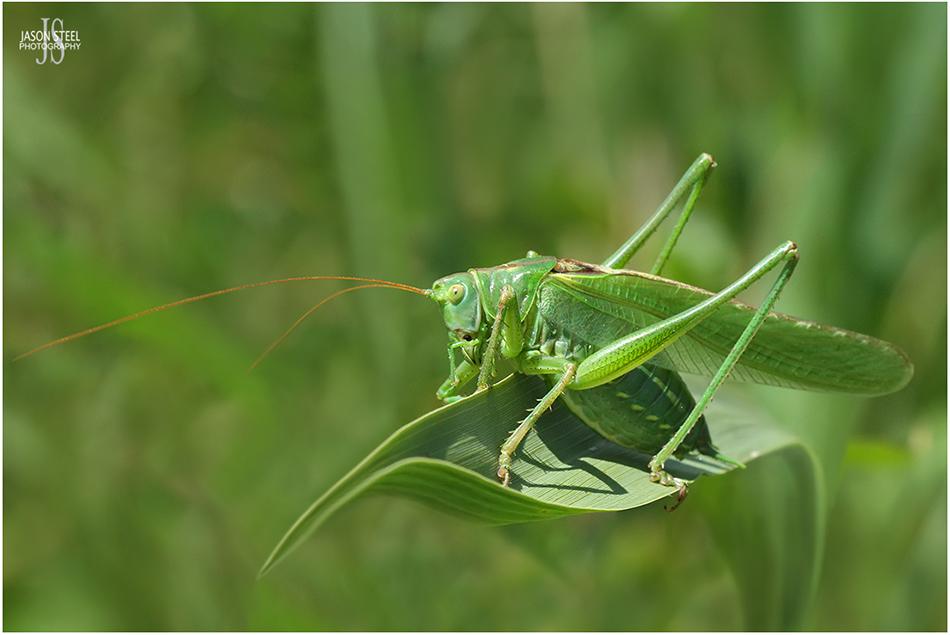
50mm male Great Green Bush Cricket (Tettigonia viridissima). One of several found on a marshland site in SE London, 20th July 2020.
Great Green Bush Cricket - (Tettigonia viridissima)
The Great Green Bush Cricket is a very large and unmistakable cricket growing to a length of 70mm, making it by far the largest cricket in the UK. They're bright green in colour with a rustic brown stripe running the length of their back, and orange antennae. Adults develop lengthy wings which males use to rub together producing a long and continuous song to attract the females. Despite their bright colour and large size these crickets are excellently camouflaged amidst the reeds and long grass on the grassland and marshland sites where they are found in Southern England and Southern Wales, usually between May and October. Occasionally this species can be yellow in colour or green with yellow legs.
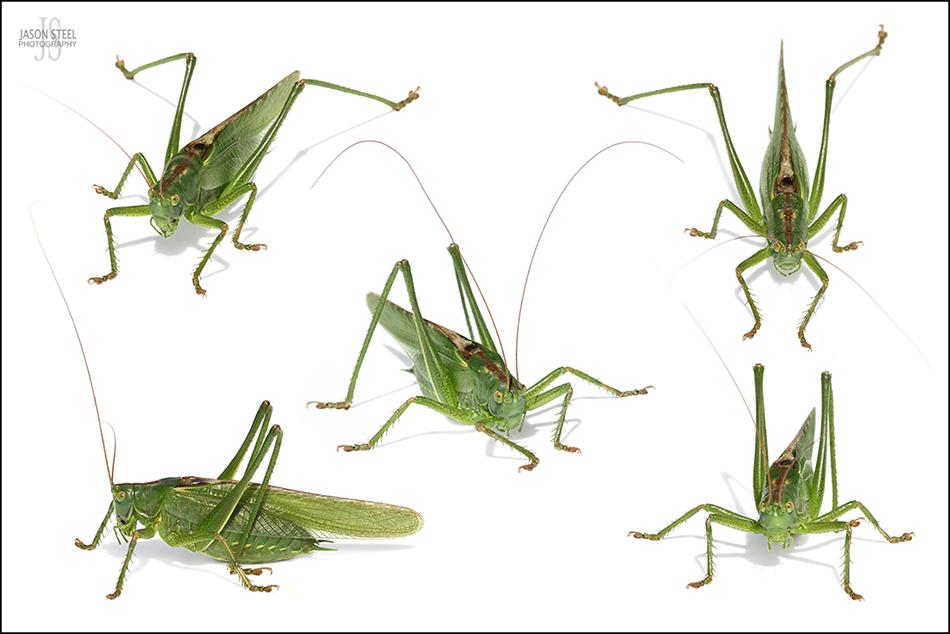
50mm male Great Green Bush Cricket (Tettigonia viridissima).
The female Great Green Bush Cricket has a slightly down-turned ovipositor which it uses to deposit eggs in loose, dry soil. Adults feed on both vegetation and other insects.
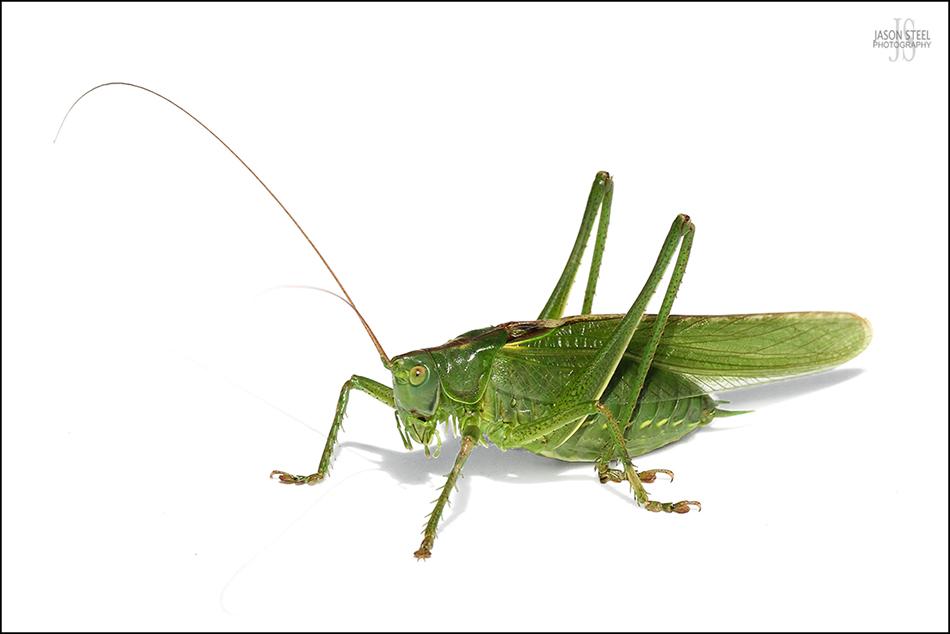
50mm male Great Green Bush Cricket (Tettigonia viridissima).
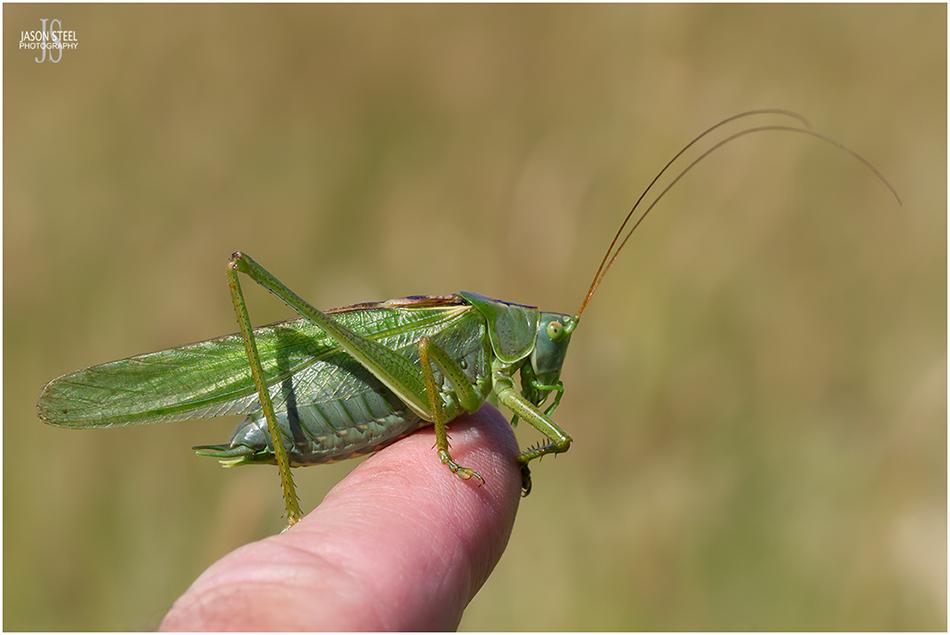
50mm male Great Green Bush Cricket (Tettigonia viridissima). One of several found on a marshland site in SE London, 20th July 2020.
These large crickets have a reputation of giving a painful nip when handled but thankfully this one was well behaved.
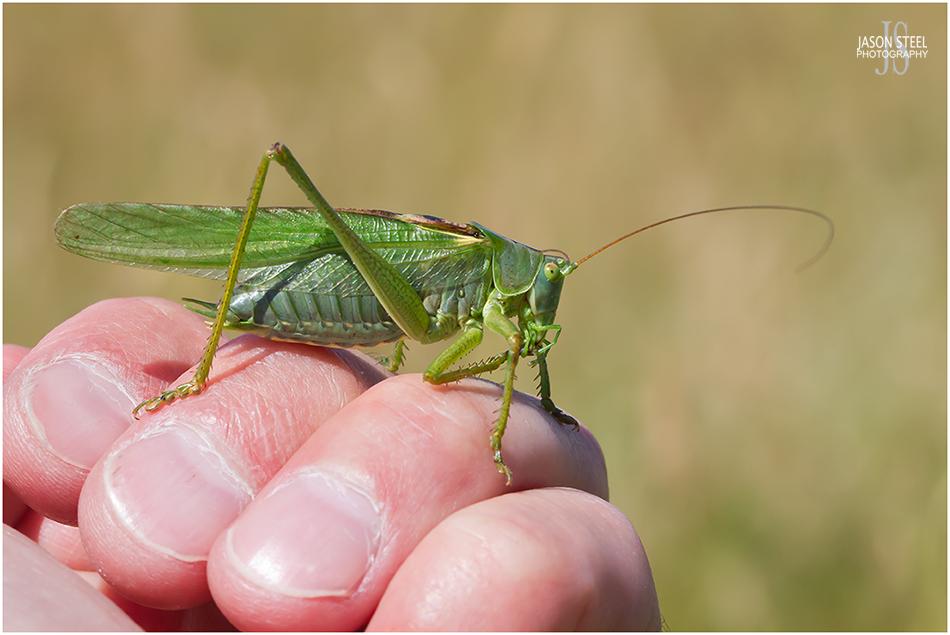
50mm male Great Green Bush Cricket (Tettigonia viridissima). One of several found on a marshland site in SE London, 20th July 2020.
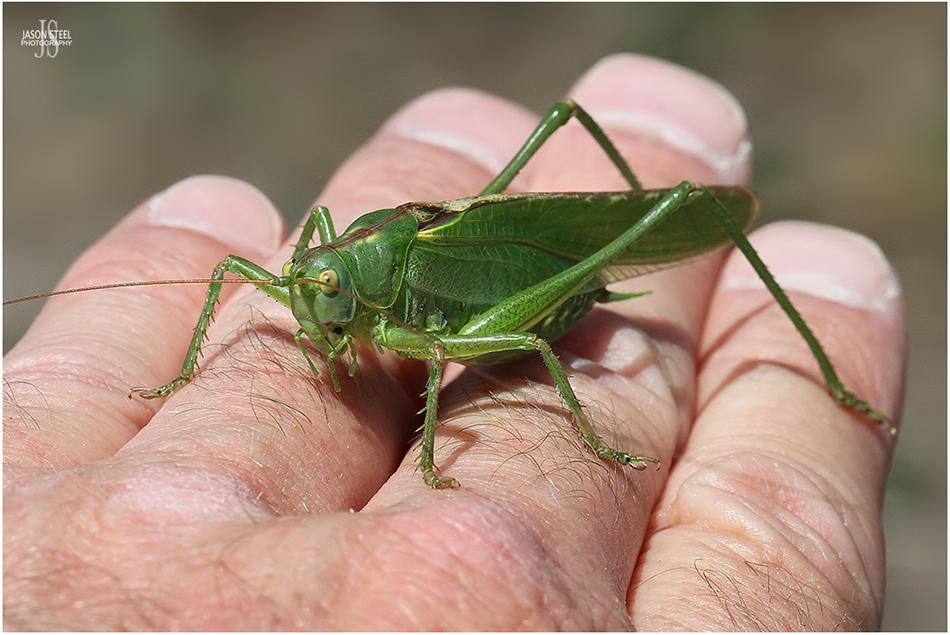
50mm male Great Green Bush Cricket (Tettigonia viridissima). One of several found on a marshland site in SE London, 20th July 2020.
The long and continuous call of the male Great Green Bush Cricket.
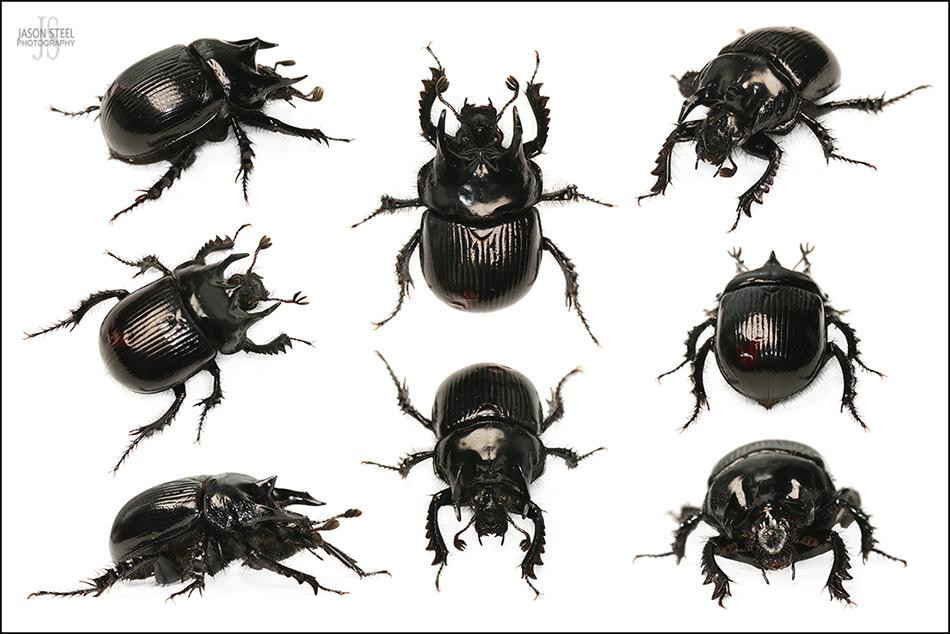
16mm male Minotaur Beetle, found wandering on sandy soil at Studland Heath, Dorset, 13th September 2021
Minotaur Beetle - (Typhaeus typhoeus)
The Minotaur Beetle is a large, glossy-black dung beetle that grows from 12-24mm in length. In the UK there are 8 species in the Geotrupidae family of Dor Beetles, including the unmistakeable Minotaur Beetle, Typhaeus typhoeus. Minotaur Beetles can easily be distinguished by the presence of three large horns found on the male, or by two small pointed corners of the female's pronotum. Males use these horns to defend their burrows and to compete with other males for mating rights. Although widespread in England and Wales the Minotaur Beetle has a very scattered distribution and is considered scarce. In Scotland and Ireland they are very rare with just a handful of sightings. The preferred habitat is heaths and moors with short, often grazed grass, with dry sandy soil and an abundance of dung, preferably rabbit pellets. The Minotaur Beetle is Britain's only species of dung-rolling beetle, and although the dung is often dragged back to the burrow, males can sometimes be seen rolling the rabbit pellets.
The adult beetles emerge in Autumn and quickly begin their feeding frenzy to reach maturity. In mild years pairing up and mating can begin in November and December. Once mating has taken place both the male and female will begin digging their burrow, which is about 15mm wide and may be as deep as 100-150cm. The burrow will consist of up to 15 chambers, each containing a single egg. All other species of Dor Beetle in the UK dig their burrows right next to sources of dung, and to a far shallower depth of 5-60cm. The male Minotaur Beetles are the primary gathers but both sexes may help to gather dung, which is usually rabbit pellets. Dung of other herbivores such as horses, sheep and cattle is also used if necessary. The female will shape and distribute the dung to each chamber in the burrow, or to a mass that is accessible by each chamber. Males are the sex most commonly seen above ground, especially after rain, when rabbit pellets are soft and easily shaped by the female. If the male is killed whilst above ground then the female will take on his role as the sole gatherer of dung. During the coldest months adult beetles will overwinter in the burrow whilst it is still under construction, and can emerge again as soon as the surface soil isn't frozen. Burrows are usually fully completed, and stocked with dung, around June or July, and both adult beetles die shortly after.
The larvae develop rapidly over a year and pupation occurs at the end of the following summer, with the newly emerged beetles coming above ground for the first time around September. New teneral Minotaur Beetles may exhibit red colouration, which usually fades to black quite quickly. The entrance to their burrows can often be found on short turf and consists of a small mound of excavated soil with a 15mm hole on the surface.
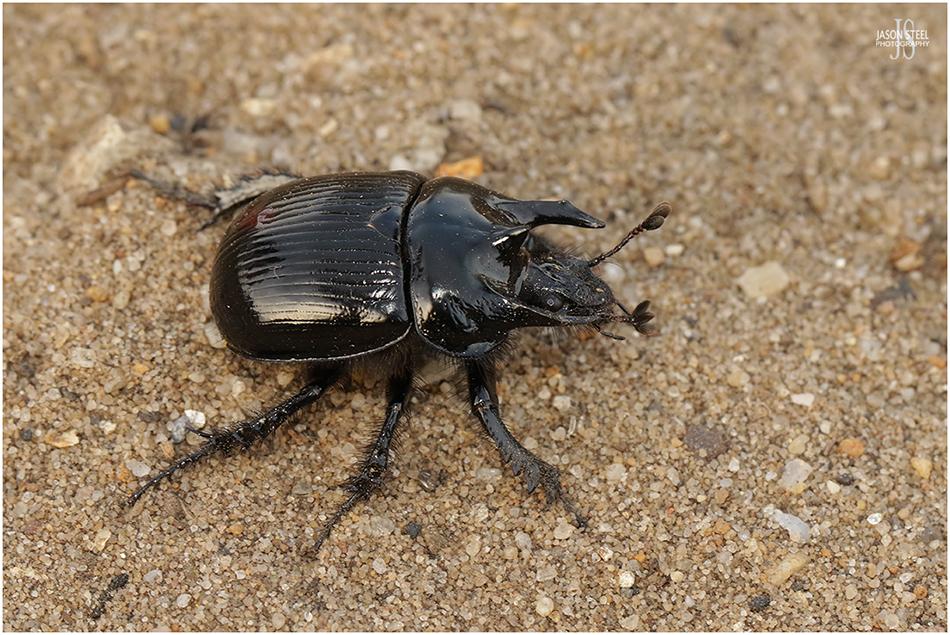
16mm male Minotaur Beetle, found wandering on sandy soil at Studland Heath, Dorset, 13th September 2021
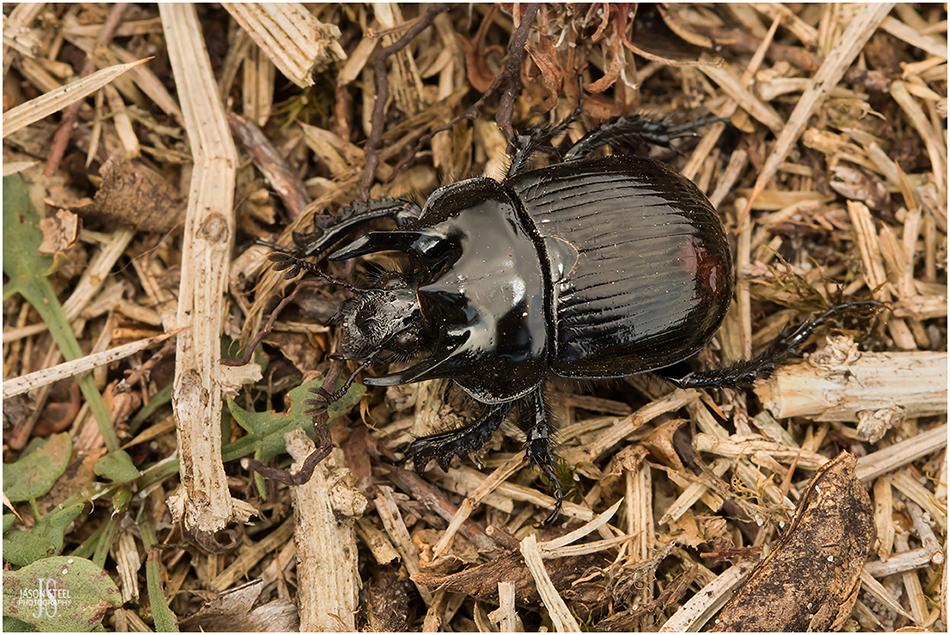
16mm male Minotaur Beetle, found at Studland Heath, Dorset, 13th September 2021
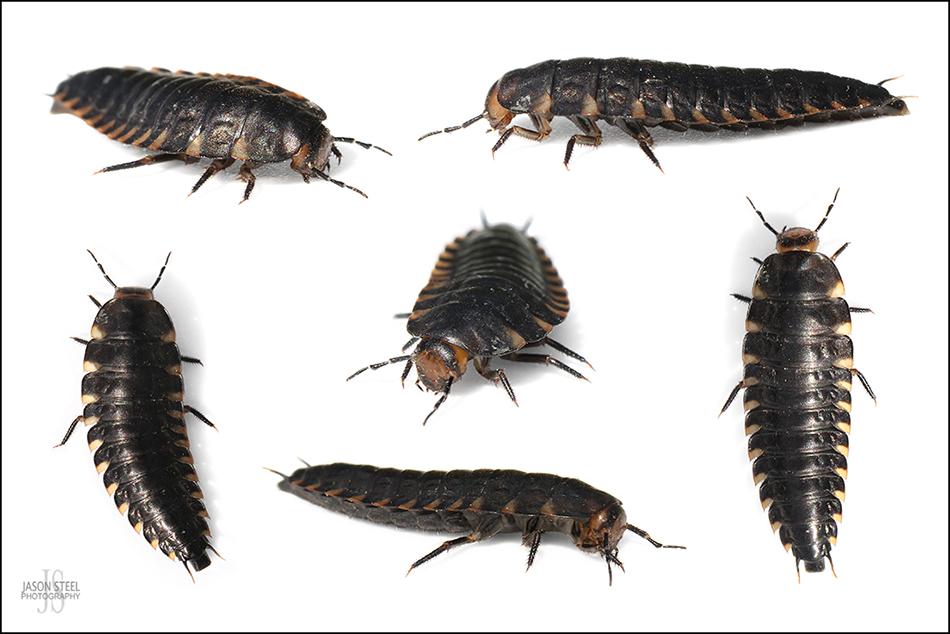
20mm Carrion Beetle larvae (Silpha tristis) found under a dumped mattress on a wetlands site in SE London, 29th June 2020.
Large Carrion Beetle - (Silpha tristis)
There are 21 species of Carrion Beetle recorded in the UK, and are members of the Silphidae family, consisting of Carrion, Burying and Sexton Beetles. These beetles play an important role in the tidying process of nature by feeding from the dead corpses that would otherwise litter our countryside. Many can be found in both adult and larval form feeding from the carcass of dead invertebrates. Silphidae are often referred to as Large Carrion Beetles to distinguish them from other families of smaller beetle that are often found around carrion. Most species of Silphinae are found on carrion where they live and breed and where the larvae will develop. Alternative food sources are sometimes used by some species including Oiceoptoma thoracicum, which also feeds on decaying fungi, compost and dung. In addition to eating carrion a few species are also predatory, Phosphuga atrata and Silpha laevigata will also hunt snails and Dendroxena quadrimaculata hunts caterpillars.
Seven species of Carrion Beetles are regularlyattracted to light, and can be caught in moth traps, including the following species: Nicrophorus vespilloides, Nicrophorus investigator, Nicrophorus humator, Nicrophorus vestigator, Nicrophorus vespillo, Nicrophorus interuptus, and Necrodes littoralis. Most of the species attracted to light are from the Nicrophorus genus which are commonly referred to as Sexton Beetles, or Burying Beetles, due to their habit of burying small vertebrate carcasses.
The Silpha tristis Carrion Beetle is fairly widespread in England and Wales and is usually found on coastal sites and areas with sandy soil. The larvae resemble a large black woodlouse, but with only six legs. The larvae take 6-8 weeks to develop before pupating for a further 2-3 weeks and then emerging as adult beetles. The adult beetle is uniformly greenish black in colour and has a body-length of 13-17mm.
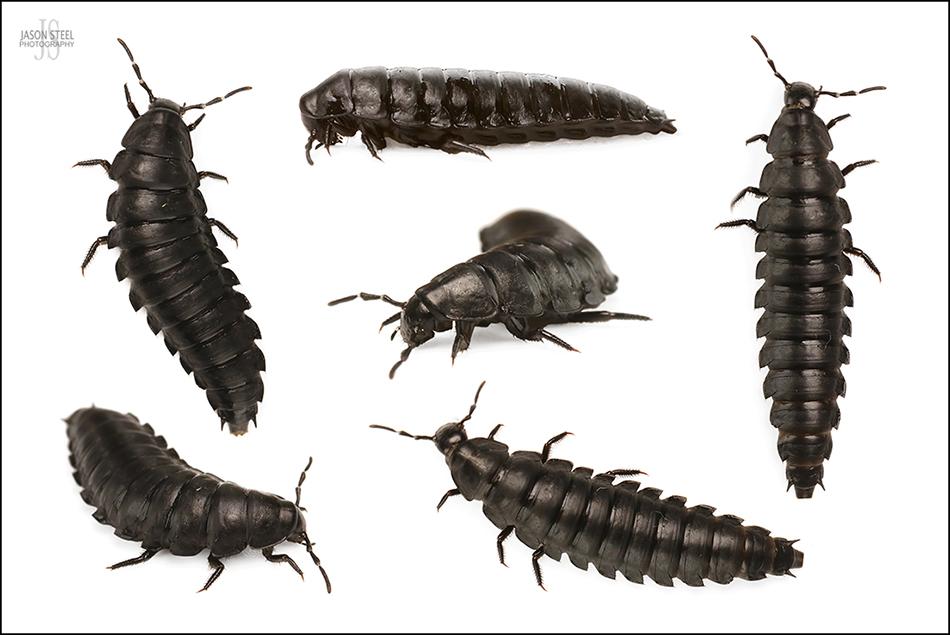
14mm Carrion Beetle Larvae (Phosphuga cf atrata) found in long grass at Corfe Castle, Dorset, 20th July 2021
European Carrion Beetle / Black Snail Beetle - (Phosphuga atrata)
Phosphuga atrata is the most common species of Carrion Beetle recorded in the UK. Adult beetles can be black, bronze or even a brownish red, and grow to a length of 10-15mm. Both adults and larvae feeding on dead animals but will also hunt live snails and earthworms too. Adult beetles live for several years and do not fly. Dispersion occurs by walking, which they do slowly. They prefer damper habitats but are regularly found in parkland, gardens, woodland, bogs and coastal dunes. The larvae are almost identical to the larvae of Ablattaria laevigata larvae, but the two species can be separated at the larval stage by close inspection of the urogomph, which are the two appendages at the rear.
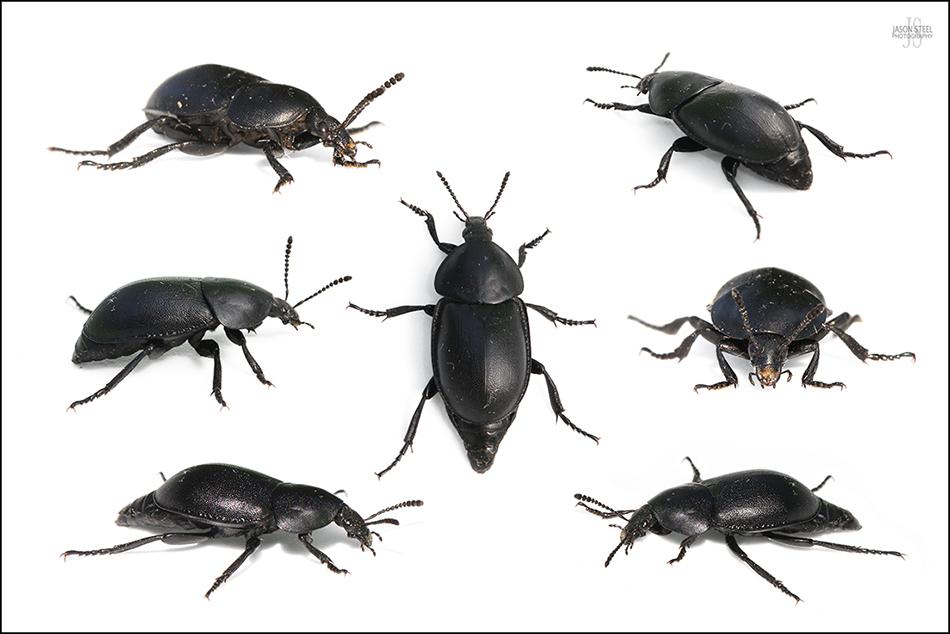
15mm Snail Hunting Carrion Beetle found under a log on grassland in Murston, Kent.
Snail Hunting Carrion Beetle - (Silpha laevigata)
A medium-sized Carrion Beetle growing to around 12-18mm in length. Silpha laevigata typically feeds on carrion but will readily predate snails too. It can be found in various habitats and although many sightings are coastal this species is often found inland too. They are more frequently encountered in the southern half of England during the summer months. This species can be easily distinguished from other Sipha species by the absence of any raised longitudinal lines on the elytra.
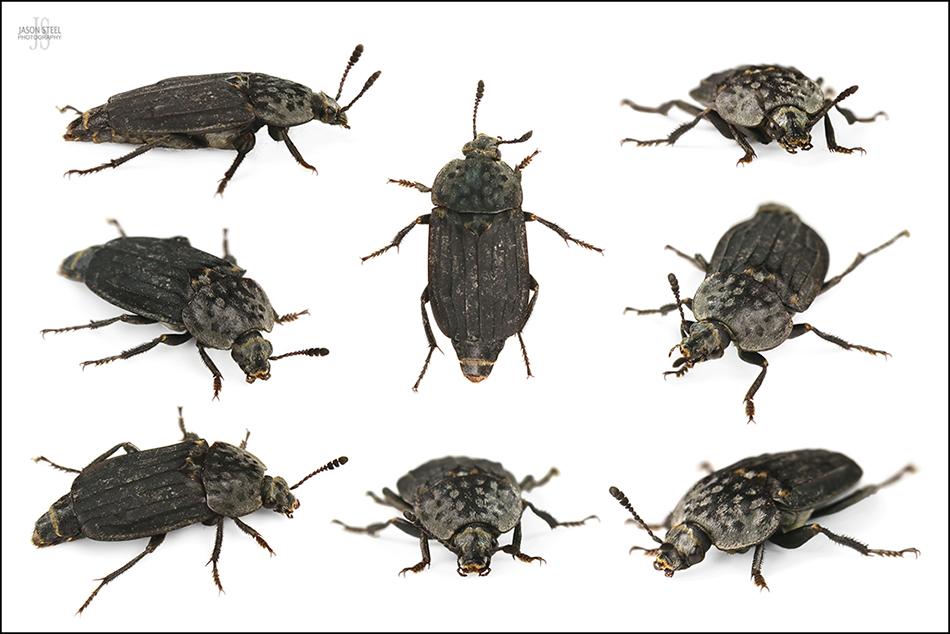
15mm Carrion Beetle found under a dead mole on Rainham Marshes, Essex, 23rd June 2021
Smooth Death Lover Carrion Beetle - (Thanatophilus sinuatus)
A medium-sized Carrion Beetle usually growing to around 10-14mm in length, sometimes larger. A widespread and locally common species of Carrion Beetle in the UK. They have been recorded throughout England but most frequently in the SE. The name Thanatophilus translates to "Lover of the dead"! Both adult and larval stages feed on the dead bodies of vertebrates and can be found feeding on all stages of decaying carrion. In Europe Thanatophilus sinuatus is one of the most common species of Carrion Beetle, where it is frequently found on human remains. The study of these beetles is helping to further the knowledge of forensic science to be used in criminal investigations. This was discussed in the Journal of Medical Entomology, Vol 58, Issue 3, May 2021.
Thanatophilus sinuatus are very similar in appearance to the slightly smaller Thanatophilus rugosus, however the two can be separated from good quality images by the presence of a very small tooth seen on the shoulders of the elytra (wing-cases). Thanatophilus sinuatus also have less textured and patterned elytra. Thanatophilus dispar is also similar but has extensive pubescence (tiny hairs) seen on the elytra. Pubescence only occurs at the base of the elytra of Thanatophilus sinuatus. The underside does show pale yellowish-gold pubescence on Thanatophilus sinuatus.
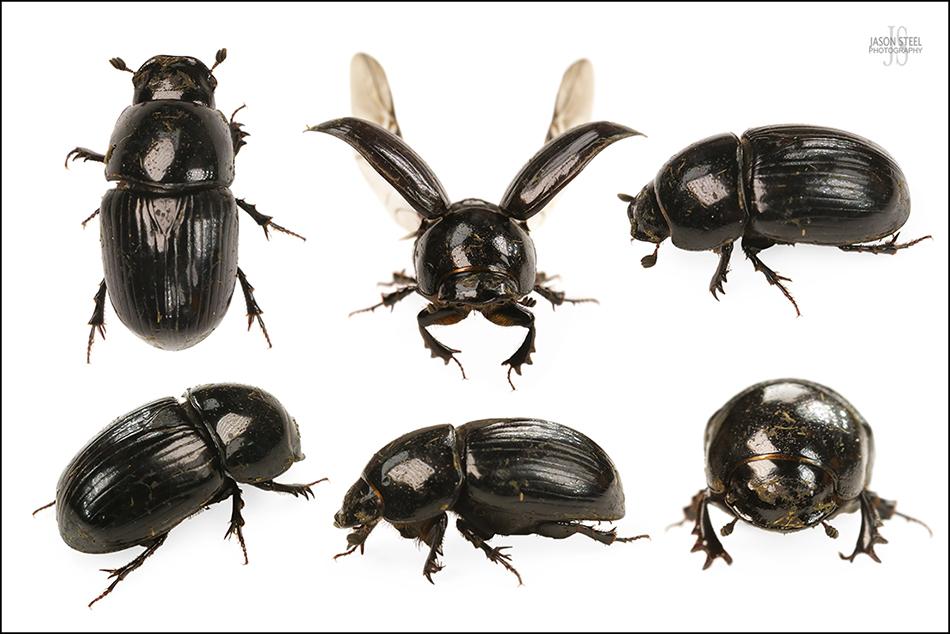
10mm Small Dung Beetle, Teuchestes fossor. One of many found in horse manure at Ashdown Forest, East Sussex, 22nd May 2022
Small Dung Beetle - (Teuchestes fossor, previously Aphodius fossor)
Teuchestes fossor is a common species of Dung Beetle that's usually found in wet horse or cow manure. Although still a fairly small beetle, this is the largest of the Aphodiine Dung Beetles, of which there are currently 46 species in the UK. Aphodiinae is a subfamily of the Scarab Beetle family, Scarabaeidae. Members of this subfamily, Aphodiinae, are known as the Small Dung Beetles.
Teuchestes fossor grows to a body-length of 9-13mm. Females tend to be slightly larger than the males. This species can be identified not only by its size, but also by the length of its scutellum. The scutellum is the triangular, or shield-shaped, scale behind the pronotum and between the bases of the elytra. The scutellum on all other Aphodiine Dung Beetles is considerably smaller. is usually entirely black in colour, although occasionally it may have a slightly blue sheen from certain angles. The elytra can sometimes be red in colour, which makes the elongated black scutellum even more obvious.
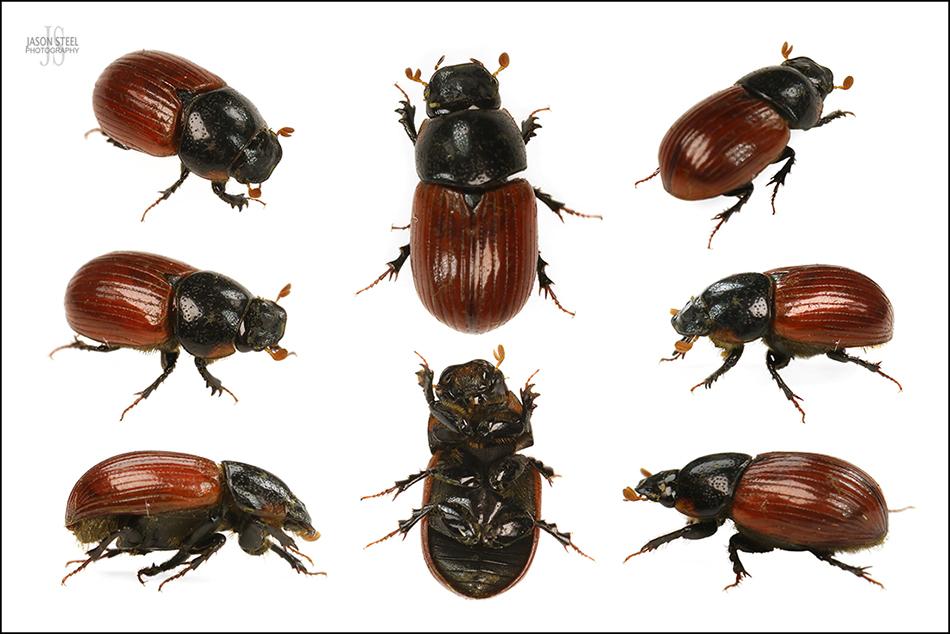
5mm Small Dung Beetle, Aphodius cf fimetarius. One of many found in horse manure at Ashdown Forest, East Sussex, 22nd May 2022
Red Dung Beetle - (Aphodius fimetarius)
Aphodius fimetarius is a common species of Dung Beetle that dwells in the dung of herbivorous species, including cows and horses. Adult females can reach around 6-8mm in length, and males slightly less. The peak period for sightings is from April through to October. Aphodius fimetarius is very difficult to distinguish from the similar Aphodius pedellus. These Small Dung Beetles mature quite quickly. It takes on average just 67 days from the time an egg is laid to the time an adult beetle emerges from its cocoon. Adult beetles are diurnal and fly in the daytime.
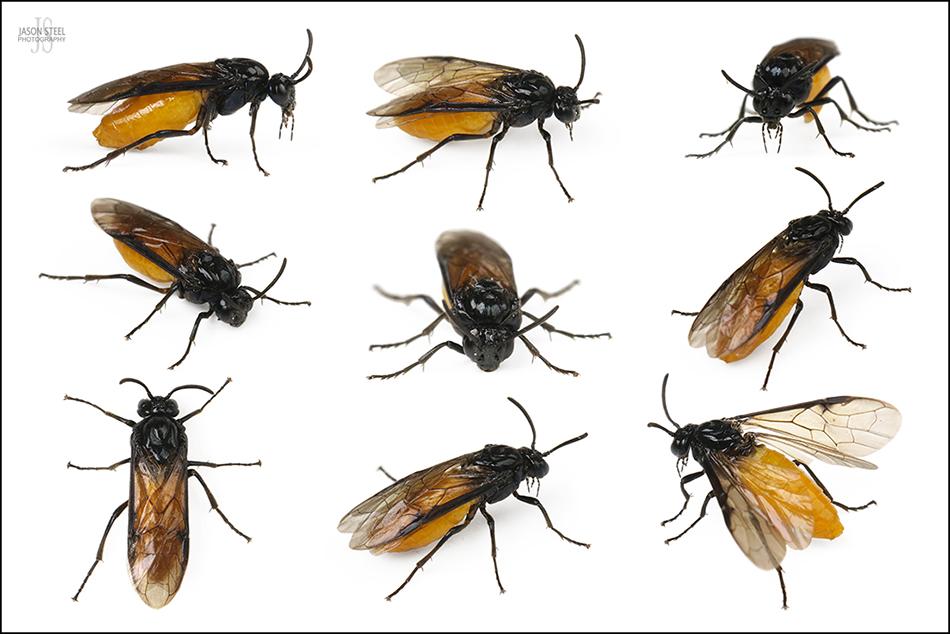
Rose Sawfly (Arge pagana) from my SE London Garden, 20th June 2021
Large Rose Sawfly - (Arge ochropus / pagana)
Rose Sawfly are black in colour with a yellow / orange abdomen and grow to around 10mm in length as adults. The larvae feed on both wild and cultivated roses and can cause considerable damage to smaller rose plants. The adult uses its saw tail to cut a slit in the stem of the rose plant and lay its eggs. As the larvae grow the stem splits open. The larvae emerge and immediately start feeding on the leaves on the rose plant. Larvae can grow to 20-25mm in length. The larvae of both species Arge ochropus / pagana are very difficult to distinguish, but in adult form the two species can be separated by the "stripy socks" found on Arge ochropus .
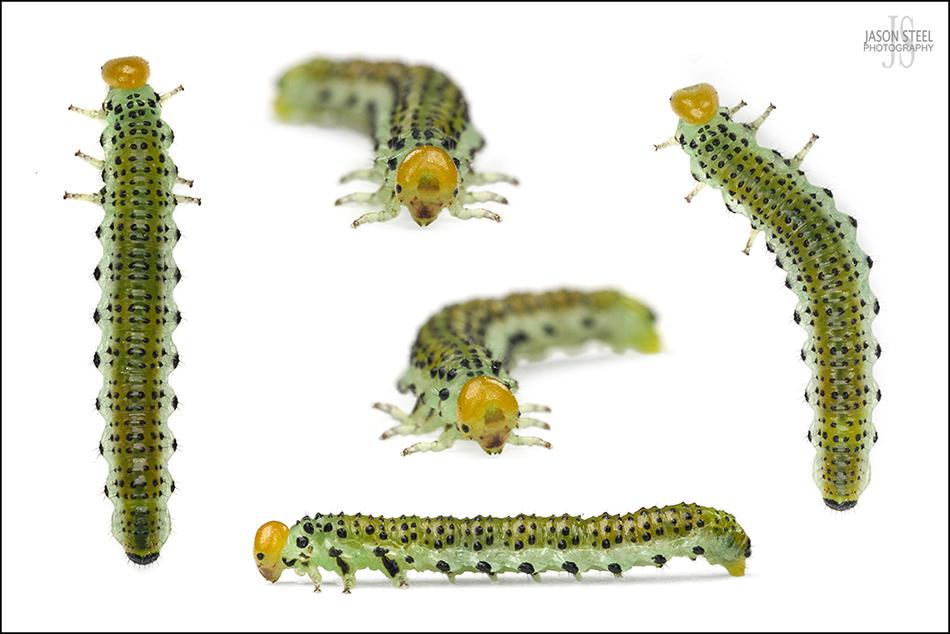
Large Rose Sawfly larva - (Arge ochropus / pagana)
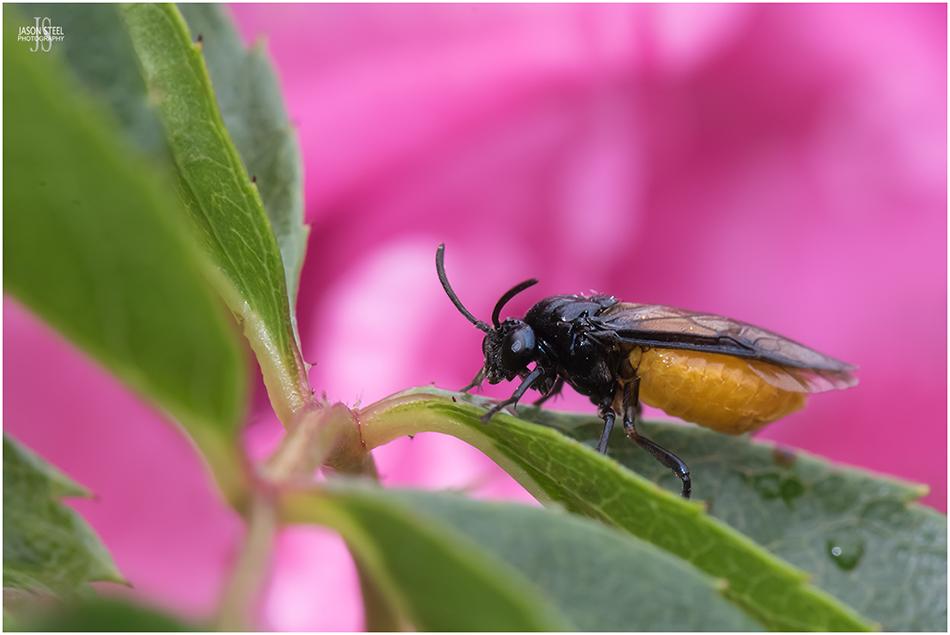
Large Rose Sawfly (Arge pagana) from my SE London Garden, 20th June 2021
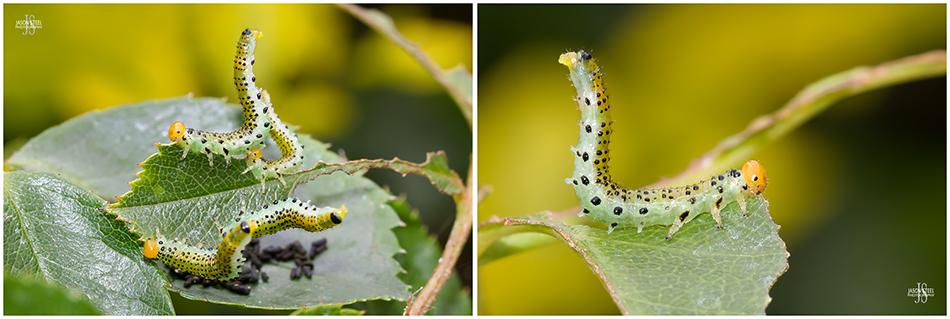
Large Rose Sawfly feeding on the leaves of roses in my SE London Garden, 7th July 2019
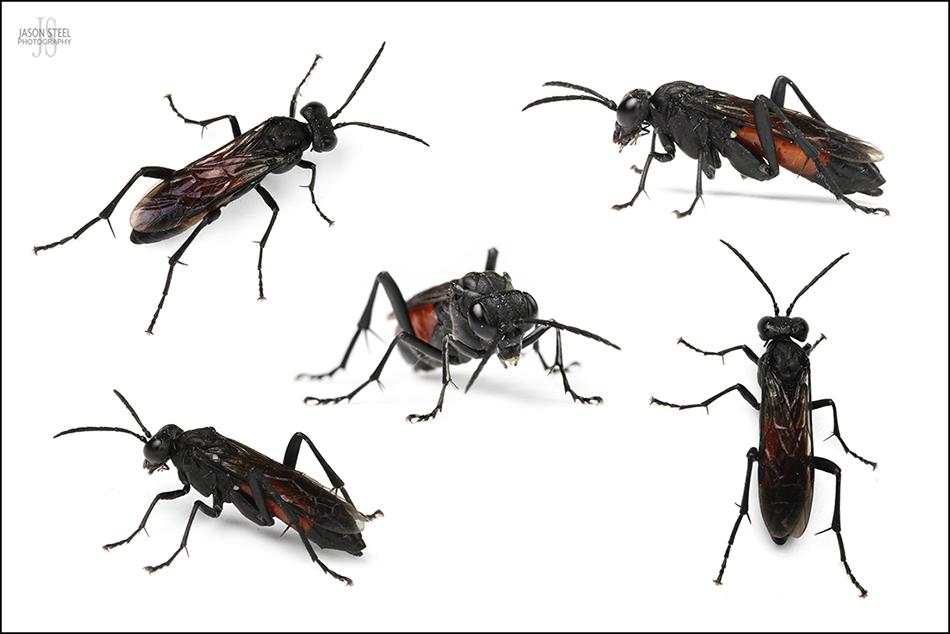
Sawfly (Macrophya annulata) found wandering on Strawberry plants in my garden in SE London, June 2020.
Sawfly - (Macrophya annulata)
Macrophya annulata is a spider-hunting wasp-mimic and can often be seen at ground level. They usually grow to a length of 11-12mm and are widespread across the UK. Adult forms can be found in May-June. The larvae feed on Rose and Blackberry. Sawflies have short adult lives and usually only survive for 7-10 days as adults. Many sawfly resemble species of wasp but lack the narrow waist typically associated with wasps. Most species of Sawfly are plant feeders although a few are parasitic.
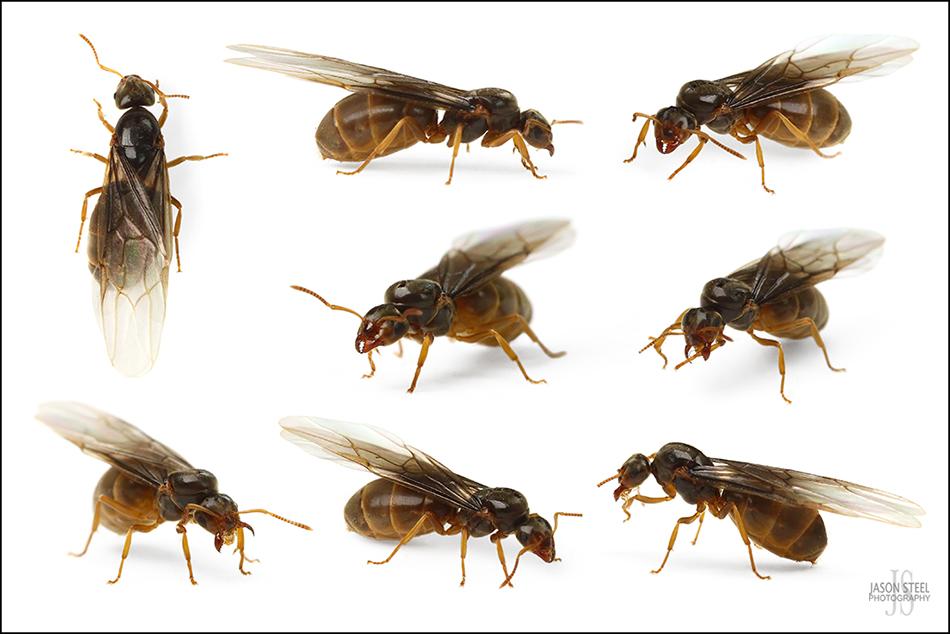
10mm Black Garden Ant queen - photographed 15th September 2019 in SE London
Black Garden Ant - (Lasius niger)
The Black Garden Ant, or Common Black Ant, is the most common of the 60 species of ant found in the UK and they can also be found across most of Europe, North and South America, Asia and Australia. Queens can grow to over 15mm in length whilst female workers are usually around 3mm, but sometimes up to 5mm. Workers are black in colour whilst queens are far browner. The Black Garden Ant lives in a colony consisting of a queen and up to 15,000 female workers. The workers tend to the queen and the larvae and also gather food for the colony. The colonies are built in dry soil which is usually positioned in a spot where it is warmed by the sun. This can be in lawns or flowerbeds, but under heavy items such as paving slabs is the most regular choice of location.
When the colony has reached its maximum capacity the queen starts to give birth to new virgin winged queens known as princesses, and flying males known as drones. The princesses are larger than the drones and considerably larger than the female workers. When conditions are right the flying ants will swarm and leave the colonies in search of partners from other colonies to mate with. The queen will give birth to large numbers of these winged forms of ant, known as alates, but most will be eaten by birds and never get the opportunity to build new colonies.
The males will only live very short lives of around one week and die soon after mating. The new queens will usually mate with several different males before they begin their search for somewhere to start a new colony. They will then chew off their own wings and live the rest of their lives as terrestrial ants. During their mating period the queen will have stored enough sperm from the males to allow her to lay thousands of eggs over her 15 year lifespan. In captivity some queens have lived for 28 years!
Once a suitable location has been found the queen will start building an underground chamber where she will lay her first eggs. She will not feed again for several weeks until her offspring are reared and able to leave the colony and set off to forage for food for her. When a foraging worker ant finds a source of food it will carry what it can back to the nest whilst leaving a pheromone scent trail allowing other worker ants to follow her footsteps to the food source. The Black Garden Ant is the only species of British ant that regularly ventures into human homes.
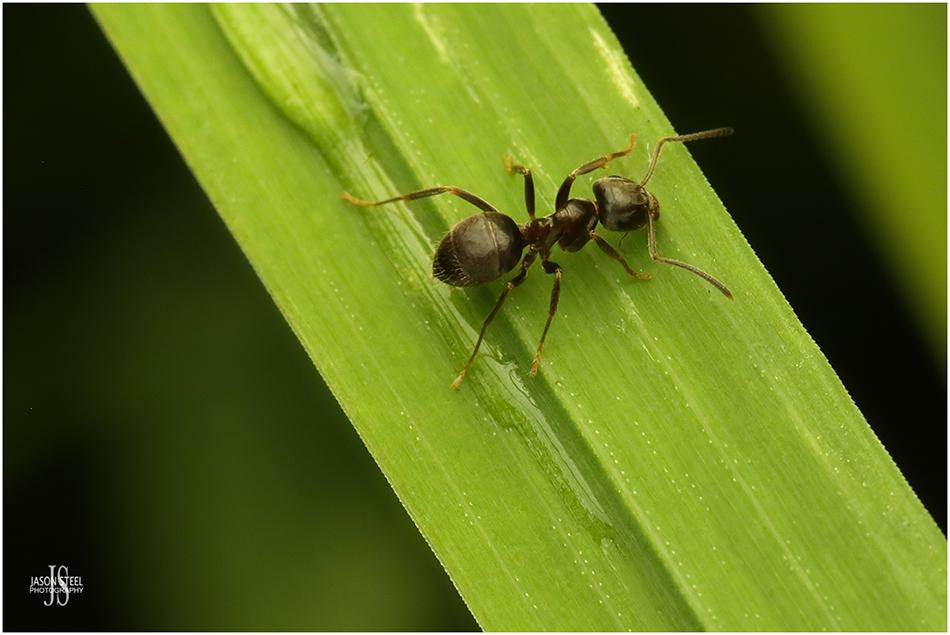
4mm Common Black Ant female worker (Lasis niger sensu lato / Lasis niger agg.), photographed in my SE London garden, 23rd May 2022.
The dark Lasius species of ant can be difficult to separate. In these photos you can see the standing hairs on the scapes of the ant, and this narrows identification down to either Lasis niger or Lasis platythorax. The term "Common Black Ant" covers both these two species and they would they need microscopic examination of the clypeus to separate. LINK
Lasis platythorax prefers cooler and damper conditions compared to Lasis niger. Whilst Lasis niger is commonly found in parks and gardens Lasis platythorax seems to avoid human habitation and is more likely to be found on damp heaths or woodlands. LINK
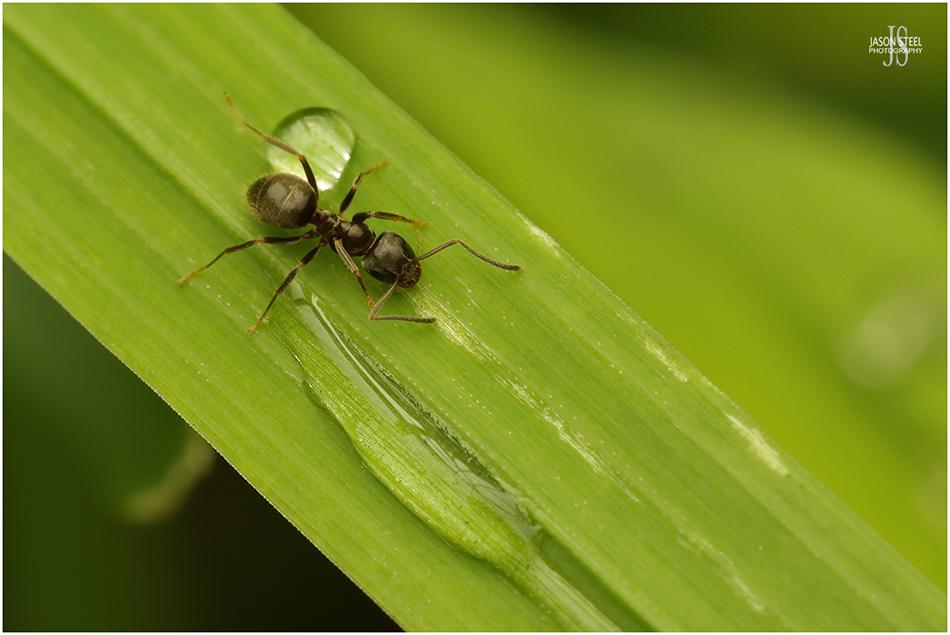
4mm Common Black Ant female worker (Lasis niger sensu lato / Lasis niger agg.), photographed in my SE London garden, 23rd May 2022.
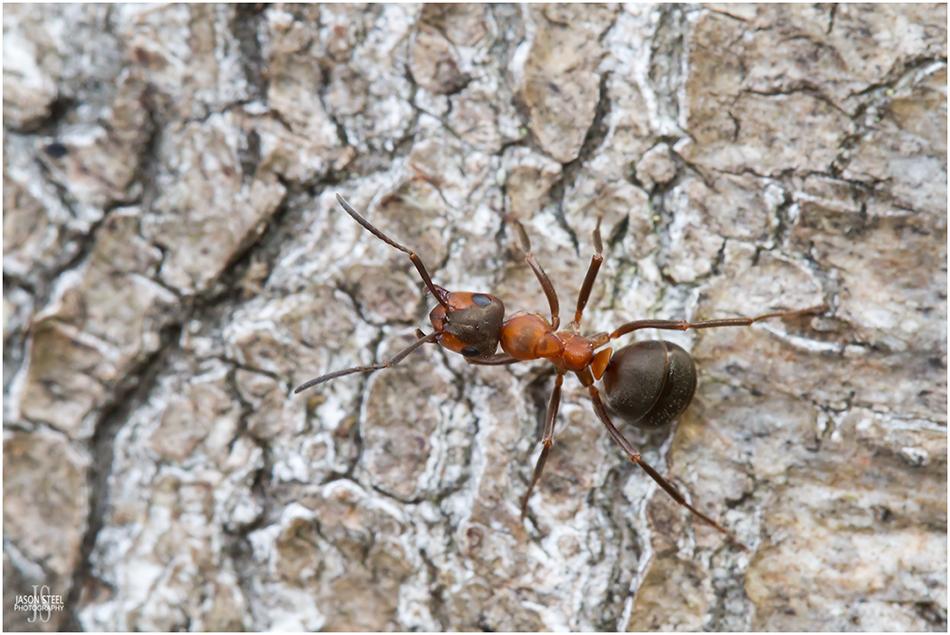
One of many Southern Wood Ants marching up and down a Silver Birch Tree at Crooksbury Common, Surrey. 24th July 2020
Southern Wood Ant (Formica rufa)
The Southern Wood Ant, or Red Wood Ant, as they are sometimes known, is the most common species of Wood Ant in the UK. Wood Ants are the UK's largest native ants with workers reaching 10mm in length whilst queens grow to 12mm in length. Like other Wood Ants they are an aggressive species with large, powerful biting jaws and the ability to spray formic acid in their defence. The Southern Wood Ant is most commonly associated with coniferous forests but they can also be found in deciduous forests consisting of large broadleaved trees too. They build large nests in warm, sunny clearings and woodland edges made from a mixture of soil, leaves, twigs and pine needles. These nests can consist of up to 400,000 workers and the colony can claim vast territories which it will defend from other ant species. Wood Ants will often hunt in tree canopies and can be seen in large numbers marching up and down tree trunks. If threatened by birds whilst in the tree the ants will take evasive action by dropping out of the tree and falling to the ground. Badgers are known to raid Wood Ant nests and can consume large numbers of ants and ant pupae.
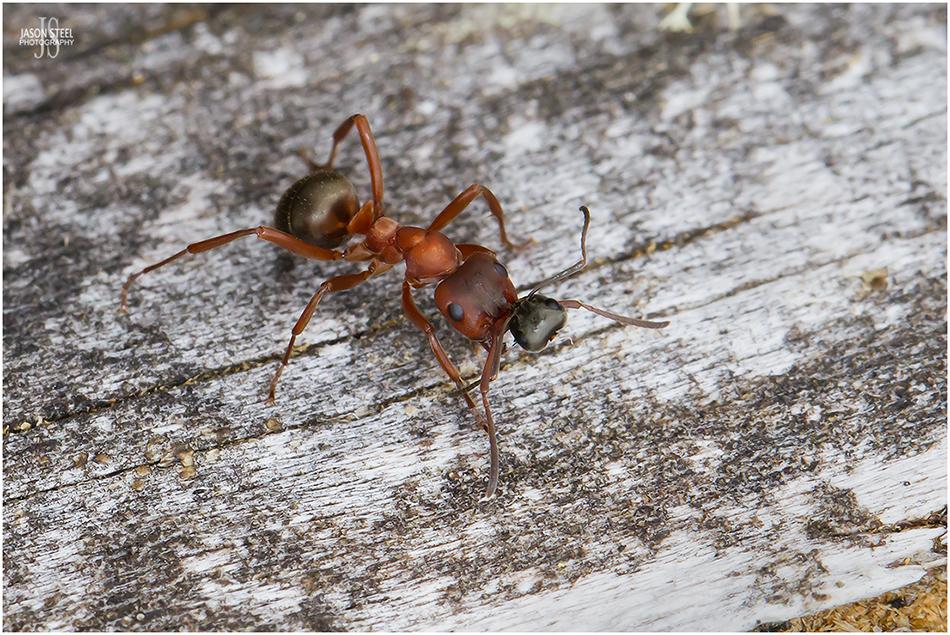
Southern Wood Ant with the head of a smaller ant species at Crooksbury Common, Surrey. 24th July 2020
Wood Ants can be very difficult to identify down to species level but one identifying feature of Formica rufa is the absence of tiny fringe hairs around the eyes and edges of the head which are present on other species of Wood Ant found in the UK. Wood Ants have been shown to protect their nests by incorporating tree resin into the structure of the nests. Tree resin is known to contain antimicrobial properties which when combined with the ant's own formic acid can shield the nest with powerful antifungal protection. Studies have also demonstrated that both Woodpeckers and Eurasian Jay's will land on nests of Wood Ants to provoke a defensive response from the ants which are quick to defend the nest by spraying the intruder with formic acid. The birds use this acid shower to rid themselves of mites and parasites. Wood Ants are sometimes deliberately introduced to forests as a form of biological pest control.
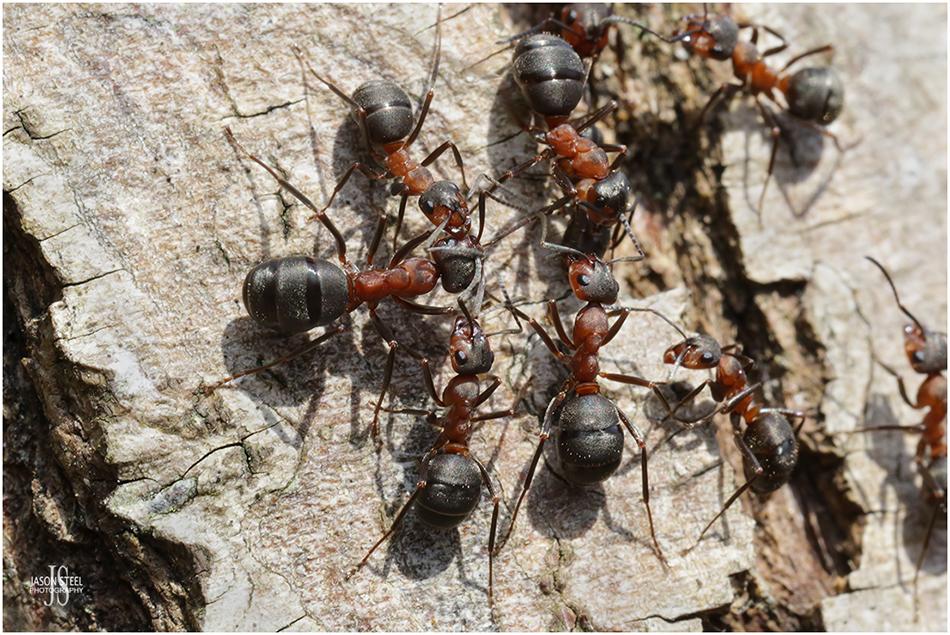
Southern Wood Ant at Crooksbury Common, Surrey. 9th April 2023.
These Southern Wood Ants were abundant everywhere at Crooksbury Common. They were particularly common on Silver Birch Trees, where they were probably collecting tree resin. As the ants passed each other, on the way up and down the tree, many of them seemed to stop and communicate with each other before continuing on their path.
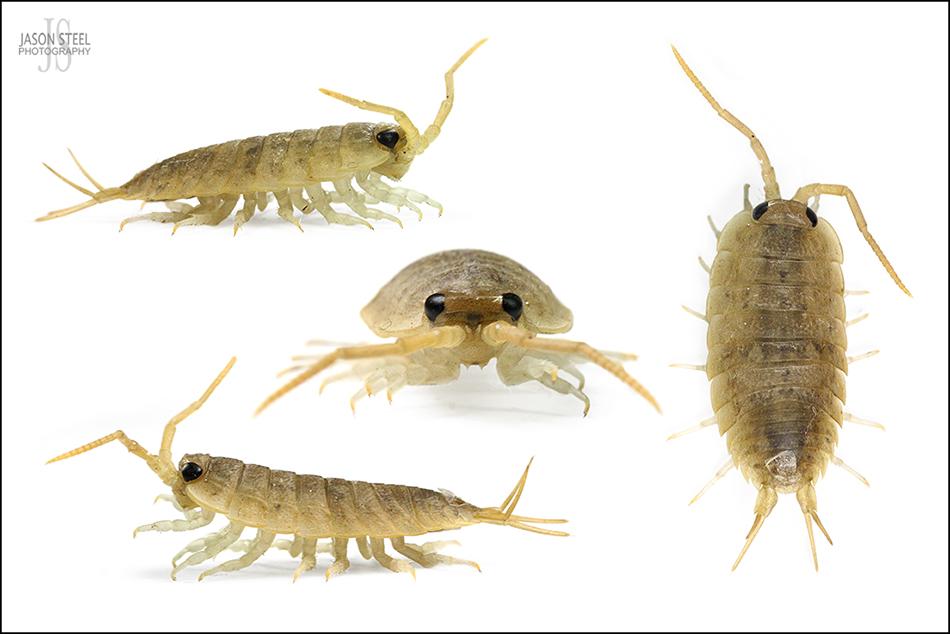
30mm Sea Slater - found under a rock along the edge of the River Thames, Thamesmead, SE London. 13th November 2019
Sea Slater - (Ligia oceanica)
The Sea Slater, sometimes referred to as the Sea Louse or Sea Roach, is a crustacean and a larger close relative of the woodlouse found in gardens. However this species is not found in gardens but instead found living under rocks and debris along the coastline all around Britain. Sea Slaters live for 2-3 years and are the largest of the oniscid isopods and grow to around 30mm in length. Like all members of the Woodlouse family Sea Slaters play an important role in the ecosystem as recyclers by feeding on decaying plant and animal material. During the daytime Sea Slaters hide away under rocks but they can be seen at night as they emerge and scavenge for rotting seaweed and other decaying matter at low tide. Sea Slaters are equipped with gills allowing them to breath underwater if necessary when the tide comes in, but they are primarily a land dwelling species.
In the UK we also have two other species of Water Slater that are entirely aquatic. However both Asellus aquaticus and Asellus meridianus are considerably smaller than Sea Slaters and grow to around 10mm. Both species of Water Slater are found in freshwater locations such as ponds, and slow moving streams.
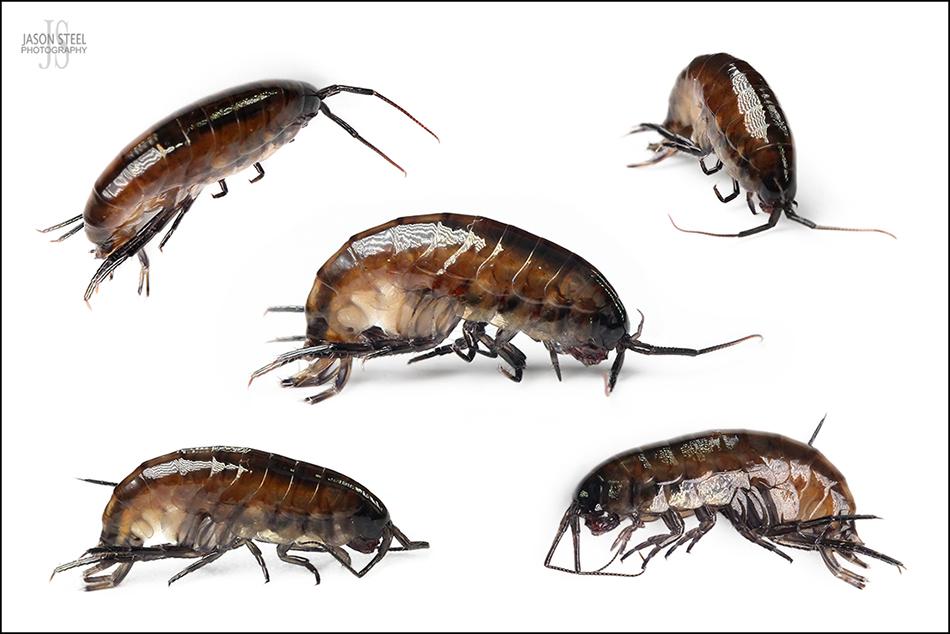
10mm Land Hopper playing dead - one of hundreds found under a log in oak woodland, SE London. 10th May 2020
Landhopper - (Arcitalitrus dorrieni)
The Landhopper has various common names including the Woodhopper, Lawn Shrimp and Australian Mud Shrimp. Landhoppers grow up to 10mm in length and along with Woodlice are the only totally terrestrial crustacean to be found in the UK. The Landhopper lives in dark, damp locations in gardens and woodland under rotting wood and leaf litter and feeds entirely on decaying plant matter. Landhoppers live in large groups and when disturbed they jump around using powerful abdomen contractions and releases. Their next line of defence is to play dead. Their visual appearance, as well as their jumping behavior, gives them a strong resemblance to a giant flea. Arcitalitrus dorrieni is considered rare in the UK and is generally confined to South West England and Southern Wales, with the exception of scattered and isolated sites across the UK.
There are various species of Landhopper found across the world but they are all found in the Southern Hemisphere. Arcitalitrus dorrieni has been in the UK since 1924 during Victorian times when it is believed to have accidentally been imported amidst tropical plants originating from Australia. As an invasive species it is encouraged for sightings to be recorded here.
Landhoppers shouldn't be confused with their cousin the Sandhopper (Talitrus saltator), which is similar in appearance and behavior but is found on coastal sites, often under wet sand and seaweed, but is a native species to the UK. Sandhoppers are paler in colour and larger in size than the Landhopper and can grow to around 20mm.
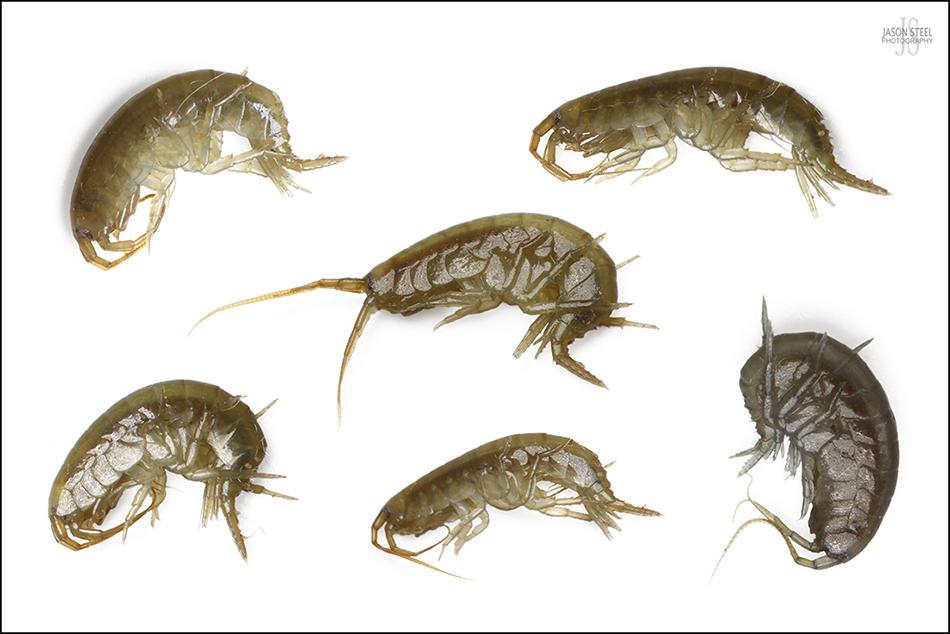
Various Sand Hoppers ranging from 8-12mm. Found under seaweed along the River Thames, SE London. 23rd August 2020
Sand Hopper - (Talitrus saltator)
Sand Hoppers, also known as Sand Fleas, are a native species of amphipod usually found amongst seaweed, debris and decaying algae left at the high water mark of coastal or brackish waters. During sunny days it will often bury itself up to 30cm beneath the mud or sand, emerging at night to feed. Sand Hoppers live for around 18-24 months and will grow to a length of around 20mm. During freezing temperatures Sand Hoppers will bury themselves to depths of around 50cm. Unlike their smaller and more colourful cousins, the Land Hopper, Sand Hoppers are dull grey to cream and sometimes green in colour. As with the Land Hopper these Sand Hoppers will briefly jump around like crazy when disturbed as they dash for cover. If captured they immediately play dead as shown in the image above. Sand Hoppers soon dry out and die if left exposed in the open and must remain in damp conditions. They play an important role in their ecosystem where they are an major source food to a huge number of fish and birds.
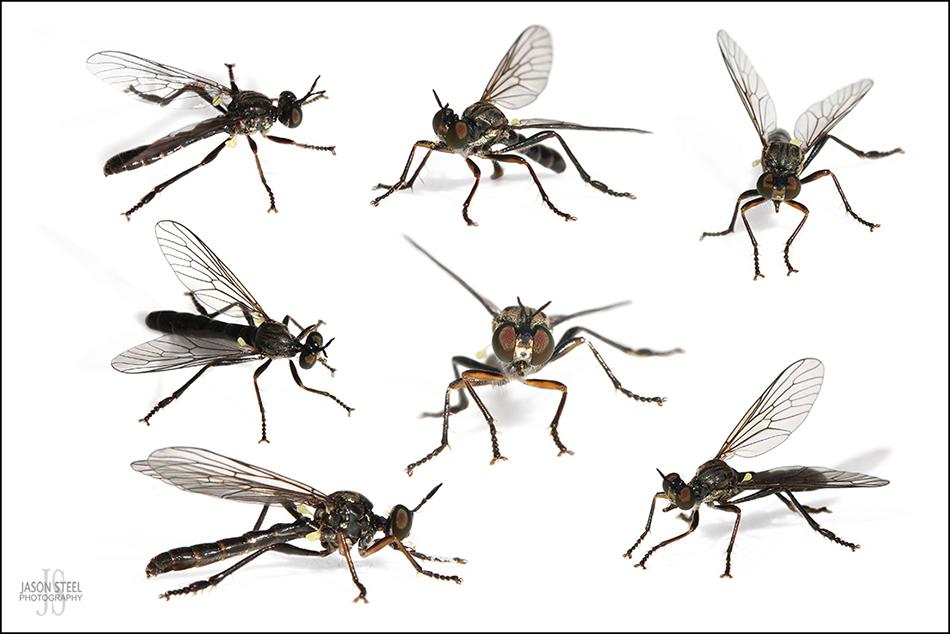
Male Stripe-Legged Robberfly photographed in my garden in SE London June 2019
Stripe-Legged Robberfly - (Dioctria baumhaueri, previously Dioctria hyalipennis)
There are around 29 species of Robberfly in the UK. Dioctria sp. are small species of Robberfly. The Stripe-Legged Robberfly has a body-length of around 8 - 13mm and is widespread and common throughout England and the East of Wales from May to August. These flies are predators feeding on smaller insects they catch either in the air or on the ground. Most Dioctria sp. are difficult to identify without very close inspection. The Stripe-Legged Robberfly is predominantly black in colour but the two pairs of front legs are orange with a dark stripe running the length of the upper surface.
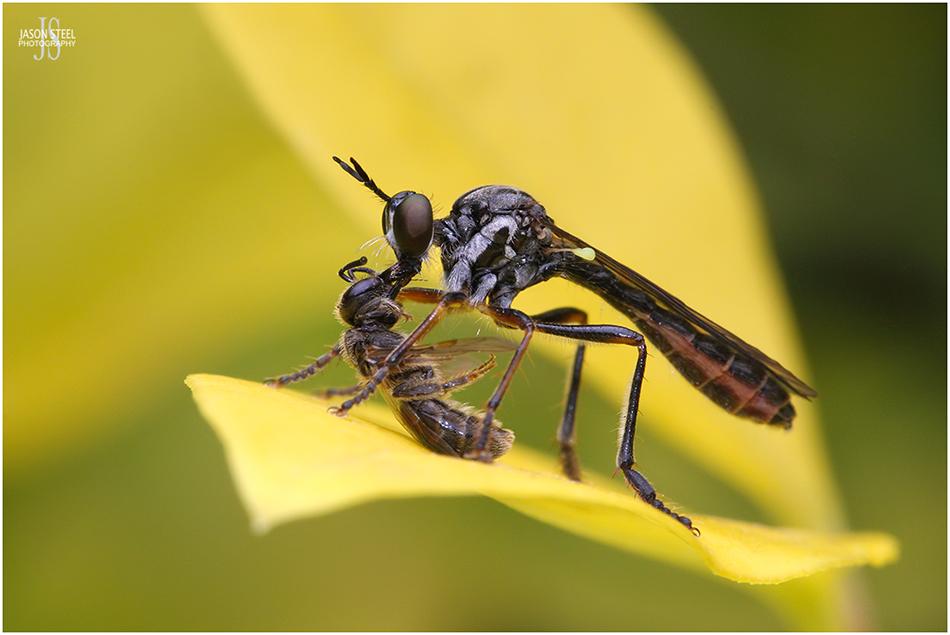
Stripe-Legged Robberfly with Solitary Bee prey, photographed in my garden in SE London 9th June 2020
As with other species of Robberfly Stripe-Legged Robberflies catch their victims with their long, powerful legs and proceed to stab the soft body parts of their prey with their piercing mouth-parts. The piercing mouth-parts then inject saliva containing both nerve toxins that paralyze the victim and enzymes that start to dissolve the victim's insides so they can be drunk.
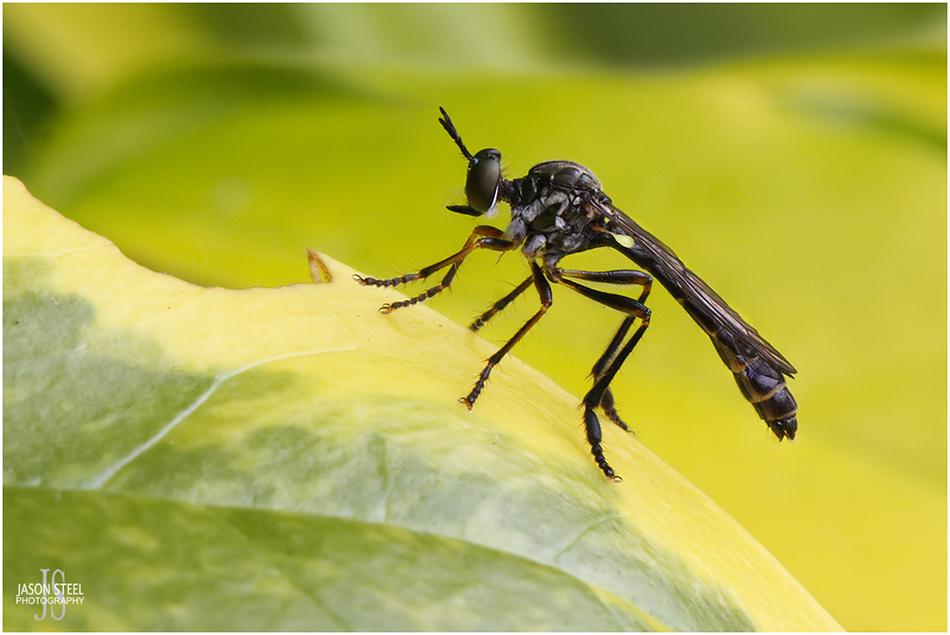
Stripe-Legged Robberfly photographed in my garden in SE London 28th June 2016
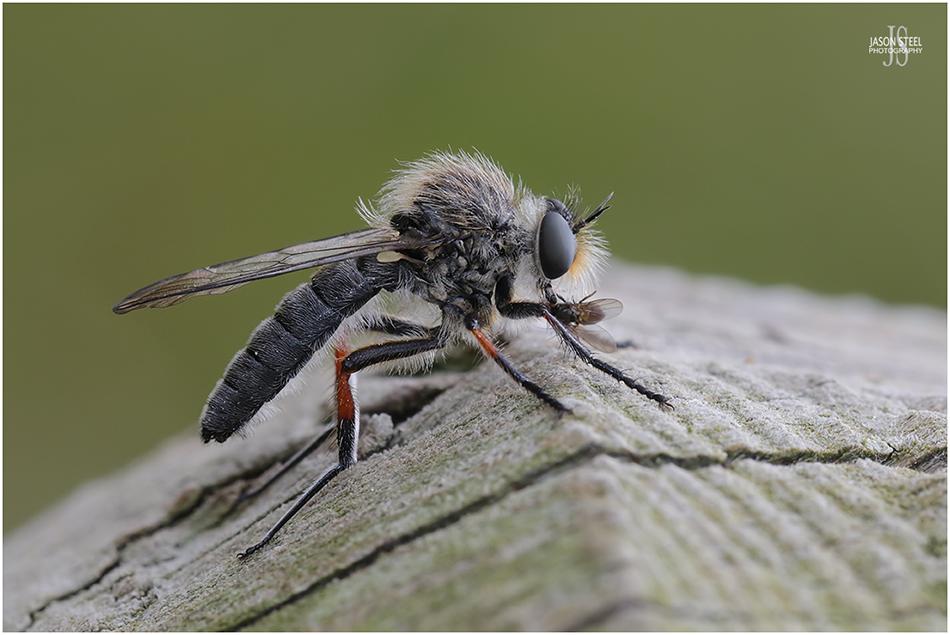
12mm Slender-footed Robberfly on a fencepost at Stonehenge, 28th June 2022.
Slender-footed Robberfly (Leptarthrus brevirostris)
The Slender-footed Robberfly is another small species of Robberfly that generally grows to a body-length of 7-12mm, with 10mm being the average size. They are typically grey in colour with black and orange legs and a very hairy thorax with a distinctively humped profile. This is a common and widespread species in the UK and adults can be seen from May until September. In the south and centre of England the Slender-footed Robberfly tends to favour dry chalk and limestone grassland sites. Further north the Slender-footed Robberfly also uses more acidic woodland habitats.
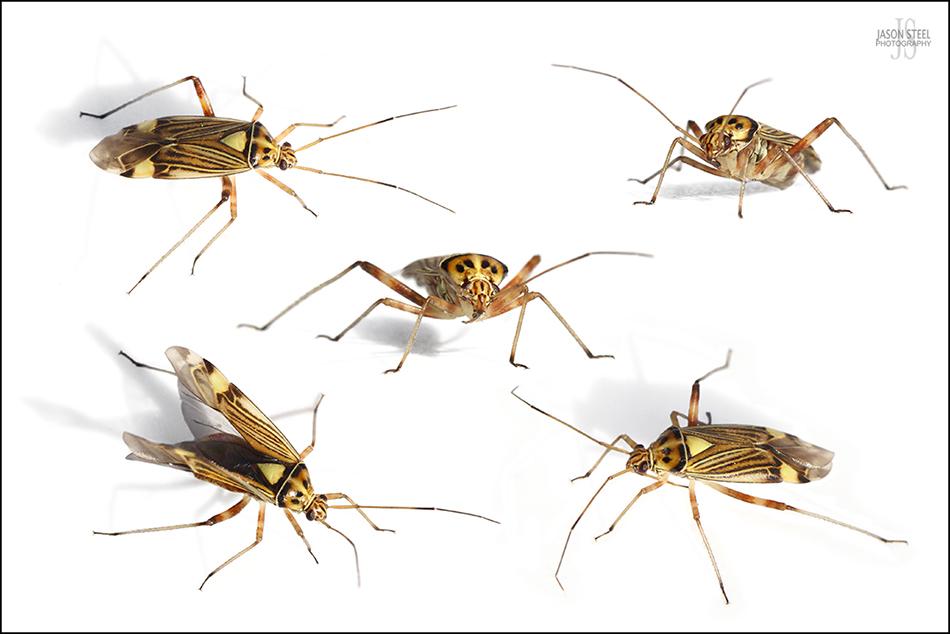
One of many Striped Oak Bugs (Rhabdomiris striatellus) found on a large Oak Tree in Oxted Surrey, 17th May 2020
Striped Oak Bug - (Rhabdomiris striatellus)
A distinctively marked bug that is primarily associated with Oak Trees and Hawthorn Bushes. Adults are usually 7-9mm in length and feed on small insects such as aphids. Striped Oak Bugs overwinter as eggs which hatch in April and grow to adults by May / July. This species is sometimes confused with the similarly coloured and marked Mirid Bug (Miris striatus) which is slightly larger at 9-11mm but is found in the same habitat. Miris striatus are longer, darker and can be distinguished by their black heads.
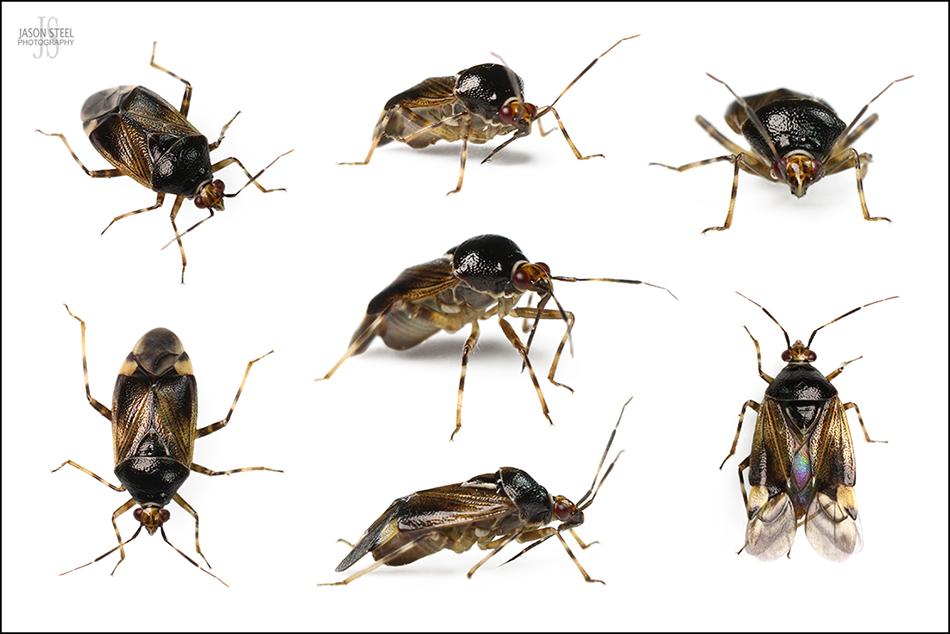
Plant Bug (Deraeocoris flavilinea) found on a large Sycamore Tree in my garden in SE London, 10th June 2020
Plant Bug / Mirid Bug - (Deraeocoris flavilinea)
Deraeocoris flavilinea Plant Bug is primarily found on the host plants Sycamore and Field Maple, but can also be found on other trees and shrubs. This is a fairly new species to the UK since 1996 and is now common across southern and central England. Adults are usually seen from June to July and grow to around 7-8mm in length. Females tend to be lighter and more orange in colour than the dark male specimen pictured above.
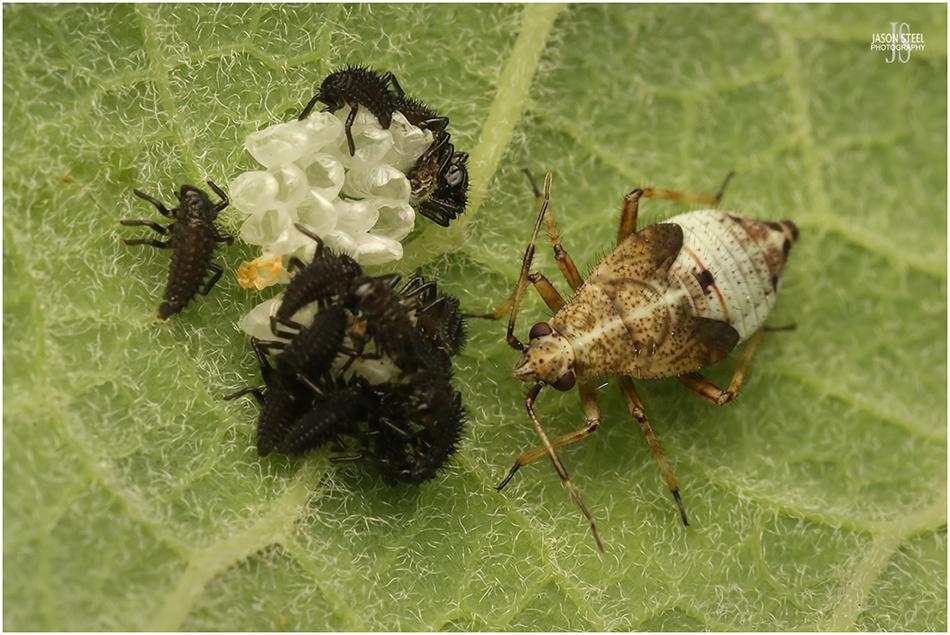
Mirid Bug nymph, Deraeocoris flavilinea, predating the newly emerged larvae of a Harlequin Ladybird, 28th May 2022.
This Mirid Bug nymph was photographed in my SE London garden, on the underside of a leaf of a Goats Willow sapling. Initially I thought the bug itself had larvae but I quickly realised the larvae are that of the Harlequin Ladybird, and the bug was a nymph of Deraeocoris flavilinea, and was preying on the Ladybird larvae. When I checked again the next day the bug had gone and the larvae had dispersed onto other leaves.
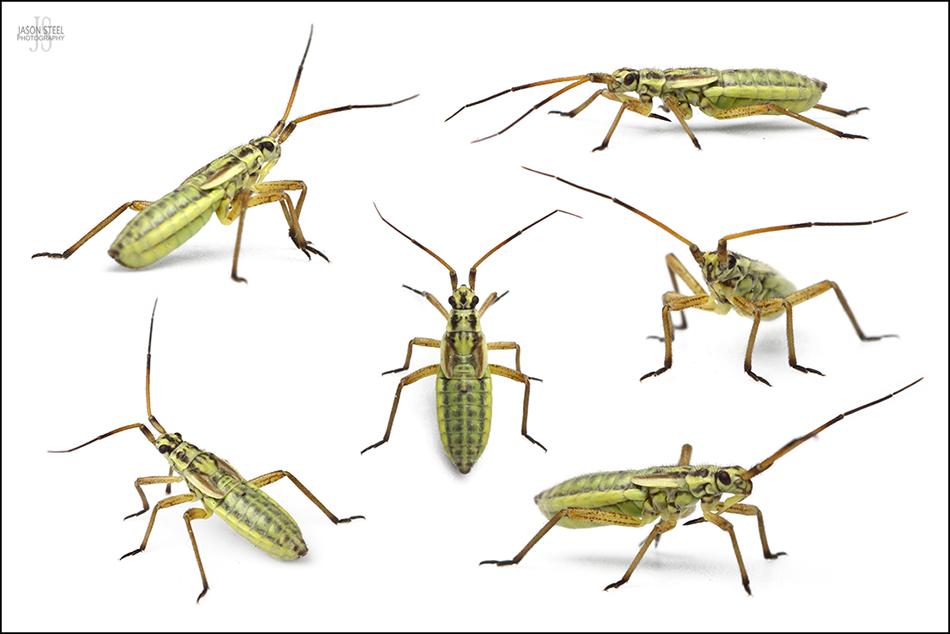
8mm Meadow Plant Bug nymph (Leptopterna cf dolabrata) found in a grass Meadow in SE London, 20th May 2020
Meadow Plant Bug - (Leptopterna dolabrata)
The Meadow Plant Bug is a common and widespread species across the UK and Europe. Adults typically grow to 8 - 8.5mm but can range from 7 - 10mm. Adults are usually found from June to September. Adult males are always macropterous, meaning they have fully developed wings. Adult females are usually only partially winged and look similar to the late nymphs. Males darken from yellow and black to orange and black as they age. Meadow Plant Bugs feed on the plant sap of grass seeds of a various species and cause the seed heads to shrivel and prematurely whiten.
Leptopterna dolabrata is one of two very similar species, with Leptopterna ferrugata looking very similar. However, Leptopterna dolabrata is usually found in damper habitats.
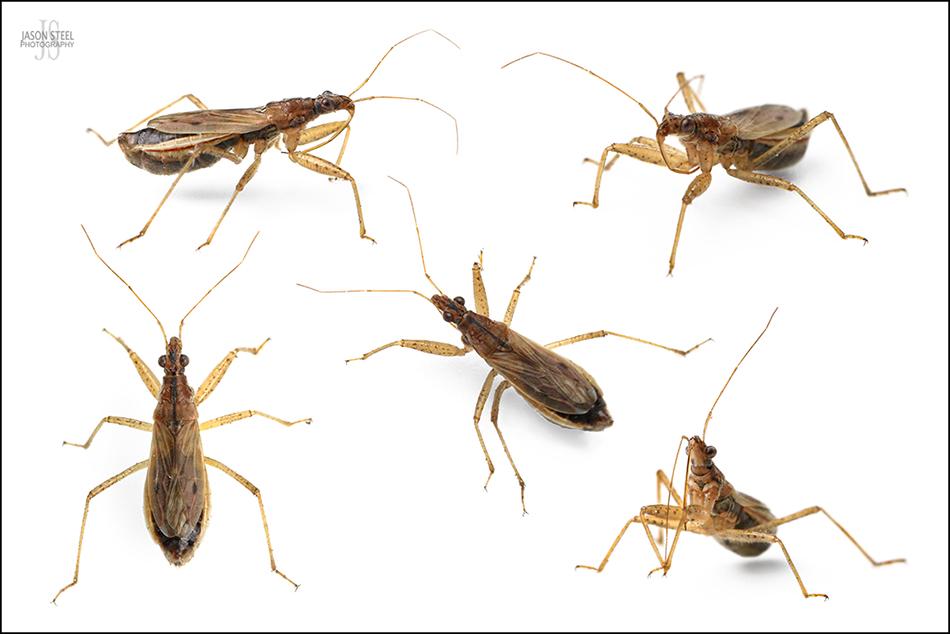
8mm female Common Damsel Bug (Nabis rugosus) found in a grass Meadow in SE London, 11th May 2020
Common Damsel Bug - (Nabis rugosus)
The Common Damsel Bug is a common and widespread species across the UK and Europe with brown - yellow body colour and pale wings. Adults typically grow to 6.5 - 7.5mm, but sometimes slightly larger. Adults overwinter and can be found all year round. The Common Damsel Bug is Europe's most common species of Sickle Bug and can be found in a variety of habitats. They have a preference for mildly moist, and half shady sites with plenty of grass and adjacent woodland. Common Damsel Bugs are a predatory species and hunt smaller insects both on the ground and high up in trees too.
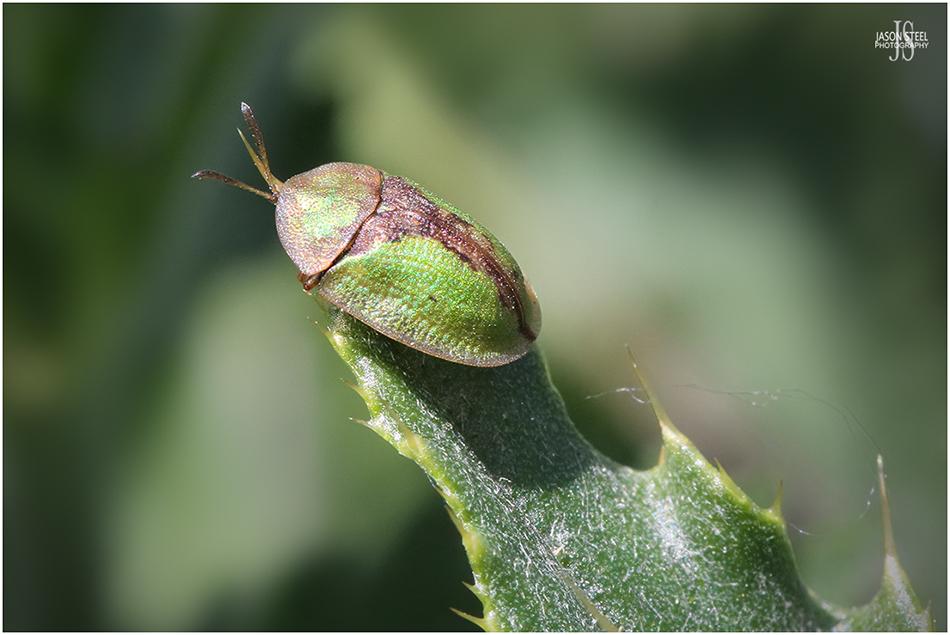
Tortoise Beetle (Cassida vibex) photographed 13th May 2020 on thistles in a grass meadow SE London.
Tortoise Beetle (Cassida vibex)
Tortoise Beetles are members of the Leaf Beetle family. As their name suggests they have an unusual defence system, much like that of a tortoise. When approached they pull themselves down and stick to the leaf beneath them whilst tucking in their legs and antennae safely out of sight. Tortoise Beetles use tiny bristly hairs to fix themselves to the surface. Some species of Tortoise Beetle also produce and adhesive oil that requires 60 times the weight of the beetle itself to free the beetle from the surface its stuck to.
There are 14 species of Tortoise Beetle recorded in the UK. 12 of the 14 species in the UK are members of the genus Cassida, which means 'helmet' in Latin. There are around 430 Cassida species around the world. The two remaining species of Tortoise Beetle in the UK are Hypocassida subferruginea and Pilemostoma fastuosa, although Hypocassida subferruginea hasn't been recorded since the 19th century and is believed to probably now be extinct in Britain. Different species of Tortoise Beetle can be found throughout the world and many are beautifully coloured and look like tiny jewels. The larvae of Tortoise Beetles are often spikey in appearance and can resemble ladybird larvae. Many species have an anal fork which they use to collect shed skin, faeces, and debris to build a shield against predators. When the old skin is shed it is pushed to the rear of the beetle and becomes part of the rear defences. Beneath the elytra (wing-cases) Tortoise Beetles do possess fully functional wings. When approached with my camera I have, on one occasion, seen one fly off and land a few feet away so they can use their wings to evade potential predators.
Can Tortoise Beetles change colour?
There is often variation in colour between specimens of the same species and older specimens do fade in colour. There are a few species of Tortoise Beetle though that can actually change colour and vary their appearance and switch between two pre-set colours. Due to the metallic sheen on many Tortoise Beetles the appearance of their colour can also vary depending on the angle of light hitting them.
The Tortoise Beetle shown here is Cassida vibex, which grows to around 5.5-8mm in length. Cassida vibex is usually found on thistles and knapweeds but can be found on a variety of other herbaceous plants too including dock leaves. Although causing unsightly small holes in the leaves of plants Tortoise Beetles are rarely found in significant enough numbers to do any real harm so aren't usually considered a real pest by gardeners. Tortoise Beetles are preyed upon by many other invertebrates including damsel flies, robberflies, shieldbugs, ladybirds and parasitic wasps. Cassida vibex is sometimes referred to as the Thistle-Feeding Tortoise Beetle, which is easily confused with the similar sounding and similar looking Thistle Tortoise Beetle, Cassida rubiginosa.
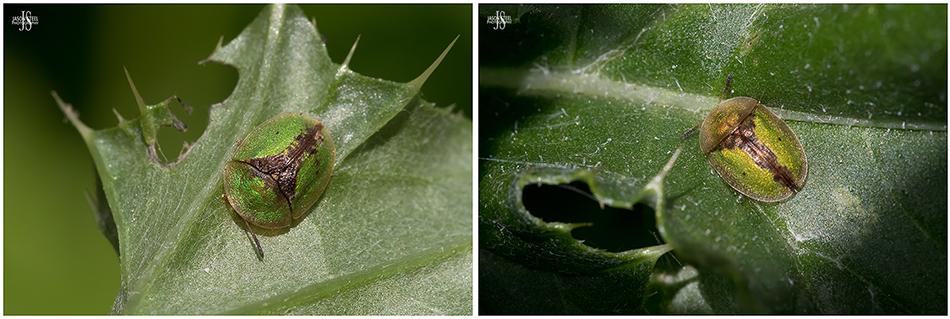
Two of the six 4mm Tortoise Beetles (Cassida vibex) found 2nd June 2021 on thistles in a grass meadow SE London.
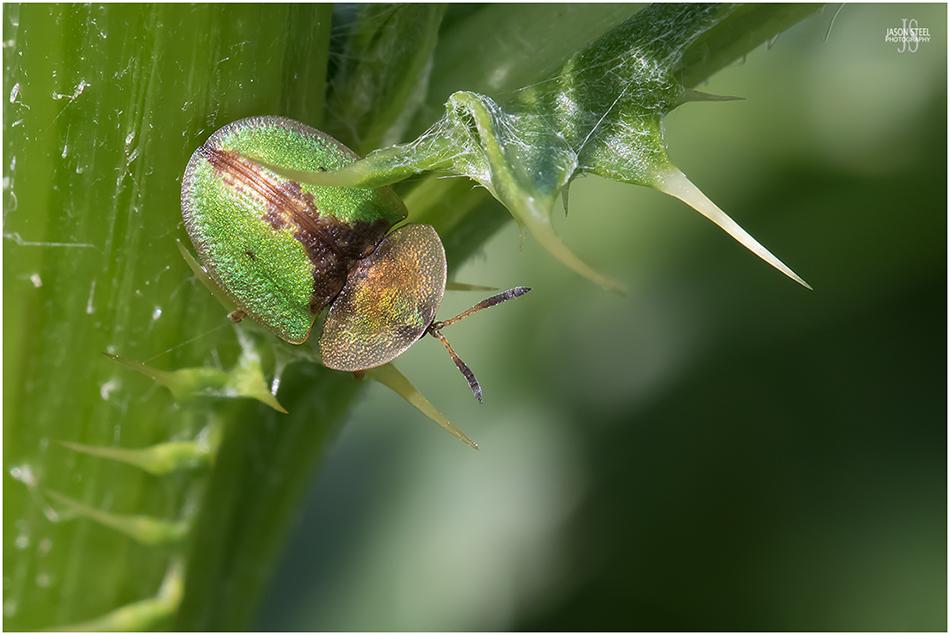
One of the six 4mm Tortoise Beetles (Cassida vibex) found 2nd June 2021 on thistles in a grass meadow SE London.
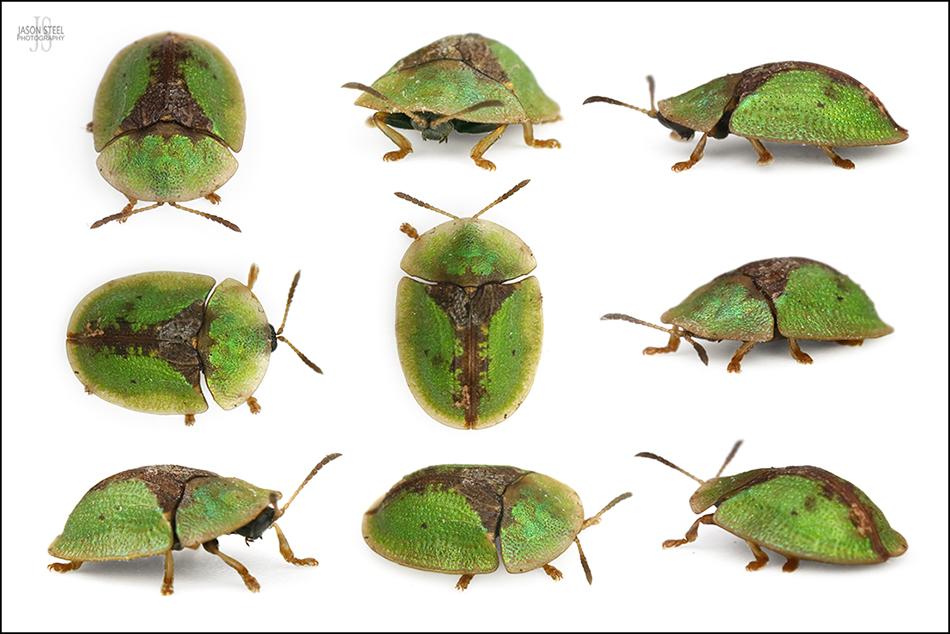
4mm Tortoise Beetles (Cassida vibex) found 2nd June 2021
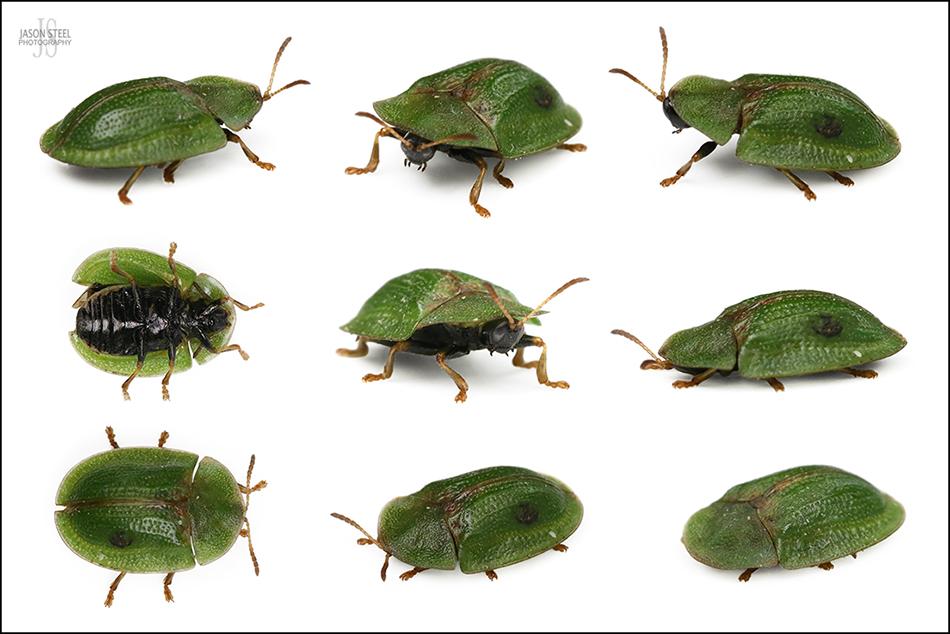
6mm Thistle Tortoise Beetle (Cassida rubiginosa) found on thistle plant at the edge of a grass field in SE London, 28th May 2021.
Thistle Tortoise Beetle (Cassida rubiginosa)
Cassida rubiginosa is very similar in appearance to Cassida vibex and both species can be found on thistle plants. Cassida rubiginosa tends to be more of a matt green than the golden green of Cassida vibex and Cassida vibex also usually has a broader central band. The Thistle Tortoise Beetle gets its Latin name by its ability to secrete a reddish-brown fluid from its head as a defence mechanism. The images of Tortoise Beetles on some website make identifying species quite difficult as many species of Tortoise Beetle tend to go a golden- yellow colour once killed and preserved. The Thistle Tortoise Beetle grows to around 6 - 7.5mm and whilst adults tend to feed from the upper surface of the host plant leaves the larvae ae usually seen feeding from the underside of the leaves. Larvae can reach maturity in as little as 5-6 weeks and adults live for 20 months to 3 years.
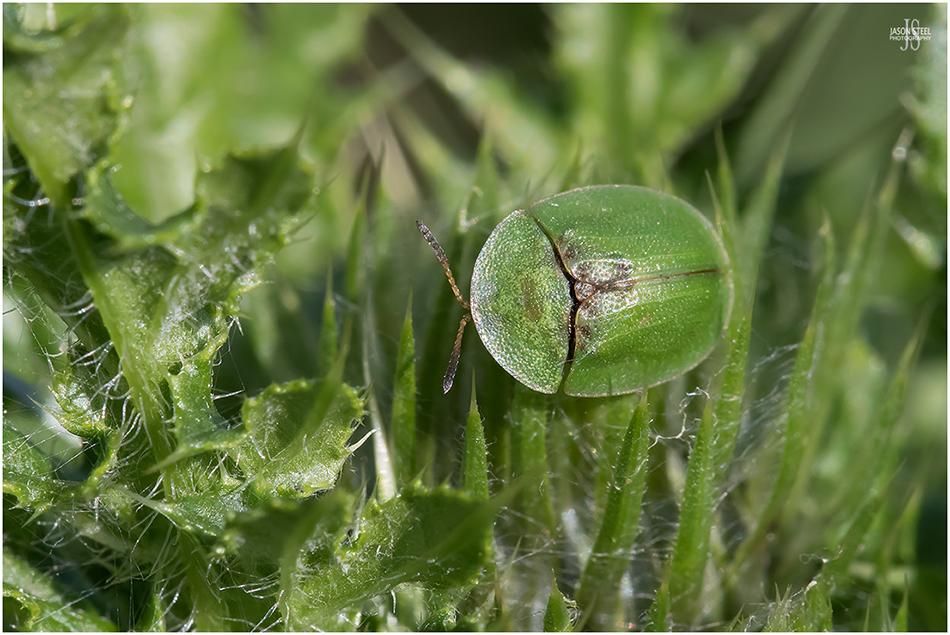
7.5mm Thistle Tortoise Beetle (Cassida rubiginosa) found on the flower head of a thistle plant at the edge of a grass field in SE London, 29th May 2021.
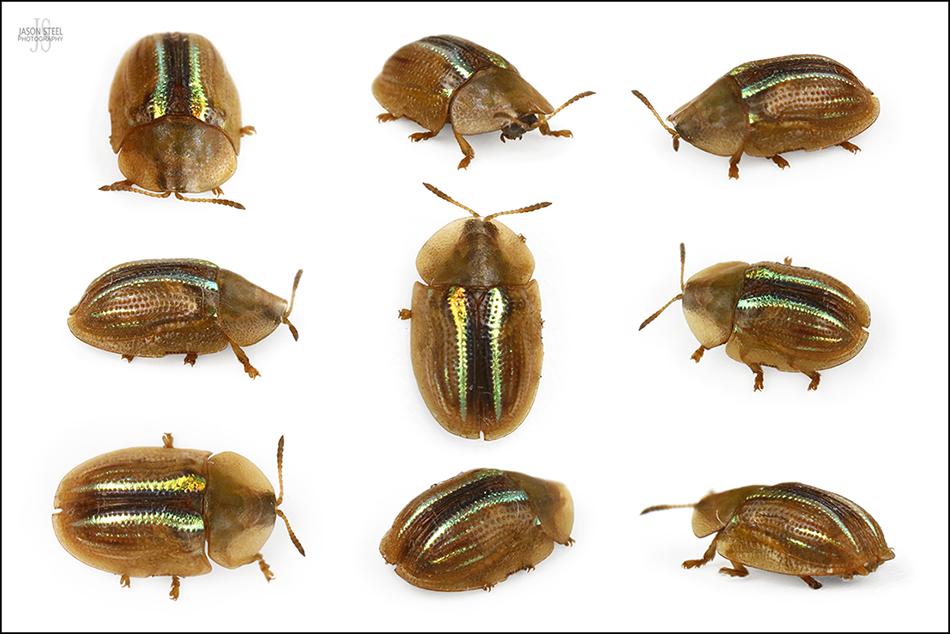
3.5mm Golden-Striped Tortoise Beetle (Cassida nobilis) found on Minster Beach, Kent, 7th July 2021
Golden-Striped Tortoise Beetle (Cassida nobilis)
The Golden-Striped Tortoise Beetle is a small species growing to around 3.5-6mm as adult beetles. They are a nationally scarce species in the UK, often found on sandy or chalky soils and recorded mainly at coastal locations. Larvae and adults freed on the leaves of many garden vines. Morning glory, sweet potato vines, bindweed and other plants in the Convulvulaceae family. The larvae are also round in shape, but are usually pale green and carry a large lump of mixed frass and exuvia above their body, kept in place by a pair of hooks at the tip of the abdomen. It is reported that the Golden-Striped Tortoise Beetle can change colour at will and varies from light green to light gold and dark brown. The stripes vary in colour from bright green, to gold or yellow. The specimen pictured above was far paler before being captured for photos.
In many countries in Europe they considered a pest species, where they have been recorded feeding on Atriplex; Artemisia vulgaris; Beta vulgaris; Chenopodium; Erigeron canadensis; Honckenya peploides; Silene latifolia; Spergula; Tripleurospermum inodorum.
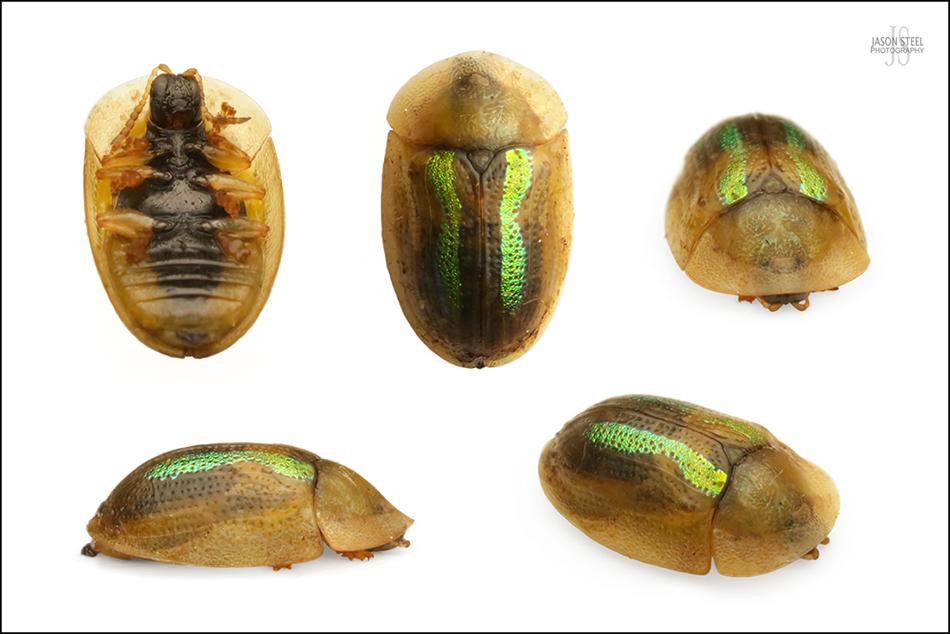
Deceased 3.5mm Bordered Tortoise Beetle, Cassida vittata, found in beetroot bought in Leicester, 22nd March 2022
Bordered Tortoise Beetle (Cassida vittata)
The Bordered Tortoise Beetle is a small species growing to around 3.5-6mm as adult beetles. In the UK this species is usually found near coastal areas, and can be a pest of beetroot. Cassida vittata is very difficult to distinguish from the similar Cassida nobilis. The two species can be distinguished by the tips of the antennae. The antennae of Cassida vittata are uniform in colour, but on Cassida nobilis the tips are darker than the rest of the antennae.
* Grateful thanks to Kay Riddell for sending this beetle to me so it could be added to my website. *
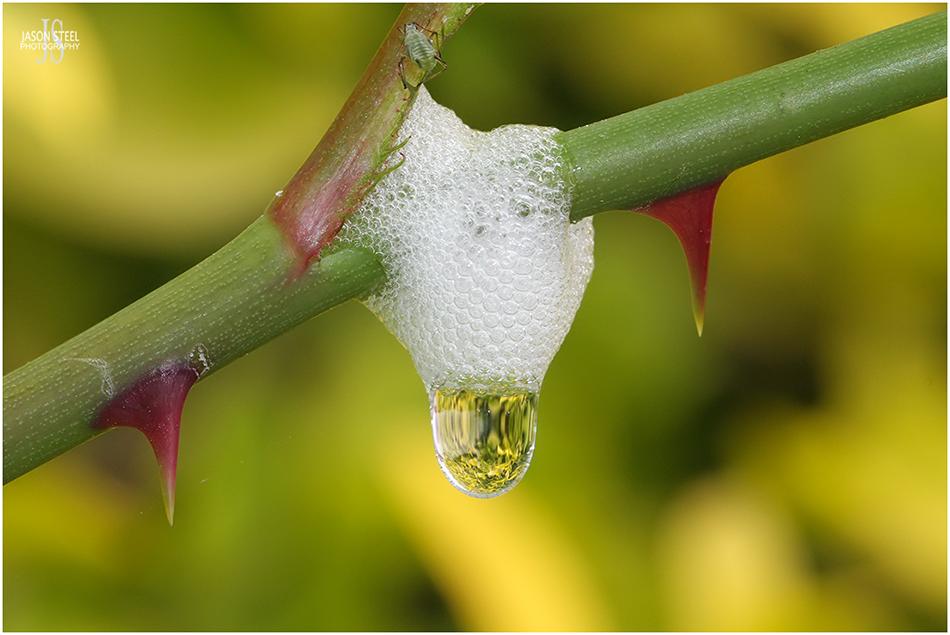
"Cuckoo spit" - Spittle concealing the Common Froghopper found on Roses in my garden in SE London 9th June 2020
Common Froghopper / Meadow Spittlebug (Philaenus spumarius)
Have you ever seen this "spit" on your plants and wondered what it was? A common misconception is that it's either a type of fungus or an excretion from the plant itself. Well the truth is if you look inside the foamy spittle you'll find there's a little bug to blame for it. "Cuckoo spit", as it's often referred to, has absolutely nothing to do with Cuckoos but is an excretion from a tiny bug called a Froghopper or Spittlebug. As a nymph these little bugs feed on plant sap and as they feed they excrete this white foamy, frothy substance which completely hides the nymph itself. It is believed that this spittle is a form of defence to disguise and protect the nymph from predators whilst it's young. However this form of defence isn't effective against all predators. In fact it could even attract some predators such as lizards. Sand Lizards have been observed to not only drink the frothy spittle but then consume the bug as well! Adult Froghoppers lay their eggs in plant stems in autumn, which emerge as nymphs in spring and immediately begin feeding and producing the spittle. Whilst hidden away in the spittle the nymphs will moult five times before leaving the spittle and living out in the open as adults.
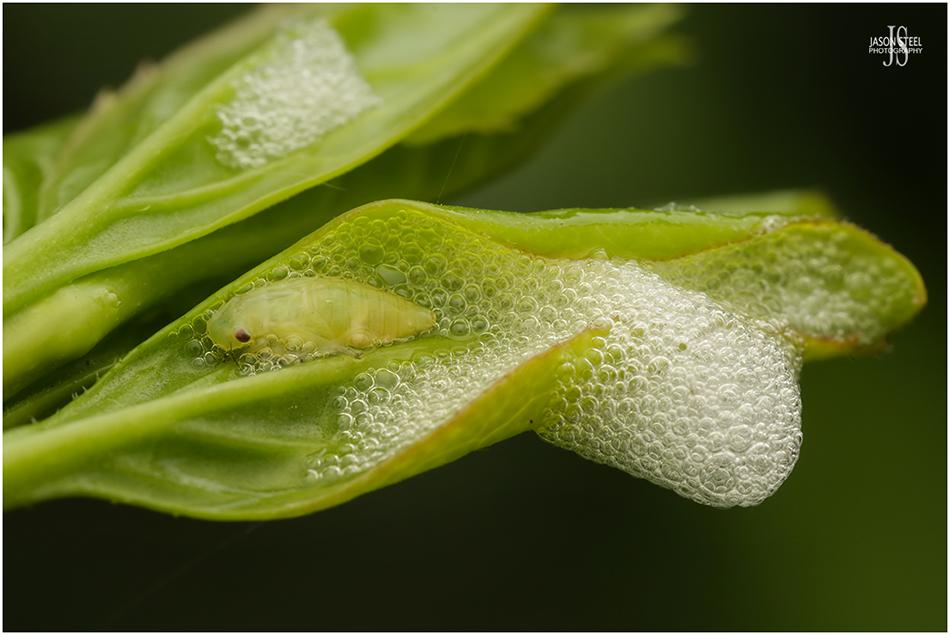
4mm Common Froghopper / Meadow Spittlebug nymph, exposed from under its spittle, on a Forsythia plant, in my SE London garden, 28th May 2022.
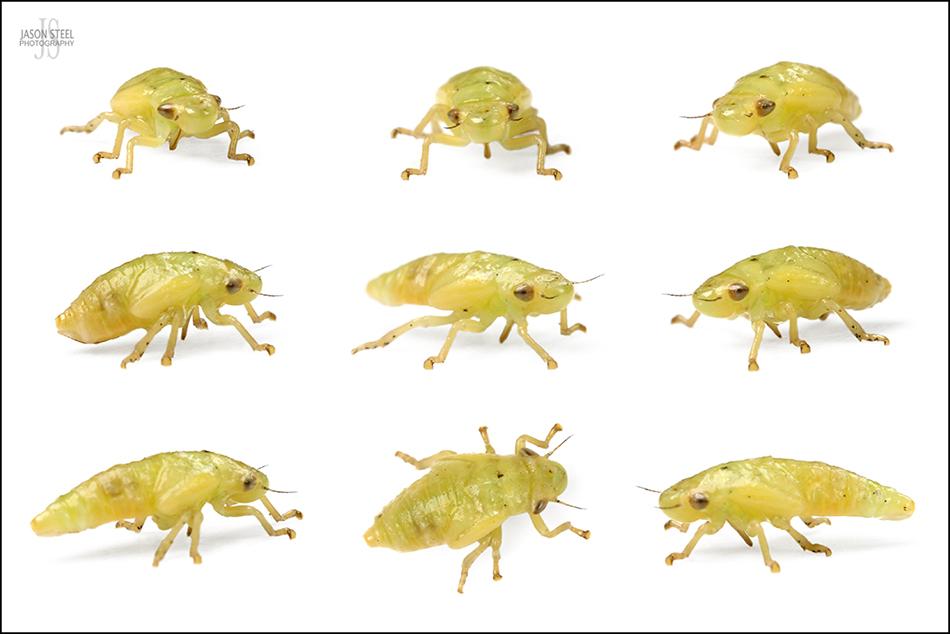
3mm Common Froghopper / Meadow Spittlebug nymph (Philaenus spumarius) removed from spittle on my roses.
The Common Froghopper grows to around 5-7mm as an adult. This species is extremely common and widespread and can be found in most open habitats including in gardens, parks and open forests, and has been recorded feeding on over 400 different species of plant. The Common Froghopper is highly variable in both pattern and colour as an adult and ranges from light brown to dark brown, yellow, green and even black in colour. Nymphs are initially yellow at the early stages and light green as they mature. Whilst Froghoppers are not dangerous to plants and are not considered a pest to gardeners in the UK, in Europe they can be carriers of the bacterial disease Xylella fastidiosa which is deadly to many plants including olive trees. As such sightings of the Common Froghopper should be recorded here to help monitor their range: RECORD SIGHTING
As of June 2019 11,000 records had been submitted from across the UK with the south of England being a hot-spot. 81% of these records came from gardens.
Froghoppers (Cercopoidea) and Leafhoppers (Cicadellidae) are almost identical in appearance but can be separated by examining the hind legs. Leafhoppers have 1 to 3 rows of fine, thin, spines, whereas; a Froghopper has 2 wide and thick spines on the outer edge of the hind leg.
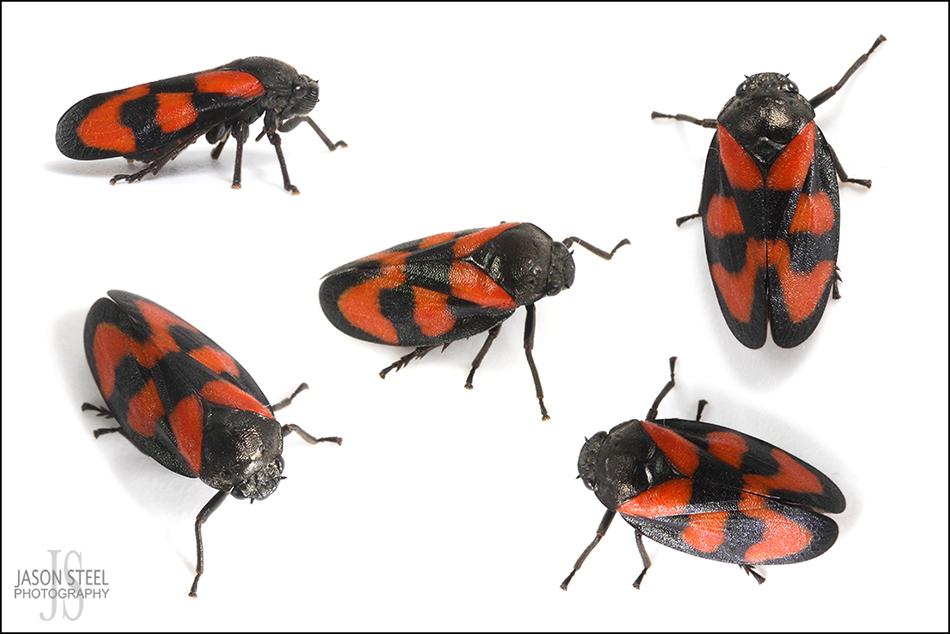
Red & Black Froghopper (Cercopis vulnerata)
Red & Black Froghopper (Cercopis vulnerata)
The Red & Black Froghopper is one of our largest Homopterans (Leafhopper bugs) at 9-11mm. There are a few very similar species in Europe but in the UK they are unmistakable. Found in Woodland clearings, grassland and meadows from April to August, resting on the stems of grass and low growing vegetation. Unlike other species of Froghopper the nymphs of the Red & Black Froghopper live underground feeding on plant roots and do not conceal themselves in spittle.
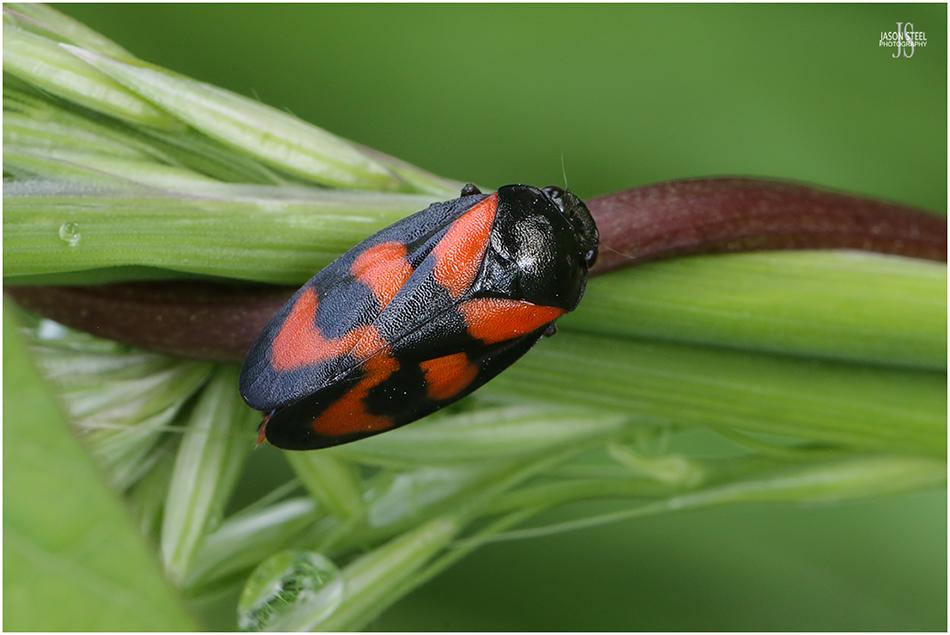
Red & Black Froghopper on low vegetation in a grass meadow in North Kent, 11th June 2021
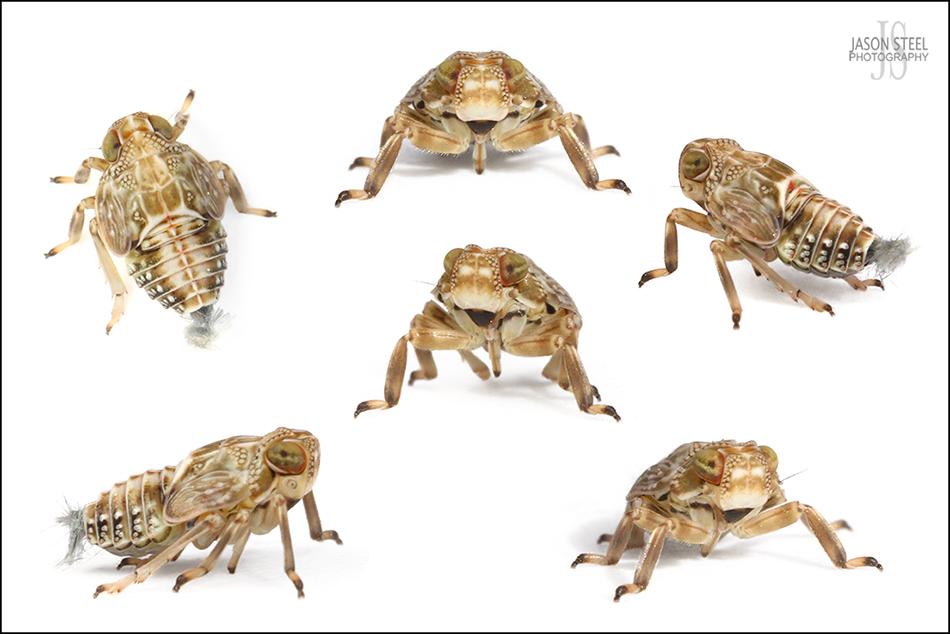
Planthopper nymph (Issus sp. probably coleoptratus)
Planthopper (Issus cf coleoptratus)
These small plant hoppers grow to 5.5-7mm in length. They feed on the phloem of trees and nymphs can be found overwintering on Ivy. Unlike most species in this family this insect can't fly. However, despite their tiny size adults are one of the most powerful jumping insects on the earth and can jump at a 45 degree angle for a length of over 1 metre! Nymphs have gears on their hind legs which synchronise limbs when jumping and prevent the insect from spiralling during a jump.
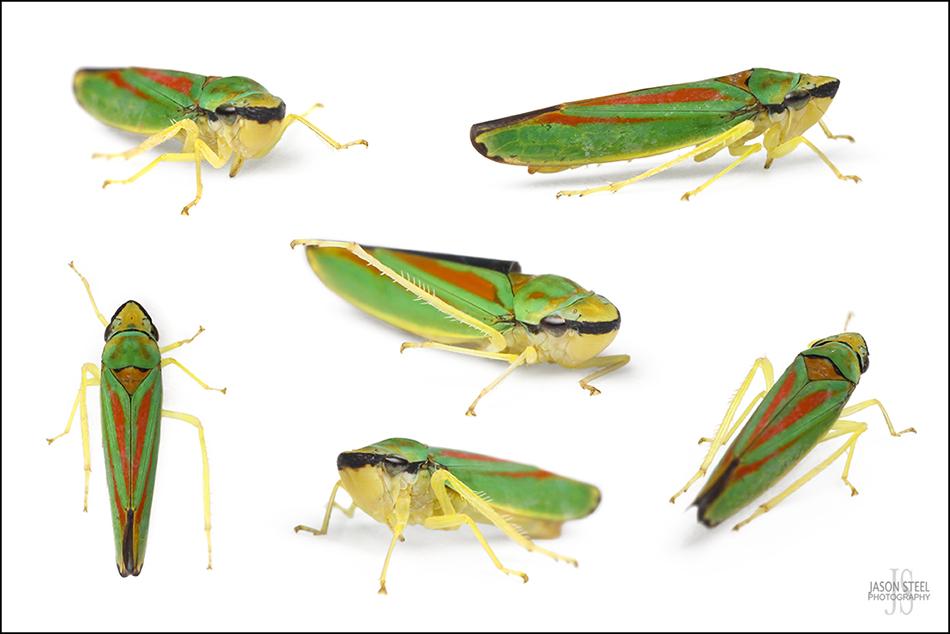
Rhododendron Leafhopper (Graphocephala fennahi)
Rhododendron Leafhopper (Graphocephala fennahi)
The Rhododendron Leafhopper is a bright and colourful bug that feeds as both adult and nymph on the sap of Rhododendron plants. It's one of the very few species of insect that will feed from Rhododendron plants and although the Leafhopper does no damage to the plant since their introduction to the UK there has been a fear that this species might be responsible for spreading a fungus (Seifertia azalea) to Rhododendron plants that prevents them from flowering. There is some doubt on whether this is the case though. Adult Rhododendron Leafhoppers can be found wherever Rhododendron plants are found, from July right through to December and grow to around 7-10mm in length. When approached they evade danger by either jumping or flying and revealing their black wings. Rhododendron Leafhoppers originate from the USA where they are known as the Scarlet & Green Leafhopper. They were first recorded in the UK in 1935 and currently this species is confined to the southern half of Britain but is spreading north. Eggs are laid late summer in the flower buds which then hatch the following spring.
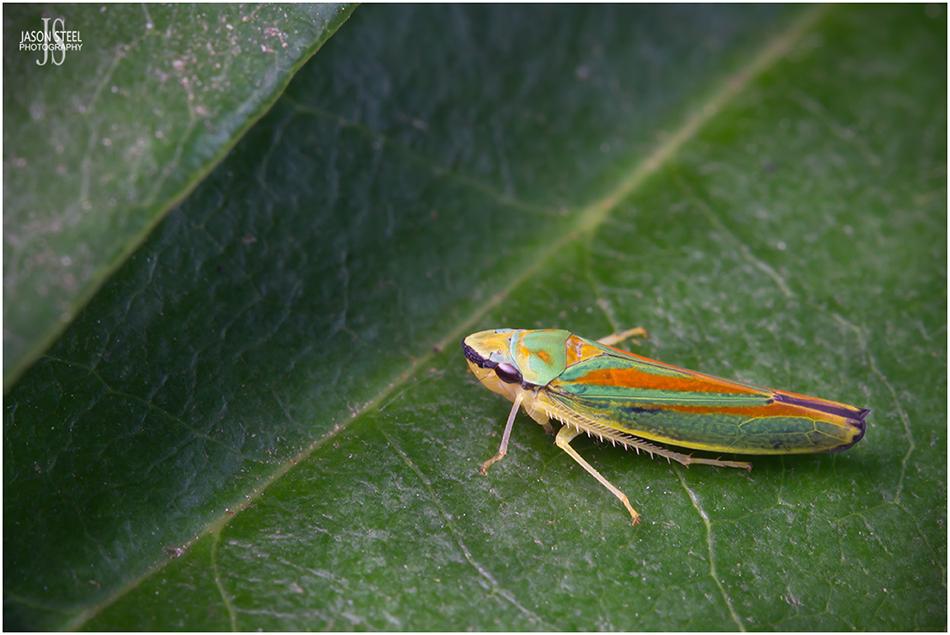
One of several Rhododendron Leafhoppers found in a residential garden in Hastings, 21st July 2020.
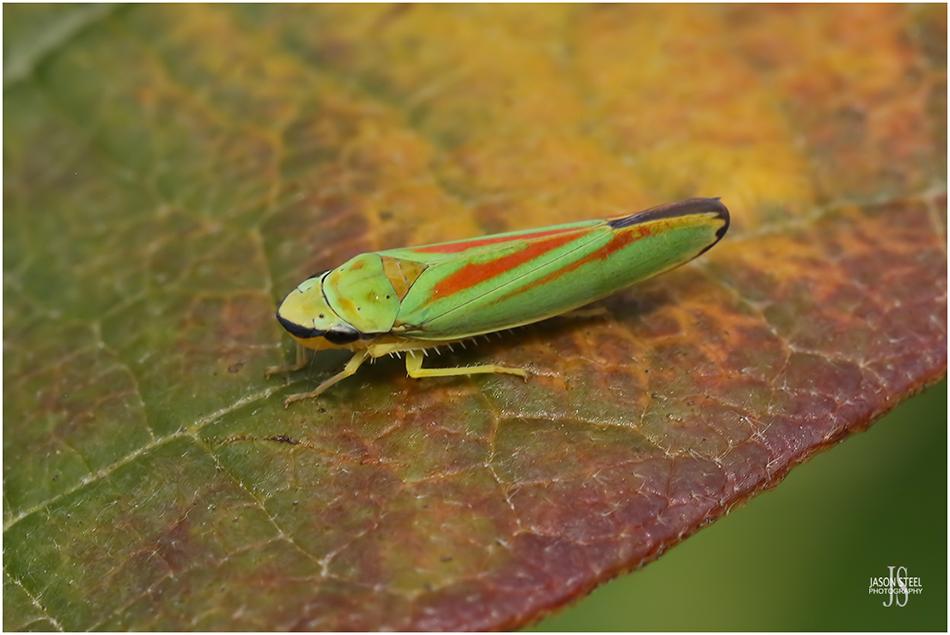
One of hundreds of Rhododendron Leafhoppers, seen on Rhododendron plants, and other vegetation, at Lamberhurst, Kent. 31st August 2022.
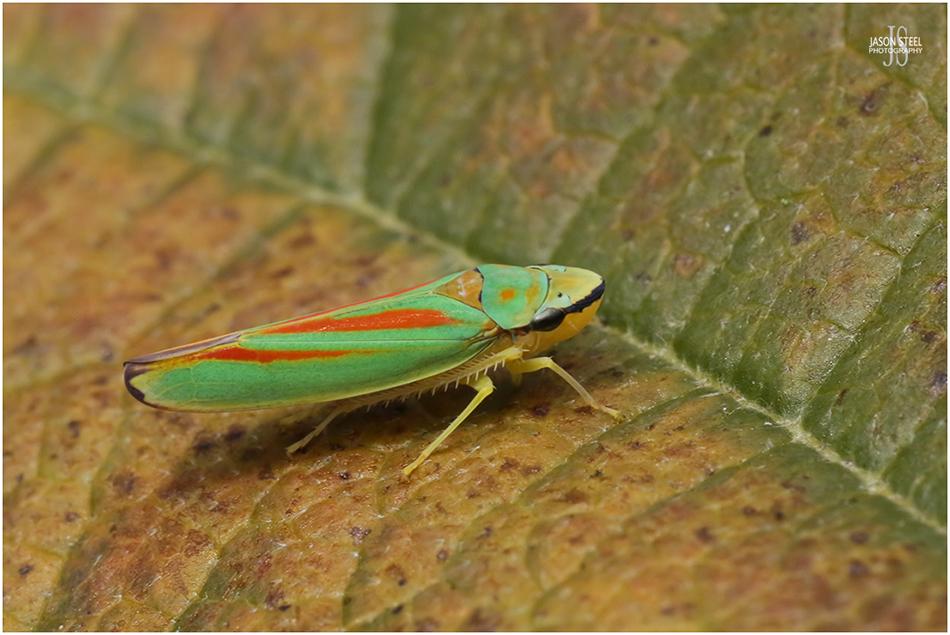
One of hundreds of Rhododendron Leafhoppers, seen on Rhododendron plants, and other vegetation, at Lamberhurst, Kent. 31st August 2022.
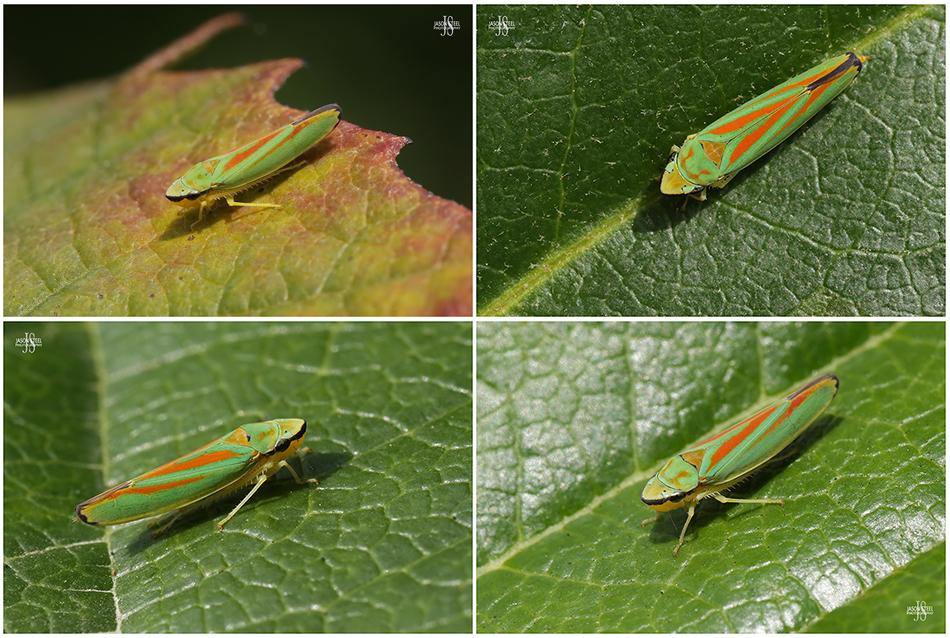
Rhododendron Leafhoppers, seen on Rhododendron plants, at Lamberhurst, Kent. 31st August 2022.
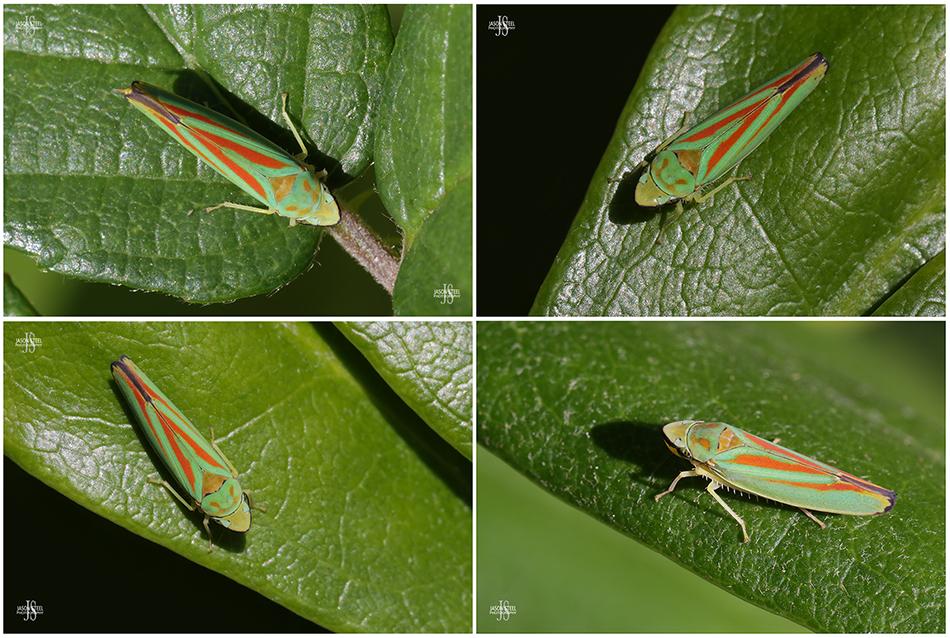
Rhododendron Leafhoppers, seen on Rhododendron plants, at Lamberhurst, Kent. 31st August 2022
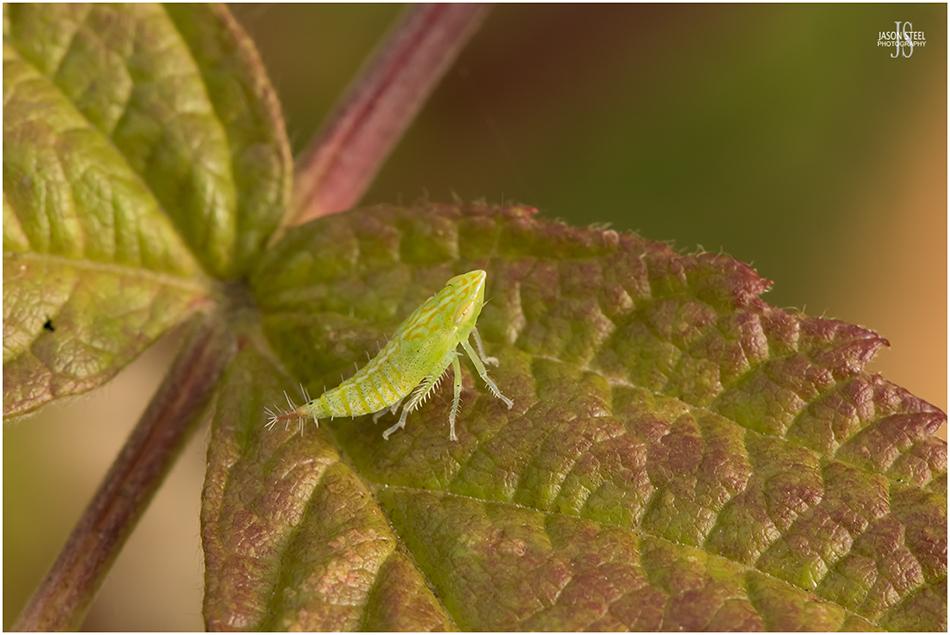
Privet Leafhopper nymph (Fieberiella cf florii) photographed in my SE London garden, 18th August 2021.
Privet Leafhopper (Fieberiella florii)
The Privet Leafhopper is a fairly new arrival in the UK from Europe, and was first recorded in London in 1998. So far most records have come from around the London area, but this species has also been recorded in Yorkshire since 2010. So far all sightings have been recorded from around homes, suggesting that this species was probably introduced via the horticultural trade. Adults grow to around 6.5-8mm in length and can be found from June to October. It can be found on Laurels, including Bay and Privet. Synophropsis lauri is very similar in appearance.
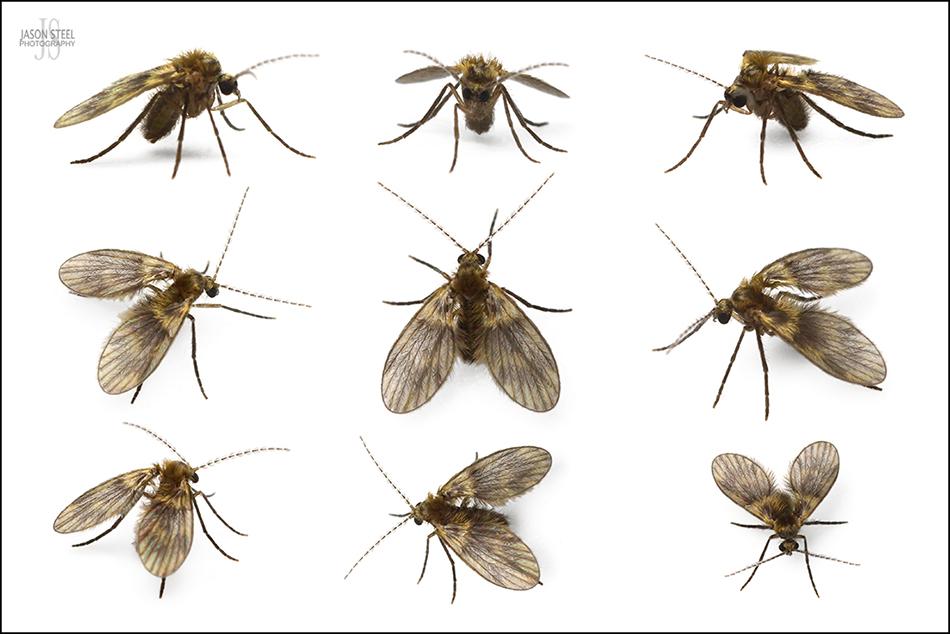
2.5mm Moth Fly found in my home in SE London, 10th June 2020
Moth Fly / Drain Fly (Psychodinae Sp.)
Moth Flies are tiny little flies that are attracted to damp places outdoors such as rotting leaf litter and compost heaps. In houses they are found around showers, baths and sinks where their larvae feed on the algae, fungi and bacteria-infested rotting sludge and debris that builds up in our drainage systems and sewer pipes. Moth Flies play an important role in cleaning up our waste. There are around 100 species of Moth fly in the UK and they range in size from 1.5mm to 4mm. Their wings are covered in tiny scales and hairs giving them the appearance of a small moth. Some species even look furry! When swatted they can appear to explode in a cloud of dust! They are actually a species on non-biting gnat and are completely harmless to humans.
Moth Flies have many common names including: Drain Fly, Owl Fly, Owl Midge and Sewer Fly. The adults of some species of Moth Fly do not feed at all , whilst adult Moth Flies of other species feed on polluted water and flower nectar. Moth Flies are weak fliers and outdoors they usually only fly a few feet at a time.
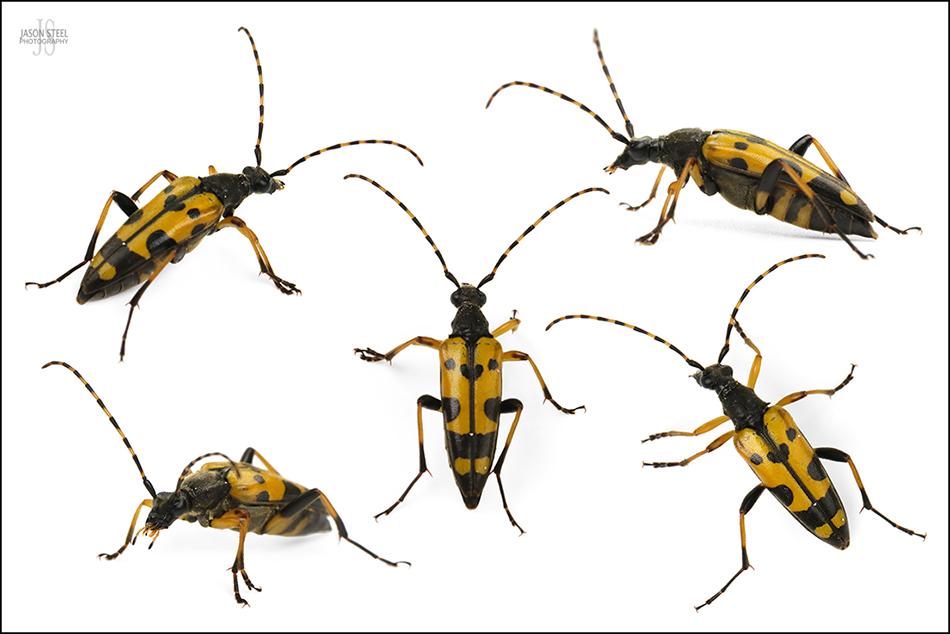
20mm Spotted Longhorn Beetle found on Swanscombe Marshes, 26th July 2021
Spotted Longhorn Beetle (Rutpela maculata)
The Spotted Longhorn Beetle is one of Britain's larger and more impressive species of Longhorn Beetle that grows to around 13-20mm in length. This species is common and widespread across England and Wales and can often be found in adult form on Hawthorn and Umbellifers, where they feed on nectar and pollen. The larvae of Rutpela maculata, like many Longhorn Beetles, feed on decaying wood, where they can remain for 2-3 years before pupating in the wood. Adults emerge around late April or May and can usually be seen until August. Despite their striking colours these beetles are completely harmless to humans. The patterns and markings can vary considerably and the basic colour can range from yellow to orange. Rare specimens have exhibited entirely black or entirely yellow wing-cases. The yellow and black legs and the stripy antennae separate the Spotted Longhorn from other similar species including Leptura quadrifasciata and Strangalia attenuata.
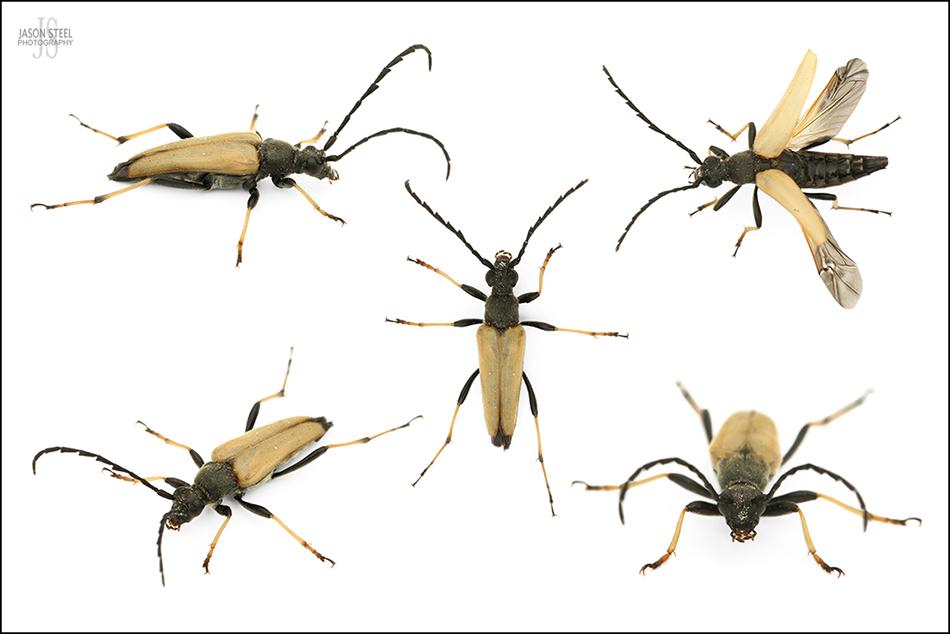
14mm male Red Longhorn Beetle found on Surrey heathland, 24th July 2020
Red Longhorn Beetle (Stictoleptura rubra / formerly Corymbia rubra, Leptura rubra)
A medium-sized and fairly uncommon species of beetle found mainly in the south of Britain. Females are reddish brown in colour with a black head, whilst the males have pale yellow / orange elytra (wing cases) and a black head and thorax . Males are also slightly smaller and slimmer than the females. Adults grow to around 10-20mm in length. The larvae of the Red Longhorn Beetle develop in dead wood, often pine and firs, whilst the adults feed on pollen and nectar.
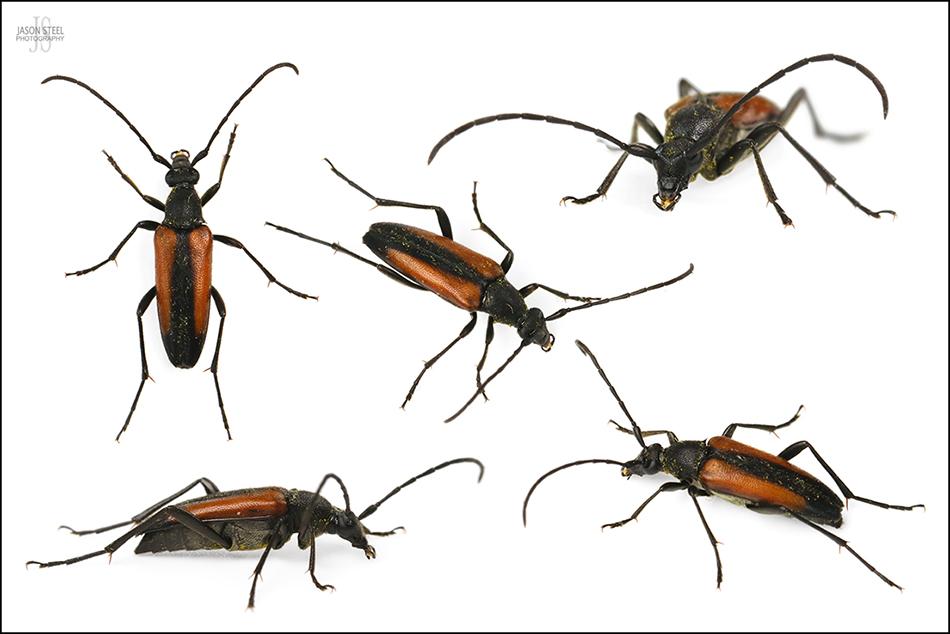
8mm Black-Striped Longhorn Beetle found at Swanscombe Marshes, Kent, 24th July 2020
Black-Striped Longhorn Beetle (Stenurella melanura)
A small species of Longhorn Beetle growing to around 6-10mm in length. Adults can be found from May to September on various flowers in woodland, meadows and parks. The larvae can be found boring into low sapwood, thin branches in contact with the ground and tree stumps, usually in damp areas. The Black-Striped Longhorn Beetle is widespread in England and common in the south. Less common elsewhere in the UK. Black variations also ocurr on rare occasion which resemble the much rarer Stenurella nigra.
Stenurella melanura is similar in appearnace to several other species of Longhorn Beetle including Alosterna tabacicolor & Pseudovadonia livida.
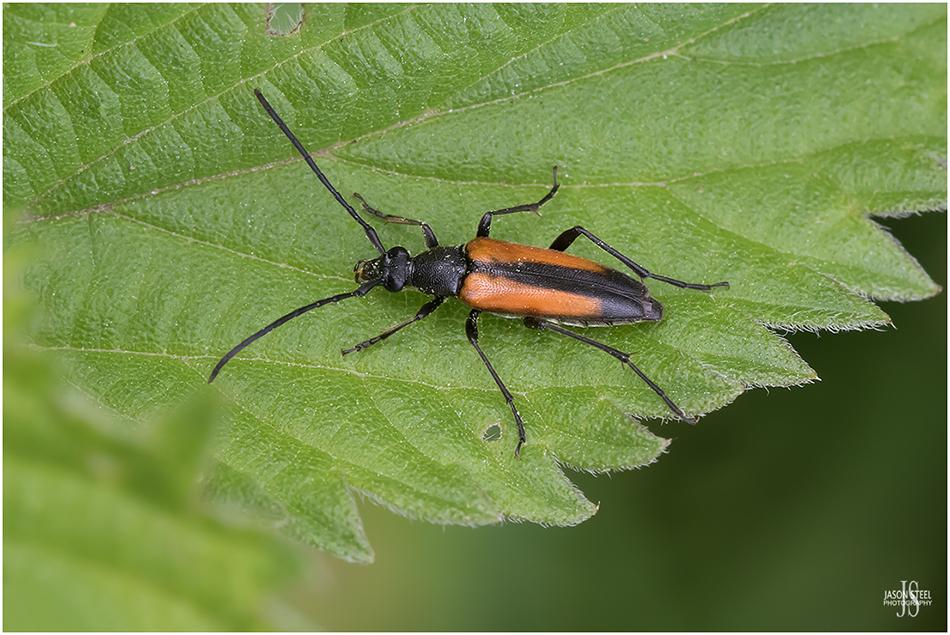
One of many 8mm Black-Striped Longhorn Beetles found at Swanscombe Marshes, Kent, 24th July 2020
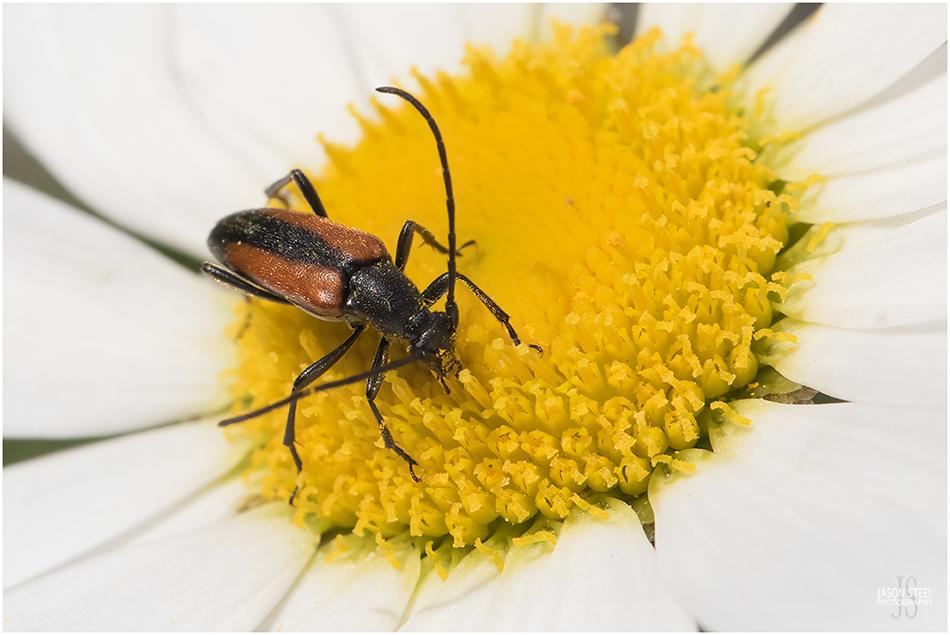
One of many 8mm Black-Striped Longhorn Beetles found at Swanscombe Marshes, Kent, 24th July 2020
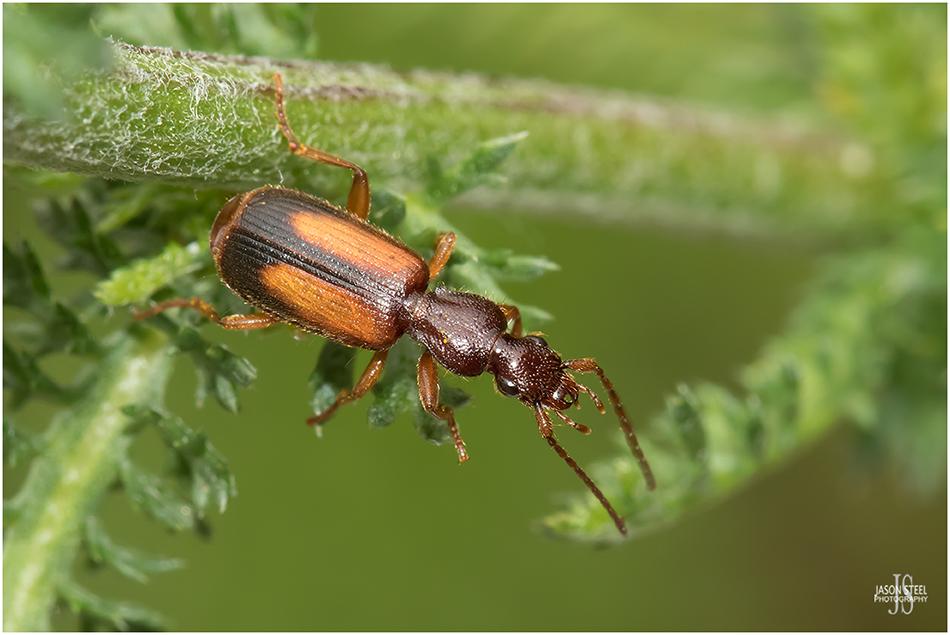
8mm Polistichus connexus Ground Beetle found at Swanscombe Marshes, Kent, 29th July 2020
Ground Beetle - (Polistichus connexus)
Polistichus connexus is a rare and declining species of Ground Beetle confined mainly to the south and south-east of England, and favouring coastal sites. This distinctive Ground Beetle grows to around 8 - 9.5mm in length. Polistichus connexus is attracted to light and its distribution has been mapped after specimens have been regularly found in light traps recently. I have found this species on every visit to Swanscombe Marshes during the summer of 2021, hidden away under boards, driftwood and logs.
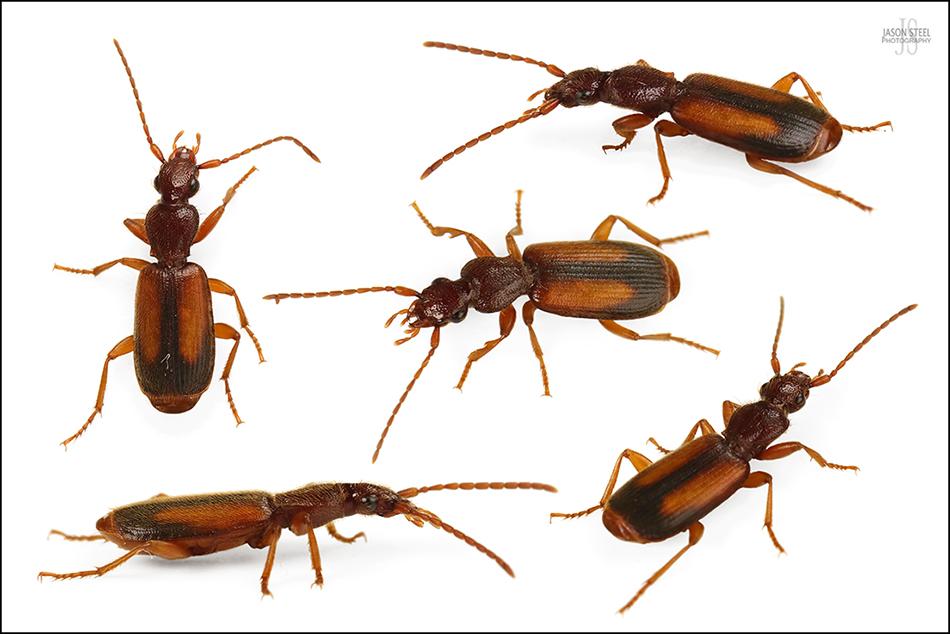
8mm Polistichus connexus Ground Beetle found at Swanscombe Marshes, Kent, 29th July 2020
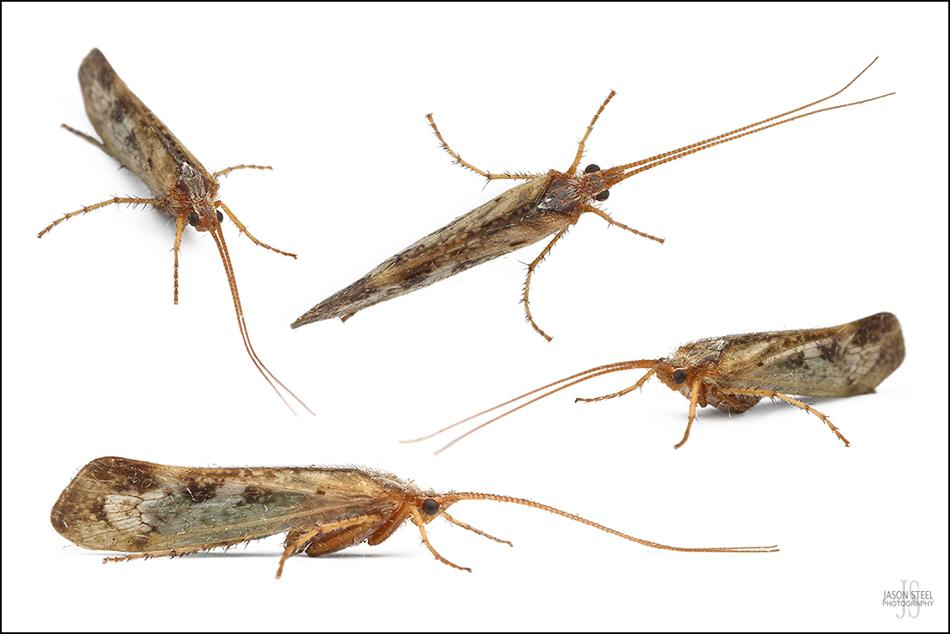
28mm Caddisfly, caught in a moth-trap in my SE London garden, 29th July 2020
Caddisfly (Trichoptera)
In the UK there are around 200 different species of Caddisflies, also known as Sedge Flies, ranging from a few mm in length up to over 30mm in length. Many can be very difficult to identify down to species level. Caddisflies are closely related to moths but whilst the wings of a moth are covered in tiny scales the wings of a Caddisfly are covered in tiny hairs. Caddisfly wings lay flat along the back of the Caddisfly at rest just as you would see with a Damselfly. Adults can often be found on vegetation near ponds and other freshwater habitats during the day and are easily caught in moth-traps at night. Adult Caddisfly have been known to fly over 5km to find new breeding ponds. Whilst some species lay their eggs beneath the water's surface others will attach their eggs to pondside vegetation.
The larvae are aquatic and most species dwell in self-constructed cases made from a combination of stones, soil, leaves and fragments of vegetation and bound together with silk secreted from glands near the mouth of the Caddisfly larvae. Some of these cases are transportable and are carried around like a snail's shell. Others have cases that are fixed to the sides or bottom of the pond or to pond vegetation. A few species of Caddisfly larvae are free-swimming and only construct their cases when ready to pupate. Larvae feed on algae and pond weed and are preyed upon by many other pond dwellers including fish, larger larvae such as dragonflies, water-boatmen and newts.
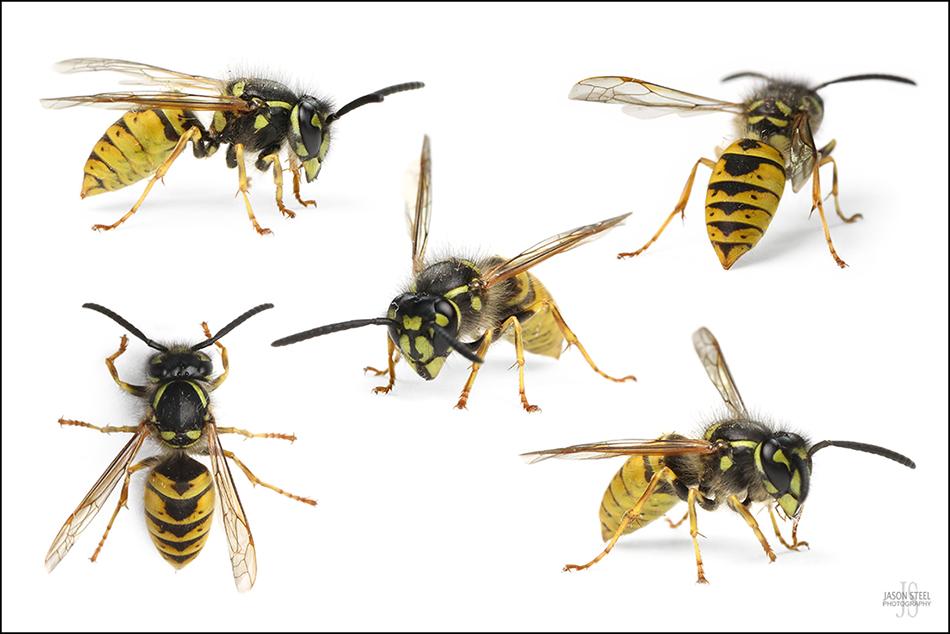
Common Wasp, caught in a moth-trap in my SE London garden, 31st July 2020
Common Wasp (Vespula vulgaris)
In the UK there are two different genus of "Yellow-Jackets". Vespula contains three species of wasp found in the UK, and Dolichovespula, which contains a further three species of wasp found in the UK. The most common social wasps in the UK are Vespula vulgaris, the Common Wasp, and Vespula germanica, the German Wasp. Both species are closely related and very similar in appearance. They can be distinguished by close examination of their face and abdominal markings.
The Common Wasp comes in three forms, queens (reproductive females), workers (non-reproductive females), and males. Queens emerge around April and hastily set about gathering wood pulp, which they use to start building their papery nest. The queen will initially lay a small number of eggs which hatch to bring forth the first of the workers. The workers will eventually take over the role of nest building and the queen will confine herself to the nest and from then onwards concentrate solely on reproducing and establishing the colony. In the autumn the queen begins to lay eggs that develop into males and new queens. Once developed these males and new queens will leave the nest and head off looking for other males and queens to mate with. Once mating has occurred the males will die, along with all the old colony including the workers and the old queen. Only the new queens will survive and will hibernate until emerging the following spring to start the cycle once again. Occasionally the old colony can survive through mild winters but they will still die in the spring leaving the new queens to carry on their genes.
Common Wasp queens grow up to around 20mm in length, with the workers and males being slightly smaller at around 13-17mm. A queens emits a pheromone that signals her dominance to the rest of the colony and all the time she is giving off these silent signals the colony maintains order and functions well as a unit. If the queen gets sick or dies then order within the colony quickly breaks down and the wasps resort to cannibalism and begin to disperse in a state of confusion.
The nests can on occasion be very large with a diameter of up to 120cm! These larger nests can rear 10,000 workers, 1000 males and 1000 queens. The diet of the Common Wasp consists of a mixture of wood, for nest building, insect prey, which is chopped up and fed to the larvae within the nest, and sugars and carbohydrates from fruit and nectar which provide the energy needed to sustain the wasp itself. The workers' primary roles are to maintain the nest and gather food for the wasp larvae. In return the larvae excrete a sugary substance which the adult wasps feed on for energy. Once autumn arrives the queen stops producing larvae and the workers become redundant and lose their sense of purpose. It is at this time that they are most likely to sting for no obvious reason. With insect prey no longer needed to feed the larvae, and the larvae no longer present to provide carbohydrates for the adult wasps, the workers soon turn their attention to other sources of sugary foods and it is now that they are far more likely to harass humans enjoying their picnics.
Although wasps have a bad reputation and are one of Britain's most hated insects, they are important and efficient pollinators. They also provide a valuable pest-control service feeding on many other garden pests.
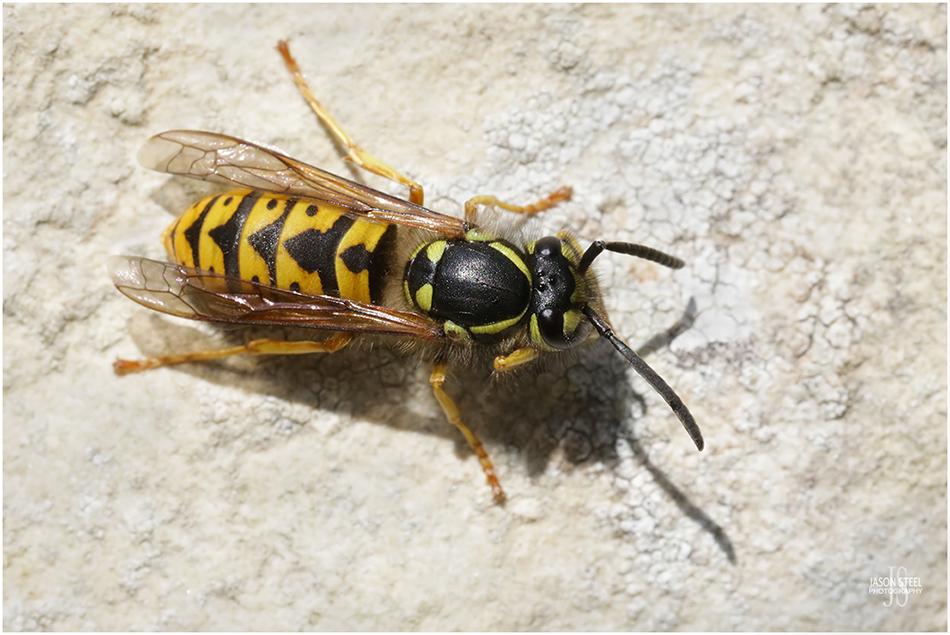
German Wasp, photographed on the wall of a building in Kent, 31st August 2022.
German Wasp / European Wasp - (Vespula germanica)
The German Wasp is the second of the Vespula species found in the UK. Adults usually grow to around 13mm in length, with 12-17mm being the typical range. As with the Common Wasp the queens are larger and can reach around 20mm in length. The majority of Vespula germanica nests are built beneath the surface of the soil. There remains a large proportion of nests though that are built in human buildings, especially attics and garden sheds.
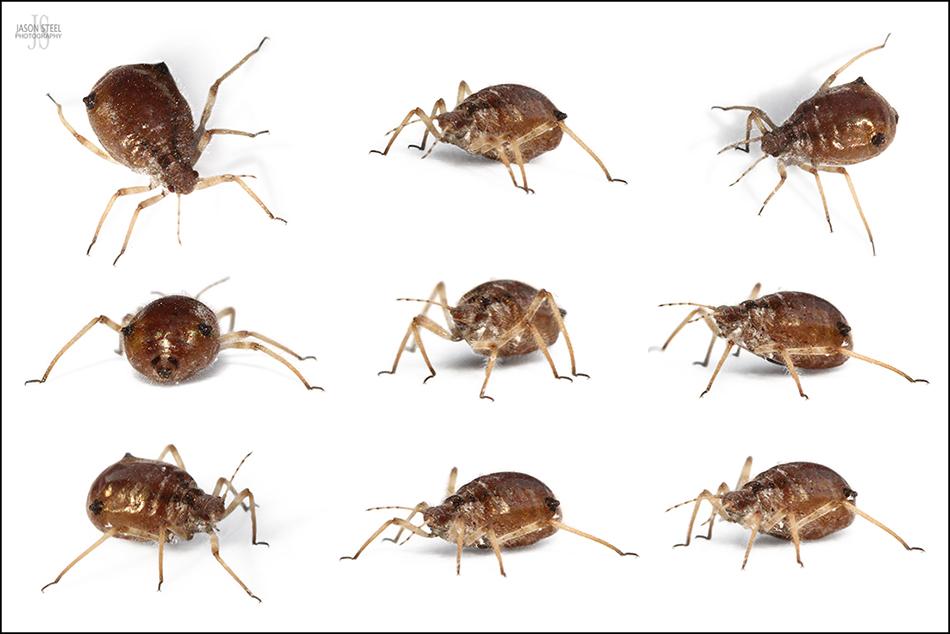
2mm Conifer Aphid, found at the end of my SE London garden, 10th May 2020
Conifer Aphid (Cinara species)
In the UK there are at least 600 different species of aphid. Many are extremely difficult to identify down to species level. A few species of aphid can be found on a variaety of hose plants but most aphids are quite specific and are confined to one or two host plant species.
There are around 55 Conifer Aphid species, Cinara sp, in Europe and these species range in size from just under 2mm to 6mm. The larger species can sometimes be mistaken for ticks at 6mm in length. Conifer Aphids can be found feeding on the roots, branches or foliage of conifer trees. The males of some species are winged whilst others are wingless. Conifer Aphids can be accidentally introduced into homes during December hidden on Christmas Trees. These aphids cannot survive long off the tree so although they may initially seem to spread they cannot breed in the home and once the tree is removed the aphids around your home will die off shortly after. They're also incapable of biting humans so they are nothing to fear and do not need to be controlled. In fact the only harm these Conifer Aphids can cause indoors is when they are squashed as this can stain carpets or walls.
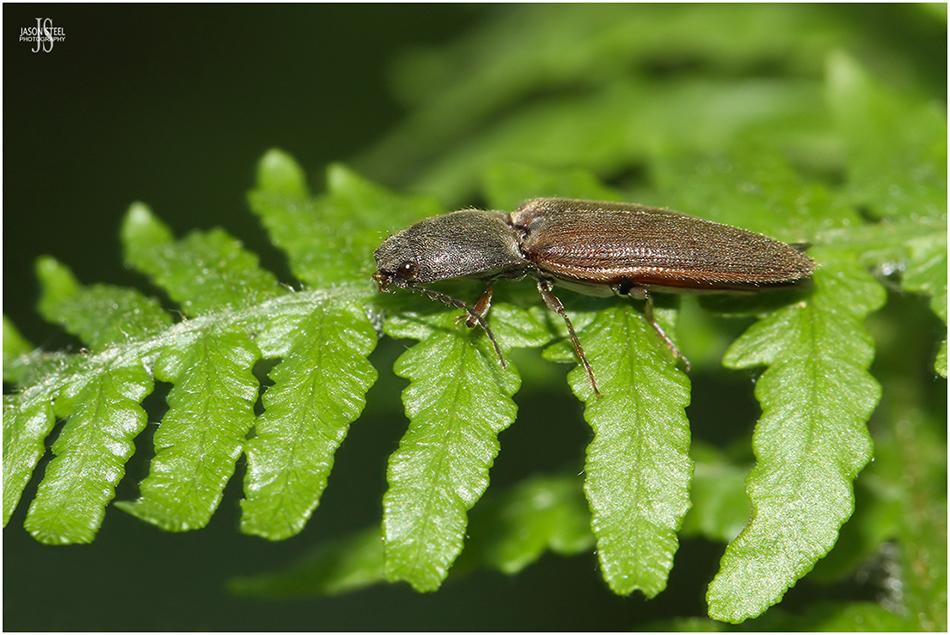
13mm Click Beetle (probably Athous haemorrhoidalis). One of many found on foliage in ancient woodland in North Kent, 14th May 2020
Click Beetle (Elateridae)
In the UK there are 41 genus of Click Beetles containing 73 different species and range in size from 3-30mm in length. Many of these are generally very difficult to identify in the field. All species of Click Beetle have the ability to launch themselves into the air with a loud and clearly audible "click" sound. They can some times reach in excess of 30cm with this action which serves to evade predators or to self-right if they find themselves upside down. The larvae of around 50% of Click Beetles develop underground and feed on roots of plants. They may take 3-5 years to develop and are considered as pests by both gardeners and farmers. Whilst feeding on the roots of plants they can cause extensive damage to plants, flowers and crops. The larvae of the genus Athous, Melanotus, Agriotes and Adrastus are the most damaging to plants and are known as fire-worms. The larvae of the other 50% of species of Click Beetle live in rotting wood and behind loose tree bark and are predatory, feeding on small invertebrates that share their habitat.
Athous haemorrhoidalis grows to around 15mm in length and is one of the most common species and is often found in hedgerows and meadows. They are active both day and night and will readily fly to travel from plant to plant where they can be observed basking on leaves. Adults can usually be found from April to the end of July.
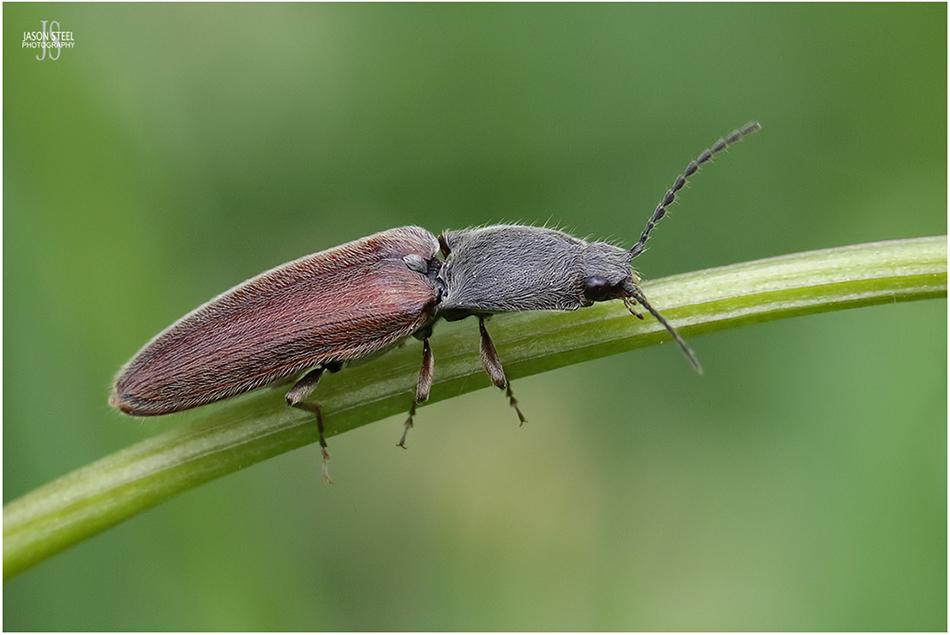
15mm Click Beetle (probably Athous haemorrhoidalis) in a grass meadow in North Kent, 11th June 2021
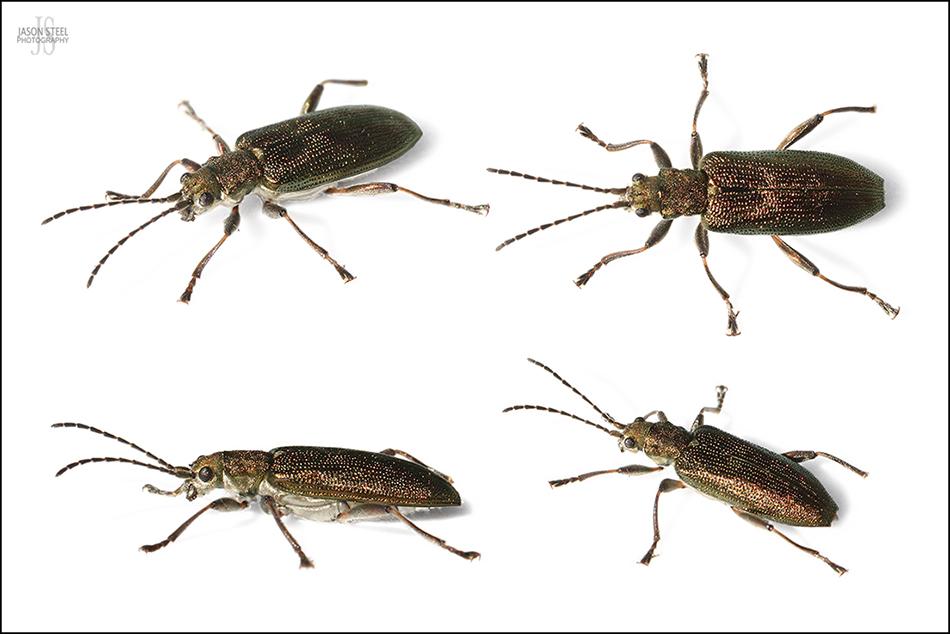
8mm Reed Beetle (Donacia cf semicuprea). Found on low vegetation in SE London, 28th June 2020
Reed Beetles (Chrysomelidae)
In the UK there are 3 genus of Reed Beetles (Donacia, Macroplea and Plateumaris) containing 21 different species and range in size from 5-15mm in length. Most of these are very difficult to identify in the field. Reed Beetles are riparian and both adult and larval stages are associated with marginal and aquatic vegetation. These diurnal beetles emerge in the spring and can be found until the end of autumn. In hot weather they are very active and can often be found in large groups with different species regularly found in the same location. Reed Beetles are usually bronze, green or copper in colour and many are bi-coloured. They have a heavily microsculptured upper surface with a metallic sheen.
Reed Beetle (Donacia semicuprea).
Donacia semicuprea are a common and widespread species of Reed Beetle found across the southern half of the UK. Adult beetles feed on the leaves of Reed Sweet-grass (Glyceria species, particularly Glyceria maxima) and grow to around 6-9mm. The larvae are aquatic and feed on the roots of the same plant. Eggs are laid from May to August in batches of 20-30 below the water's surface on Reed Sweet-grass. The life-cycle of this species takes three years to complete.
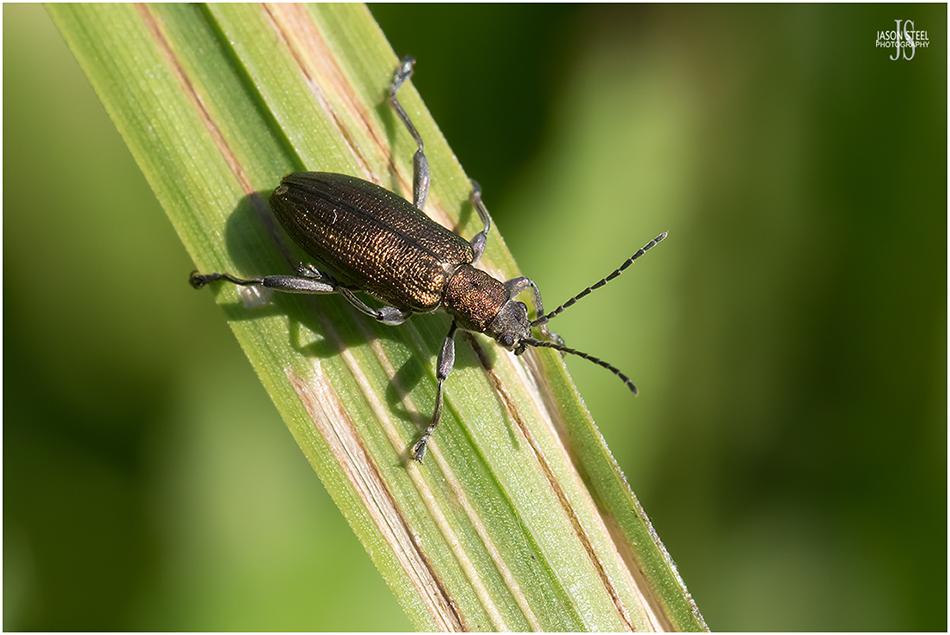
One of many Reed Beetles (Donacia cf semicuprea) found on reeds at the edge of a lake in SE London, 3rd June 2021
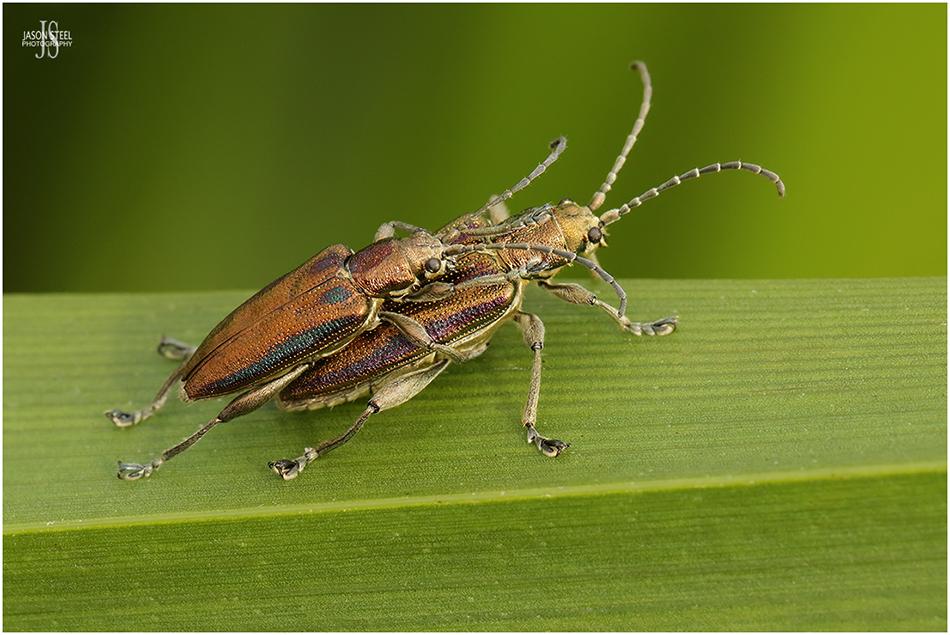
Mating Reed Beetles (Donacia marginata) found at Pevensey Levels, Sussex, 17th September 2021.
Reed Beetle (Donacia marginata)
Donacia marginata are a golden-bronze, rainbow coloured Reed Beetle growing to around 8-10mm. Like other Reed Beetles they are usually found on emergent vegetation at the edge of fresh-water and wetland habitats, especially reedbeds. It is believed that Donacia marginata are monophagous, meaning they feed on just one specific type of host plant, Branched bur-reed (Sparganium erectum), whilst some other Reed Beetles may feed on a variety of reeds and other wetland species of plant. Donacia marginata are considered widespread and locally common, especially in southern England.
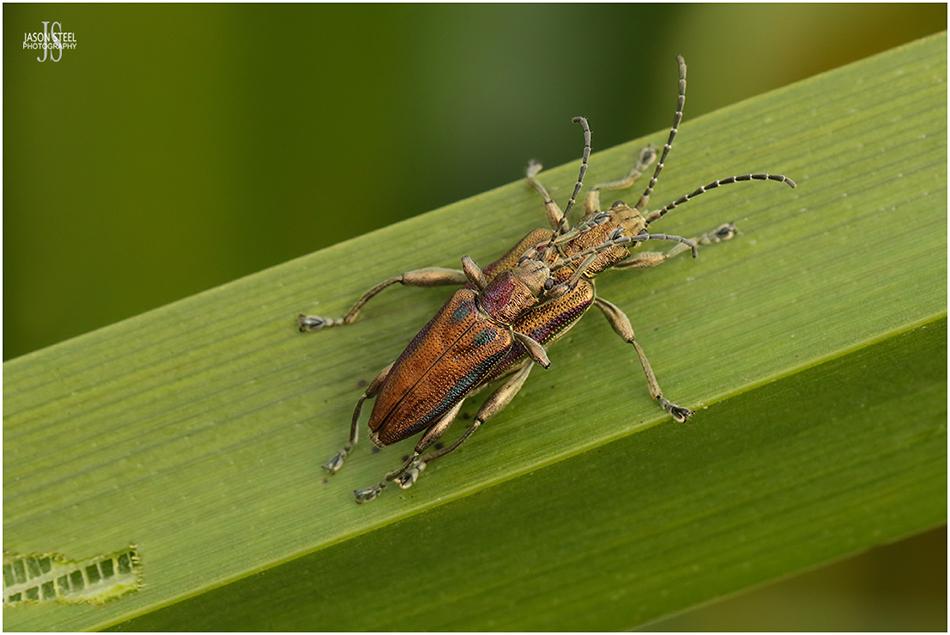
Mating Reed Beetles (Donacia marginata) found at Pevensey Levels, Sussex, 17th September 2021.
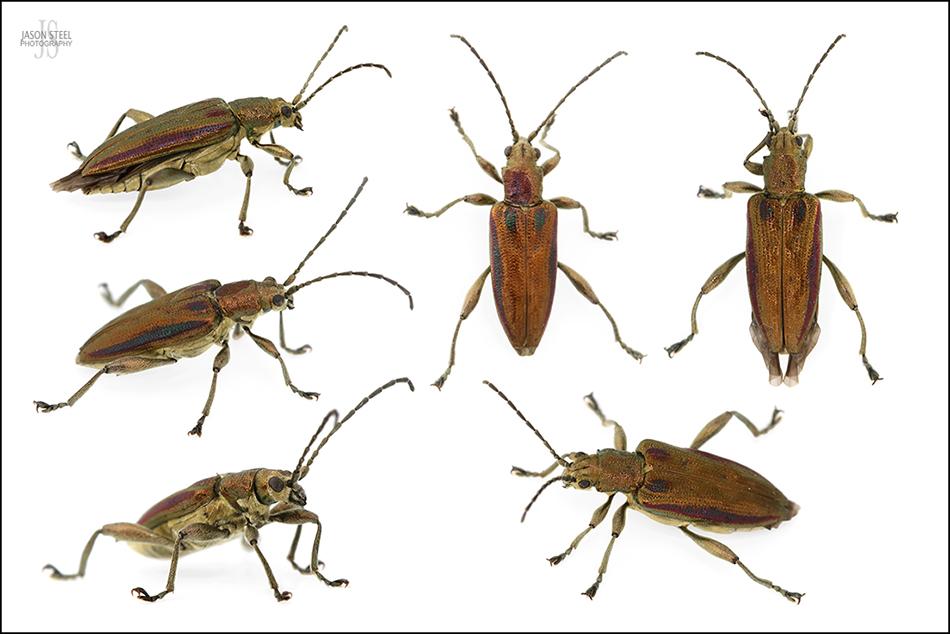
Male and female Reed Beetles (Donacia marginata)
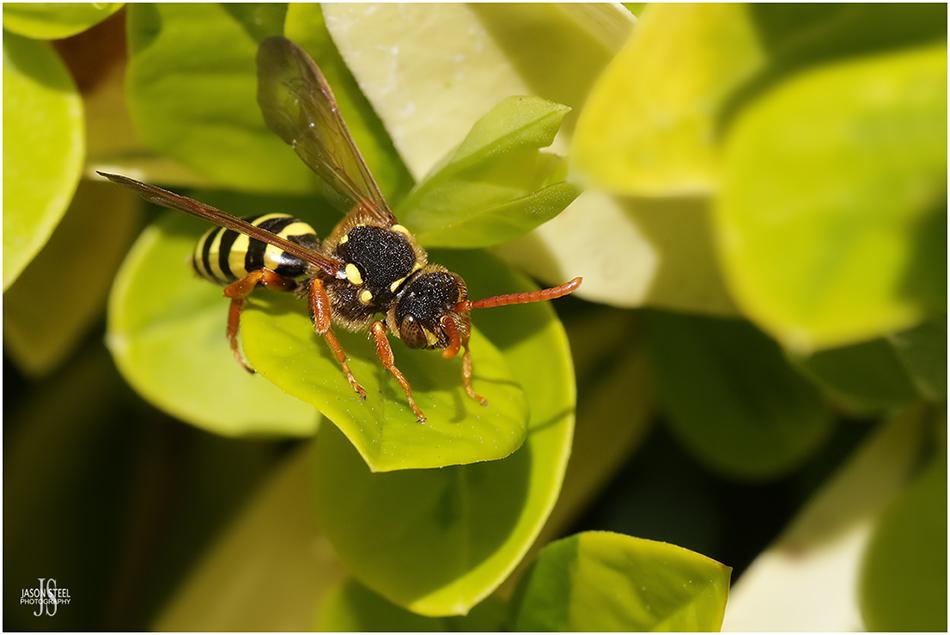
Female Gooden's Nomad Bee (Nomada goodeniana). Found in my garden in SE London, 4th April 2021
Gooden's Nomad Bee (Nomada goodeniana)
In the UK there are 30-40 species of Nomad Bee that can be found in the British Iles. Many can easily be mistaken for wasps. Most display yellow and black markings or have reddish / black bodies. Nomad Bees are 'cleptoparasite' or 'cuckoo' species. They invade and take over the nest of the target species and their offspring then feeds off the food supplied by the host species that was intended for its own offspring.
Nomad Bees lay their eggs concealed in the walls of the nests of other bees, often Andrena species, Mining Bees, whilst the host is absent from the nest. The Mining Bee will then lay its eggs in the nest burrow and leave provisions before sealing up the nest. The large-jawed grubs of the Nomad Bee will destroy the grubs of the Mining Bee and eat the provisions left for them.
Gooden's Nomad Bees are one of the largest of the Nomad Bees and prey particularly on the Buffish Mining Bee, Andrena nigroaenea, which usually makes its burrows in bare earth. Other known hosts include the Grey-Patched Mining Bee, Andrena nitida, and the Chocolate Mining Bee, Andrena scotica, and the Cliff Mining Bee, Andrena thoracica.
Gooden's Nomad Bees can be sexed by counting the segments on the antennae. Females have 12 segments and males have one more at 13. The males also have dark markings on the upper surface of the antennae. Gooden's Nomad Bees can be seen in spring and in lower numbers at the end of summer. This species is fairly common with most records coming from the south of England.
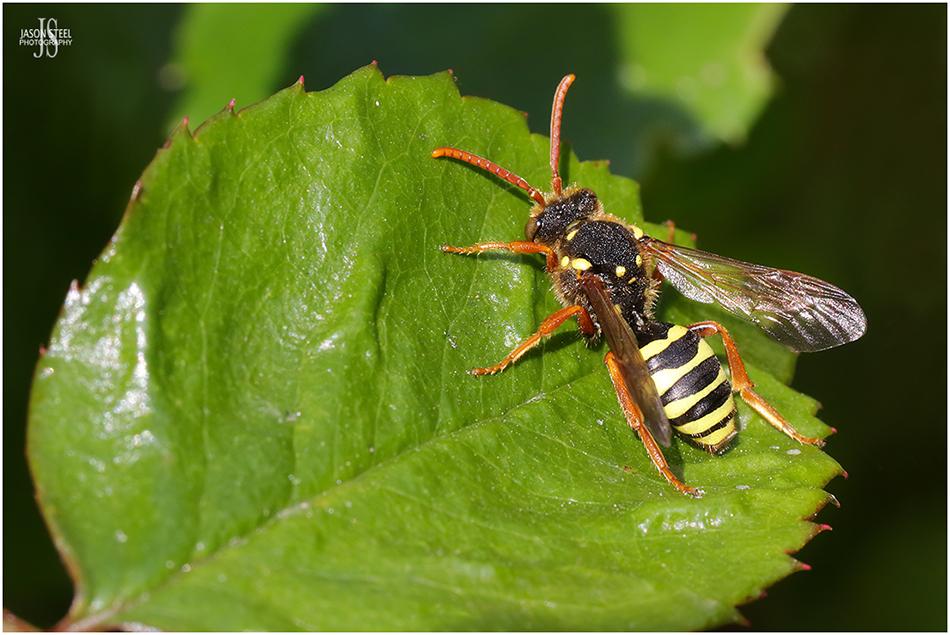
Female Gooden's Nomad Bee (Nomada goodeniana). Found in my garden in SE London, 4th April 2021
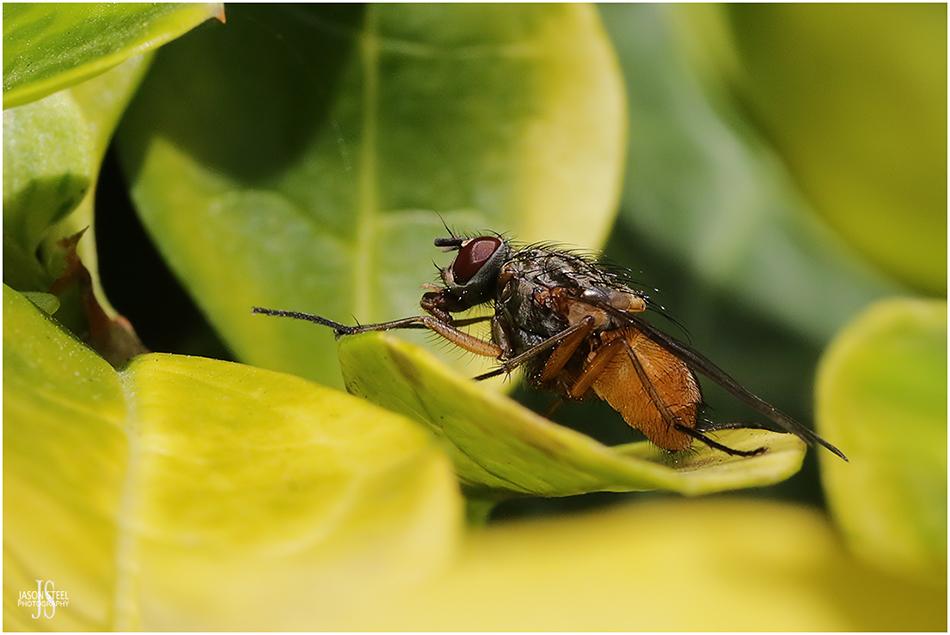
Orange-Bodied House Fly (Phaonia species). Found in my garden in SE London, 4th April 2021
Orange-Bodied House Fly (Phaonia species)
In the UK there are several very similar species of Phaonia, Orange-Bodied House Fly. These flies are common and widespread across the UK and are frequently seen from March to November in wooded areas. Orange-Bodied House Flies breed several times a year and females lay their eggs in rotting leaves and wood, decaying matter and carrion. Phaonia species have a distinctive bulge to the outside edge of their wings which help to separate them from other genres of fly.
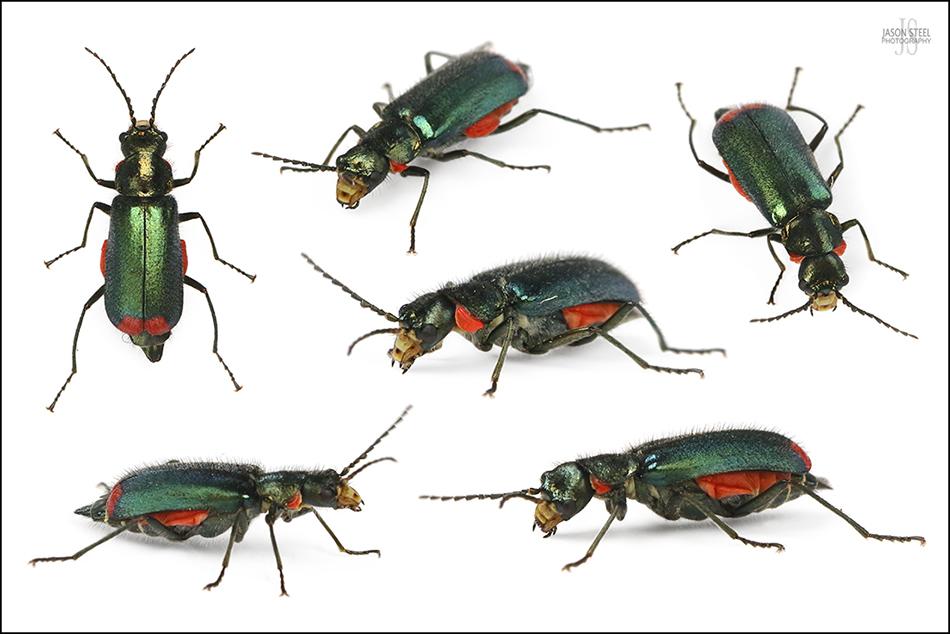
6mm Common Malachite Beetle, found at the edge of a grass meadow in Bexley, SE London, 8th June 2021.
Common Malachite Beetle / Red-Tipped Flower Beetle (Malachius bipustulatus)
The Common Malachite Beetle grows to around 5-6mm in length and is common and widespread in England and Wales. They are often abundant on sunny days in parks and fields where there are trees and shrubs. This predatory beetle hunts small pollen-feeders on flowers and grasses and will also feed on pollen and nectar itself. Adult beetles can usually be seen from April / May until July / August. The larvae are also predatory and feed on slugs, smaller insects, other larvae and eggs. Both male and female Malachite Beetles have bright red sacs, named cocardes, that can emit defence odours to deter predators when caught.
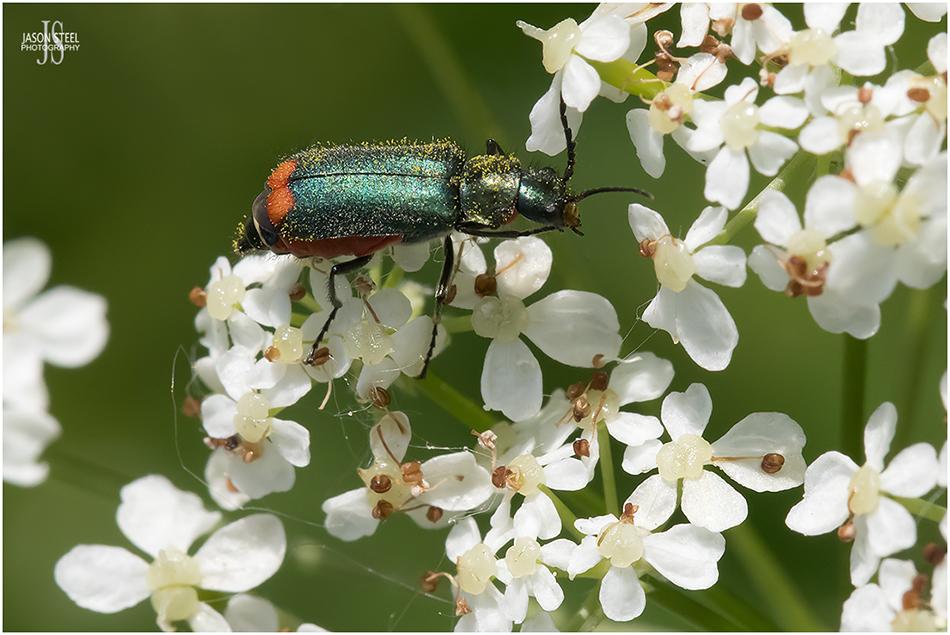
Common Malachite Beetle found on the flowers of Cow Parsley at the edge of a grass meadow in Bexley, SE London, 3rd June 2021.
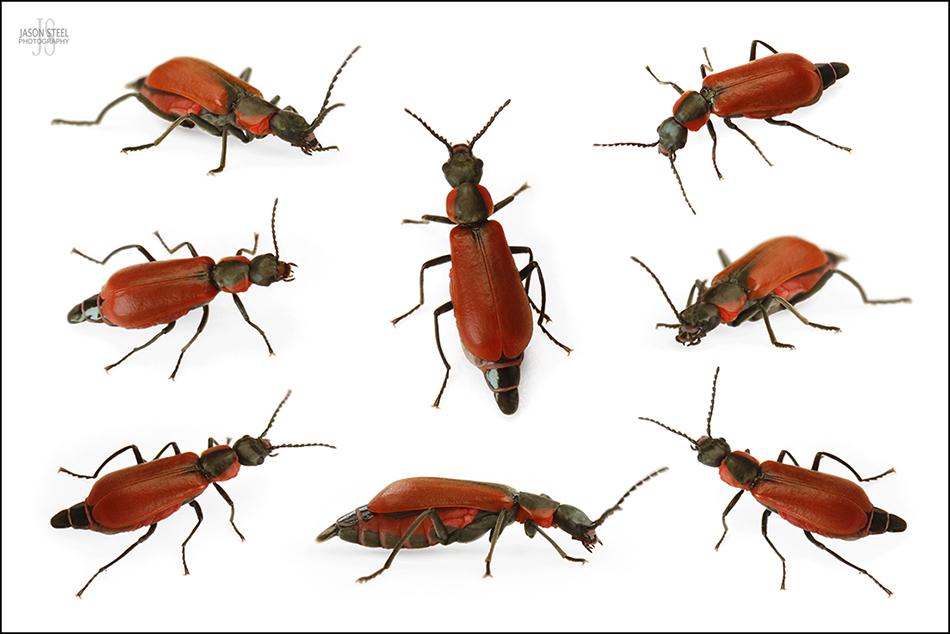
4mm Soft-Winged Flower Beetle, found in large numbers on a Goat Willow Tree (Salix caprea) at Swanscombe Marshes, 30th August 2021.
Red Malachite Beetle / Soft-Winged Flower Beetle - (Anthocomus rufus)
This small and brightly coloured species of predatory beetle is usually associated with wetland habitats. Adults can be seen from July to October and where they are found they often gather in large numbers on marginal plants, especially reeds and rushes, or in swarms. Adults of both sexes have wing-cases slightly shorter than their bodies and both sexes grow to around 4-5mm in length. Although this beetle hunts small invertebrates it also feeds on the flowers of reeds and rushes too. This species is quite distinctive in the UK and common in the southern half of the Britain.
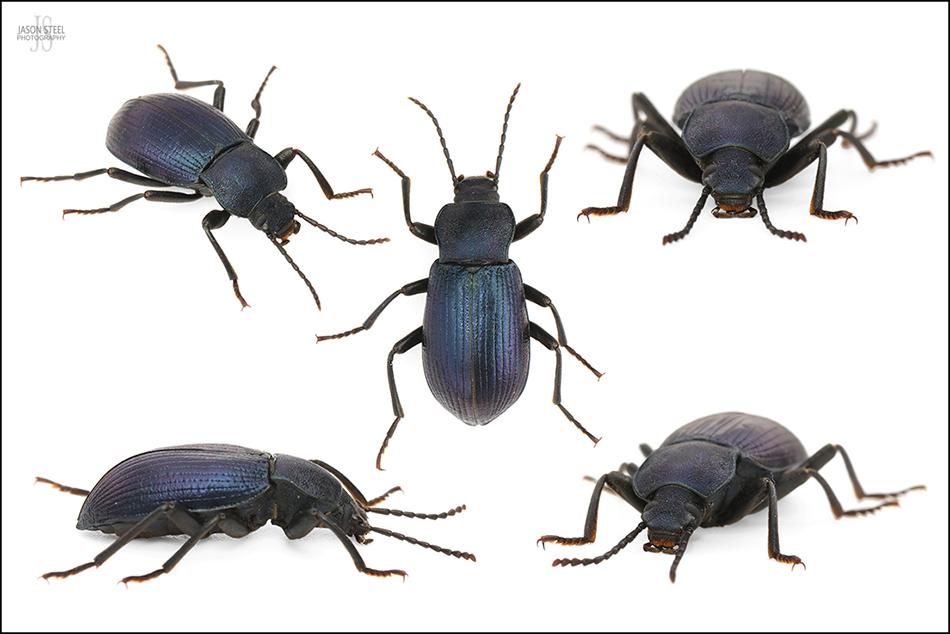
20mm Darkiling Beetle, found under a damp log at Swanscombe Marshes, Kent, on the edge of the River Thames, 26th June 2021.
Blue Darkling Beetle (Helops caeruleus)
This nationally scarce and flightless Darkling Beetle grows to around 20mm in length and has a scattered distribution, confined mainly to south and eastern coastal sites in England. Helops caeruleus is metallic blue / black, nocturnal beetle that's usually found near the coast in the decaying wood of dead and dying trees. It has also been recorded in compost heaps, as well as under old railway sleepers.
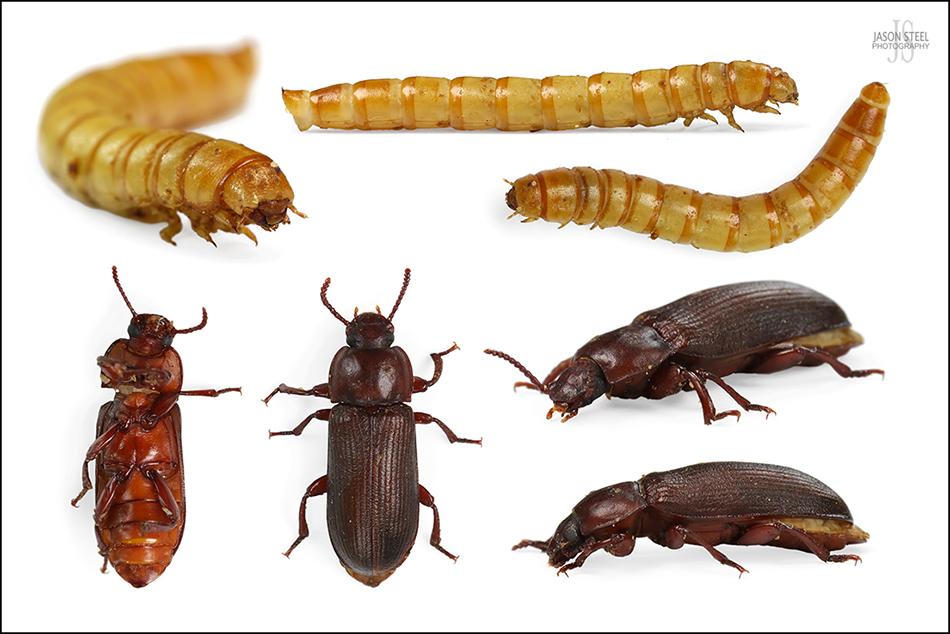
Captive-bred Yellow Mealworm Beetles, in adult and larval stages. 26th December 2021
Yellow Mealworm Beetle (Tenebrio molitor)
Most people are familiar with Mealworms as millions are captive-bred each year to be used as food for both birds and for the exotic pet trade and as bait for fishing. But not everyone realises that Mealworms are the larval stage of the Mealworm Beetle. In the UK we have two very similar species of Mealworm Beetle, the Yellow Mealworm Beetle, Tenebrio molitor, and the less common Dark Mealworm Beetle, Tenebrio obscurus. Both are found living in the wild and both are used as pet food, although Tenebrio molitor is far more common.
Tenebrio molitor and Tenebrio obscurus are members of the Tenebrionidae family of Darkling Beetles. Although both species are very similar Tenebrio molitor tend to have a shiny appearance when compared to the dull appearance of Tenebrio obscurus. The young larvae of both species are initially white. The larger larvae of the Yellow Mealworm Beetle are a honey-yellow colour whilst the larger larvae of the Dark Mealworm Beetle are brown in colour.
Tenebrio molitor are widespread and locally common in the UK. Adult beetles vary in colour from light brown to reddish-brown, or to a dark, almost black-brown, and grow to a body-length of around 12-18mm. In the wild adult beetles are active from May to September. They are attracted to light and it's not uncommon for them to be seen flying around houses at night. It is believed that the Yellow Mealworm Beetle originated from the Mediterranean area before being accidentally distributed by human activities. Usually Mealworm Beetles live for 2-3 months but some have been known to live for as long as 2 years.
The larvae reach lengths of around 20-30mm and will eat almost anything including decaying matter, grains, crops, plants, animal matter and carrion. They have even been found in birds nests feeding on bird droppings. Mealworms are scavengers and to farmers Mealworms are often considered a pest species to stored grains and other crops. They are one of the largest insects known to infest stored food. Mealworms are rich in protein and low in fat and in some areas, especially around Asia, it is common for dried Mealworms to be served by the bowlful for human consumption.
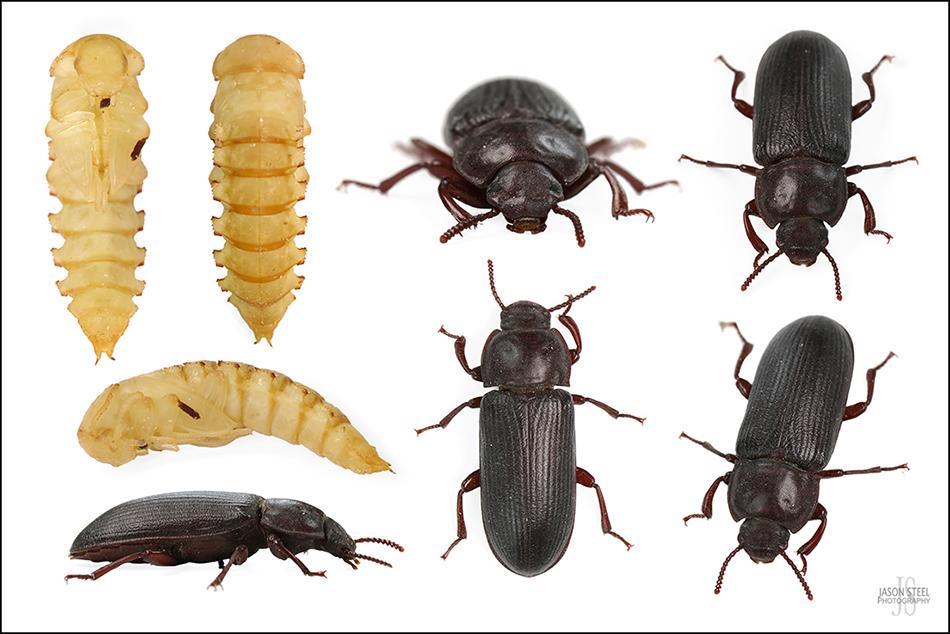
Captive-bred Yellow Mealworm Beetles, in adult and pupal stages. 29th December 2021
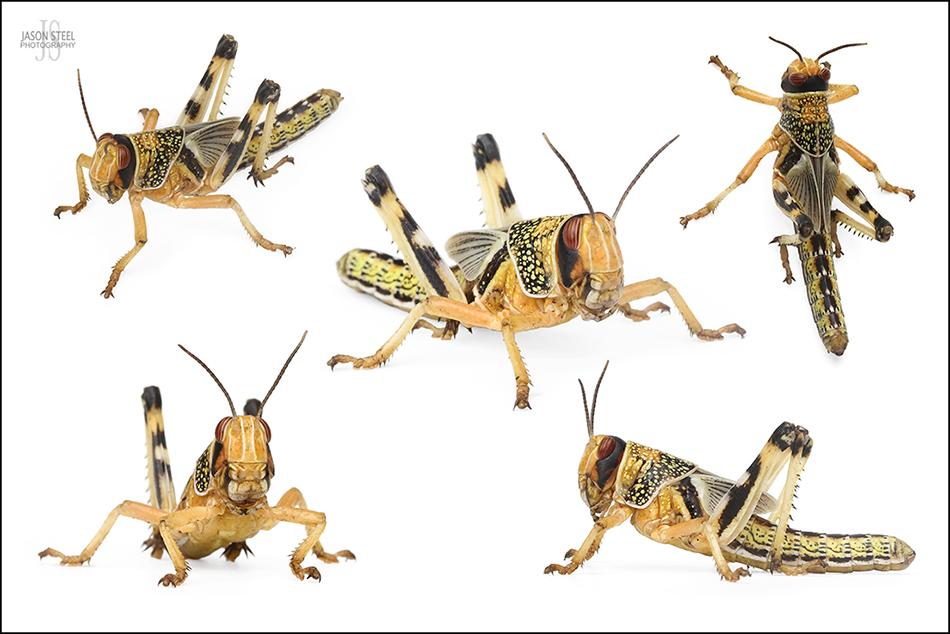
30mm captive-bred Desert Locust hopper, in gregarious form.
Desert Locust - (Schistocerca gregaria)
The term "locust" is usually used to describe species of gregarious grasshopper. Whilst most grasshoppers live solitary lives some species, known as locusts, have the ability to undergo metabolic changes that lead to the forming of swarms of locust under the right circumstances. In warmer and drier parts of the world, such as Africa and Asia, locusts, that are usually solitary, can breed in very high numbers in ideal conditions. The Desert Locust responds faster ,and more dramatically, to good times than any other species on the planet. Some sources claim that eggs of the Desert Locust can remain buried in the ground for decades, waiting for such ideal conditions to trigger mass synchronised hatching.
In ideal conditions the locust population will continue to grow and a succession of favourable seasons will allow the locust population to spread until the locusts at the outer edge of the population are forced into marginal, unfavourable areas, where food is sparse. In these overcrowded conditions some of the nymphs will undergo a metabolic change and their offspring will hatch as the gregarious form of the locust. The gregarious form of the Desert Locust will develop shorter legs and longer wings, suited to flying long distances. If the hot conditions continue for long enough, and overcrowding is sufficiently high within the colony, most of the locusts will shift to the gregarious form. Adult winged specimens release a pheromone that alerts others in the group that the time has come to take flight and search for new feeding grounds.
Swarms of locusts quickly form and take flight. Locusts always travel in the direction of the wind, and allow the winds to carry them great distances. This not only saves energy but inevitably takes them to greener pastures. Eventually the wind will carry them to areas where high pressure meets low pressure, and where this happens moisture will form in the air, and rain will ensue. And where there is rain, there is vegetation, or food for the locusts. Swarms can travel over 100 miles per day and can fly at heights of 2000 metres above sea level. Swarms of locusts meet in flight and the numbers of locusts can reach billions of specimens, forming a plague. Plagues of locusts will eat all vegetation in their path and leave an incredible trail of total destruction. Plagues of locust consist of billions of specimens and these swarms can fly in groups 40 miles wide. In biblical times the threat of plagues of locusts is often recalled, as the people refused to harken unto the commandments of God. LINK
In 2003-2005 the Desert Locust plagues became a huge problem in Africa. Unusually high levels of rain for just a couple of days in 2003 created conditions ideal for several generations of Desert Locust to flourish for six months. By early 2004 huge swarms of Desert Locust had formed and were causing terrible destruction to agricultural land in Morocco and Algeria. By the summer of 2004 plagues of locusts had formed and in November 2004 they migrated over the continent and were causing destruction of crops in Egypt, Jordan and Israel, for the first time in 50 years. One of the swarms in Morocco was measured at over 140 miles in length. Cooler temperatures and a lack of rain slowed breeding down in the populations sufficiently for pest-control agencies to bring the plague under control. The cost of controlling this plague was estimated at $400 million US dollars, and the damage to crops was estimated to be around $2.5 billion US dollars. Desert Locusts are vivacious feeders and each Desert Locust can consume its own weight in food every day.
The Desert Locust can have 2-5 generations each year, depending on conditions. Young locusts, known as hoppers, are flightless. they can detect the smell of sprouting grass shoots from some distance and follow the scent to new feeding grounds. The gregarious form of the Desert Locust looks different in colour to the solitary form as a nymph, and in the past these two forms were thought to be two different species. The gregarious form, pictured above, is yellow and black / brown, whilst the solitary form is dull green / grey in colour. Adults have shorter wings and longer legs in the solitary form. Gregarious forms kept in low numbers will once again give birth to offspring of the solitary form.
After copulation the adult female lays her eggs in batches of around 100 eggs. The eggs are surrounded by foam and buried in the ground, where they may take two weeks to hatch, or on occasion much much longer. The nymphs take up to six months to mature in less than ideal conditions. However when conditions are perfect the maturation is accelerated and may take place as quickly as two weeks. Adult specimens reach around 70-80mm in length and the life-span of a Desert Locust varies from 3-6 months.
Whilst the Desert Locust is not established in the UK it is a favoured species to be captive-bred as a food source for the exotic pet-trade. Because this species is bred in large numbers in close proximity the types sold in pet shops are always the gregarious form rather than the solitary form. It's not unusual for unwanted specimens to be deliberately released so occasional specimens are sometimes found in the wild here in the UK. In both 1869 and 1954 large swarms of Desert Locust, believed to have come from Northwest Africa, have found there way to the UK. Climate change is threatening much of the world with a possible increase in plagues of locust. In 2020 Britain granted an aid package of £18 million to help fight plagues of locusts causing damage to crops in Africa. LINK
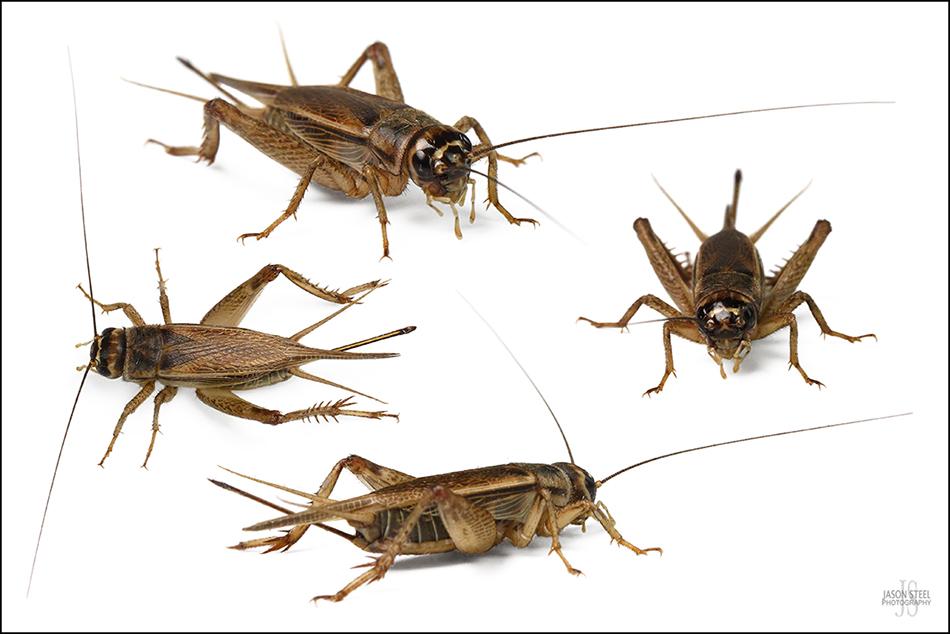
21mm female House Cricket (Acheta domesticus)
House Cricket - (Acheta domesticus)
The House Cricket is a medium-sized, and mainly nocturnal, cricket growing to around 17-21mm in body-length. Females can be identified by their long ovipositor between the two rear appendages, which can reach 12mm itself. Adult specimens have long hind wings which are often shed. Originally from Asia this species was used as the industry standard food source by the pet trade for reptile and tarantula species throughout the world from 1950 to around 2000. With their soft bodies they were suitable prey for many species. Because of their popularity in the pet trade House Crickets could also be found living in the wild as an introduced species in many countries across Europe, Asia and America. Their tolerance to cold temperatures allowed this species to flourish in many countries including the UK, where overwintering occurred in adult form in houses, buildings, sheds and other sheltered locations.
In 2002 the "Cricket Paralysis Virus" spread rapidly throughout Europe and wiped out huge numbers of House Crickets both in captivity and in the wild. This helped to bring the species under control in countries where they were non-native but it also left many reptile keepers without a food source for their pets. The CPV had the same effect in 2010 in the USA and the pet-food industry quickly shifted to using the Jamaican Field Cricket (Gryllus assimilis) as a replacement due to its immunity to the virus.
House Crickets are still farmed in great numbers not only for the pet trade but also for human consumption, providing a healthy and sustainable source of protein and omega-3. Dry roasting is the most common method of preparation, although deep-frying is also popular.
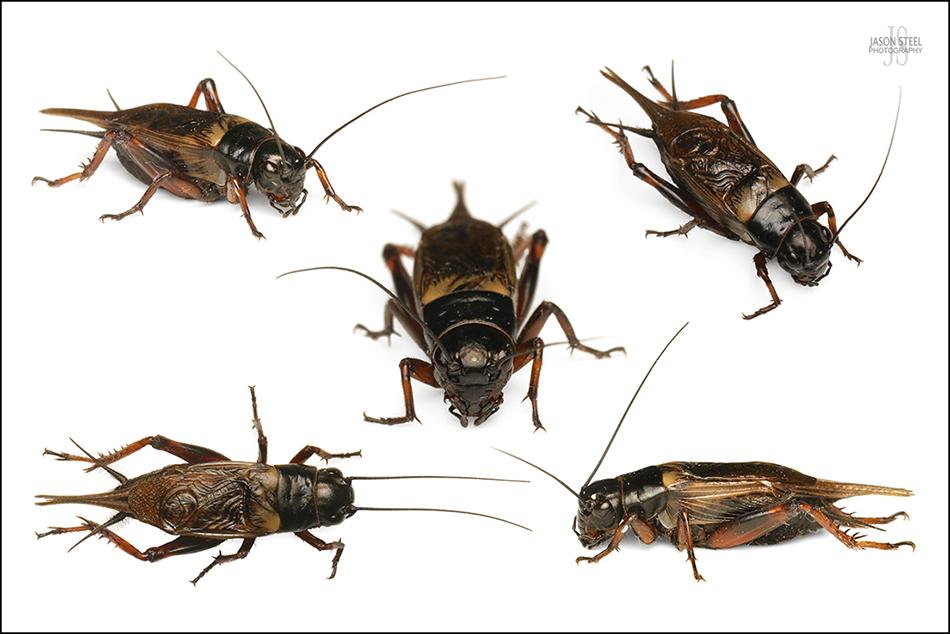
22mm male Jamaican Field Cricket (Gryllus assimilis)
Jamaican Field Cricket / Silent Brown Cricket - (Gryllus assimilis)
The Jamaican Field Cricket, Silent Brown Cricket, or Common Black Field Cricket, as it is also known, is native to the West Indies, Southern USA, South American and Mexico. In Jamaica they are also known as the Banana Cricket. Jamaican Field Crickets are generally found in weed-filled fields, roadside verges, gardens and rough pasture. Despite their name the male of these crickets can be quite vocal. These are large and stocky crickets and adults grow to around 30mm in length and can vary from brown to black in colour. In their native range this species can be a pest to farmers of some fruits, vegetables and other crops. They are particularly damaging to Eucalyptus plants.
In Europe and the UK these crickets are extensively farmed and captive-bred to serve as a source of protein-rich food for the reptile pet trade. In the UK alone millions of these crickets are captive-bred for this purpose every month. These crickets breed and grow at an incredible rate. From hatching to adult these crickets are ready to reproduce in just 35-42 days in ideal conditions. This species often finds its way into the wild, either by deliberate release or accidental escape. This species is a better choice for use in the UK as they don't have the cold tolerance of the previously used House Cricket (Acheta domesticus) and probably can't survive our winters. This makes them less of a threat to our native UK species should they escape into the wild. There are a few other reasons why the Jamaican Field Cricket is popular as a food source for the pet trade. One being its immunity to "Cricket Paralysis Virus". A virus that has caused major issues for other species of cricket previously bred for the pet trade. Although the Jamaican Field Crickets / Silent Brown Crickets aren't silent as their name suggests, they do have a fairly quiet chirp which is a of a pleasant tone. And these crickets are quite slow moving and more inclined to walk rather than jump, making them easy prey for even the slowest of pet reptiles.
All Photographs on this page were taken using the Canon 7D camera and the Canon 100mm 2.8L IS lens.